OvisLink NPOWER Hi-Power Wireless-N PoE AP Router User Manual AirLive N Power Manual
OvisLink Corp. Hi-Power Wireless-N PoE AP Router AirLive N Power Manual
OvisLink >
user manual

N.Power
Hi-Power Wireless-N PoE AP
Router
Use
r
’s Manual
US Version
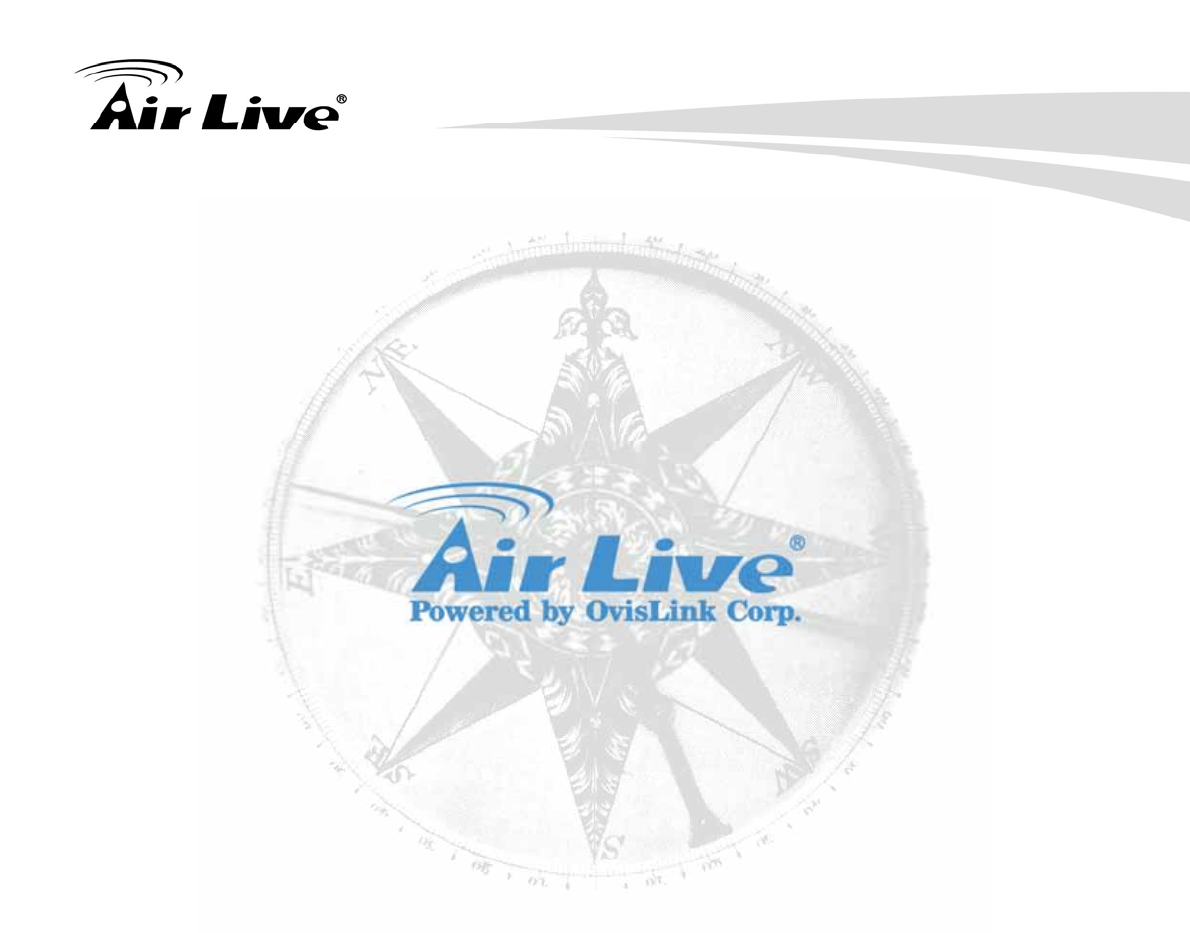
Copyright and Disclaimer
AirLive N.Power User’s Manual
Copyright & Disclaimer
No part of this publication may be reproduced in any form or by any means, whether
electronic, mechanical, photocopying, or recording without the written consent of OvisLink
Corp.
OvisLink Corp. has made the best effort to ensure the accuracy of the information in this
user’s guide. However, we are not liable for the inaccuracies or errors in this guide.
Please use with caution. All information is subject to change without notice
All Trademarks are properties of their respective holders.

Copyright and Disclaimer
AirLive N.Power User’s Manual ii
FCC Statement
Federal Communication Commission Interference Statement This equipment has been
tested and found to comply with the limits for a Class B digital device, pursuant to Part 15 of
the FCC Rules.
These limits are designed to provide reasonable protection against harmful interference in
a residential installation. This equipment generates, uses and can radiate radio frequency
energy and, if not installed and used in accordance with the instructions, may cause
harmful interference to radio communications. However, there is no guarantee that
interference will not occur in a particular installation. If this equipment does cause harmful
interference to radio or television reception, which can be determined by turning the
equipment off and on, the user is encouraged to try to correct the interference by one of the
following measures:
z Reorient or relocate the receiving antenna.
z Increase the separation between the equipment and receiver.
z Connect the equipment into an outlet on a circuit different from that to which the
receiver is connected.
z Consult the dealer or an experienced radio/TV technician for help.
FCC Caution
Any changes or modifications not expressly approved by the party responsible for
compliance could void the user's authority to operate this equipment.
This device complies with Part 15 of the FCC Rules. Operation is subject to the following
two conditions: (1) This device may not cause harmful interference, and (2) this device
must accept any interference received, including interference that may cause undesired
operation. For product available in the USA/Canada market, only channel 1~11 can be
operated. Selection of other channels is not possible.
This device and its antenna(s) must not be co-located or operation in conjunction with any
other antenna or transmitter.
IMPORTANT NOTE
FCC Radiation Exposure Statement:
This equipment complies with FCC radiation exposure limits set forth for an uncontrolled
environment. This equipment should be installed and operated with minimum distance
20cm between the radiator & your body.
© 2011, OvisLink Corporation. All rights reserved.

Table of Contents
i AirLive N.Power User’s Manual
Table of Contents
1. Introduction................................................................................................1
1.1 Overview..............................................................................................1
1.2 Firmware Upgrade and Tech Support..................................................1
1.3 Features...............................................................................................2
1.4 Operation Modes .................................................................................3
1.4.1 Router Mode................................................................................................3
1.4.2 AP mode ......................................................................................................3
1.4.3 Client Mode .................................................................................................4
1.4.4 WDS Bridge Mode.......................................................................................4
1.4.5 WDS Repeater Mode...................................................................................5
2. Installing the N.Power ...............................................................................7
2.1 Before You Start...................................................................................7
2.2 Package Content .................................................................................7
2.3 Knowing your N.Power ........................................................................7
2.4 Hardware Installation ...........................................................................8
2.4.1 Passive PoE Installation ............................................................................10
2.4.2 Wall Mount Installation............................................................................... 11
2.5 LED Table ..........................................................................................12
2.6 Restore Settings to Default................................................................12
3. Configuring the N.Power.........................................................................13
3.1 Important Information......................................................................13
3.2 Prepare your PC .............................................................................13
3.3 Introduction to Web Management...................................................14
3.3.1 Getting into Web Management..................................................................14
3.3.2 Web Menu Structure..................................................................................15
3.4 Configuration Wizard.......................................................................16
3.5 Change Operation Mode.................................................................17
3.6 WPS (WiFi Protected Setup)...........................................................17
3.6.1 AP and Router Modes...........................................................................18
3.6.2 Client Mode...........................................................................................20
4. Configuration: Router Mode .................................................................22
4.1 Application for Router Mode...............................................................22

Table of Contents
AirLive N.Power User’s Manual ii
4.2 Internet Setting Menu.........................................................................22
4.2.1 Setup Wizard.............................................................................................23
4.2.2 WAN Setting ..............................................................................................24
4.2.3 Virtual Server.............................................................................................25
4.2.4 DMZ...........................................................................................................26
4.2.5 URL Filtering..............................................................................................27
4.2.6 MAC Filtering.............................................................................................27
4.2.7 IP Filtering .................................................................................................28
4.2.8 DDNS ........................................................................................................28
4.2.9 Static Route ...............................................................................................29
4.3 FTP Function .....................................................................................29
4.4 Wireless Settings Menu .....................................................................32
4.4.1 Regulatory Domain....................................................................................32
4.4.2 Multiple SSID.............................................................................................33
4.4.3 Channel .....................................................................................................33
4.4.4 Wireless Security.......................................................................................34
4.4.5 Access Control...........................................................................................35
4.4.6 Bandwidth Control .....................................................................................35
4.4.7 Associated Client .......................................................................................36
4.4.8 Advanced Settings.....................................................................................37
4.4.9 WMM Settings ...........................................................................................39
4.4.10 WDS Settings (Repeater) ........................................................................41
4.4.11 WPS Settings...........................................................................................42
5. System Configuration and Status Menu................................................45
5.1 Menu Structure ..................................................................................45
5.2 LAN Interface Setup ..........................................................................46
5.2.1 DHCP Settings ..........................................................................................46
5.2.2 Add DHCP Static Lease Client...................................................................47
5.3 Time Settings .....................................................................................47
5.4 Password Settings .............................................................................48
5.5 Power Saving (Green AP)..................................................................48
5.6 Firmware Upgrade .............................................................................49
5.7 Configuration Save and Restore........................................................50
5.8 Factory Default ..................................................................................50
5.9 Status Menu.......................................................................................50
5.9.1 Device Information.....................................................................................50
5.9.2 Statistic ......................................................................................................51
5.9.3 Client Table................................................................................................52
5.9.4 LOG...........................................................................................................52
6. AP Mode....................................................................................................53

Table of Contents
iii AirLive N.Power User’s Manual
6.1 Application for AP Mode.....................................................................53
6.2 Wireless Settings ...............................................................................53
6.2.1 Multiple SSID.............................................................................................53
6.2.2 Channel .....................................................................................................54
6.2.3 Wireless Security.......................................................................................55
6.2.4 Access Control...........................................................................................55
6.2.5 Associated Client .......................................................................................56
6.2.6 Advanced Settings.....................................................................................57
6.2.7 WMM Settings ...........................................................................................58
6.2.8 WDS Settings (Repeater) ..........................................................................61
6.2.9 WPS Settings ............................................................................................62
7. Client Mode...............................................................................................65
7.1 Application for Client Mode ................................................................65
7.2 Wireless Settings ...............................................................................65
7.2.1 Profile Setting ............................................................................................65
7.2.2 Site Survey ................................................................................................67
7.2.3 Advance Settings.......................................................................................67
7.2.4 WPS Settings ............................................................................................68
8. WDS Bridge Mode....................................................................................71
8.1 Application for WDS Bridge Mode......................................................71
8.2 Wireless Settings ...............................................................................72
8.2.1 Advance Setup ..........................................................................................72
8.2.2 WDS Settings ............................................................................................73
9. Emergency Firmware Recovery .............................................................75
10. Frequent Asked Questions ...................................................................77
11. Specifications.........................................................................................79
11.1 Hardware Features ..........................................................................79
11.1.1 General Hardware Feature ......................................................................79
11.1.2 Power Supply...........................................................................................79
11.1.3 Dimension and Weight.............................................................................79
11.2 Radio Specifications.........................................................................80
11.2.1 Frequency Band.......................................................................................80
11.2.2 Rate and Modulation................................................................................80
11.2.3 TX Output Power .....................................................................................80
11.2.4 Receiver Sensitivity..................................................................................81
11.2.5 Supported WLAN Mode ...........................................................................81
11.3 Software Features............................................................................81
12. Wireless Network Glossary...................................................................83

1. Introduction
1 AirLive N.Power User’s Manual
1 1. Introduction
1.1 Overview
The N.Power is a wireless multi-function router based on 150Mbps wireless-b/g/n 2.4GHz
radio technologies. Users can share a wireless 3G/3.5G USB modem or xDSL cable
modem internet connection at high speed. It also provides to 4 operation modes to satisfy
different application environments. In addition, it features passive PoE port for installations
in places that have no nearby access to electricity. Please take notice of the following
features:
The N.Power can support 12V on its passive PoE port. You will need to purchase a
passive PoE Injector (PoE-1P) separately. For more information, please read section
2.4.1.
This product does not come with 3G modem. It works with your 3G USB dongle. For latest
3G USB dongle support list, please visit our website at www.airlive.com .
If you encounter any technical issues, we strongly recommend you read through Chapter
10: Frequent Asked Questions. The answers you need are very likely to be there.
1.2 Firmware Upgrade and Tech Support
If you encounter a technical issue that can not be resolved by information on this guide, we
recommend that you visit our comprehensive website support at www.airlive.com. The
tech support FAQ are frequently updated with latest information.
In addition, you might find new firmwares that either increase software functions or provide
bug fixes for N.Power. You can reach our on-line support center at the following link:
http://www.airlive.com/support/support_2.jsp
Since 2009, AirLive has added the “Newsletter Instant Support System” on our website.
AirLive Newsletter subscribers receives instant email notifications when there are new
download or tech support FAQ updates for their subscribed airlive models. To become an
AirLive newsletter member, please visit: http://www.airlive.com/member/member_3.jsp
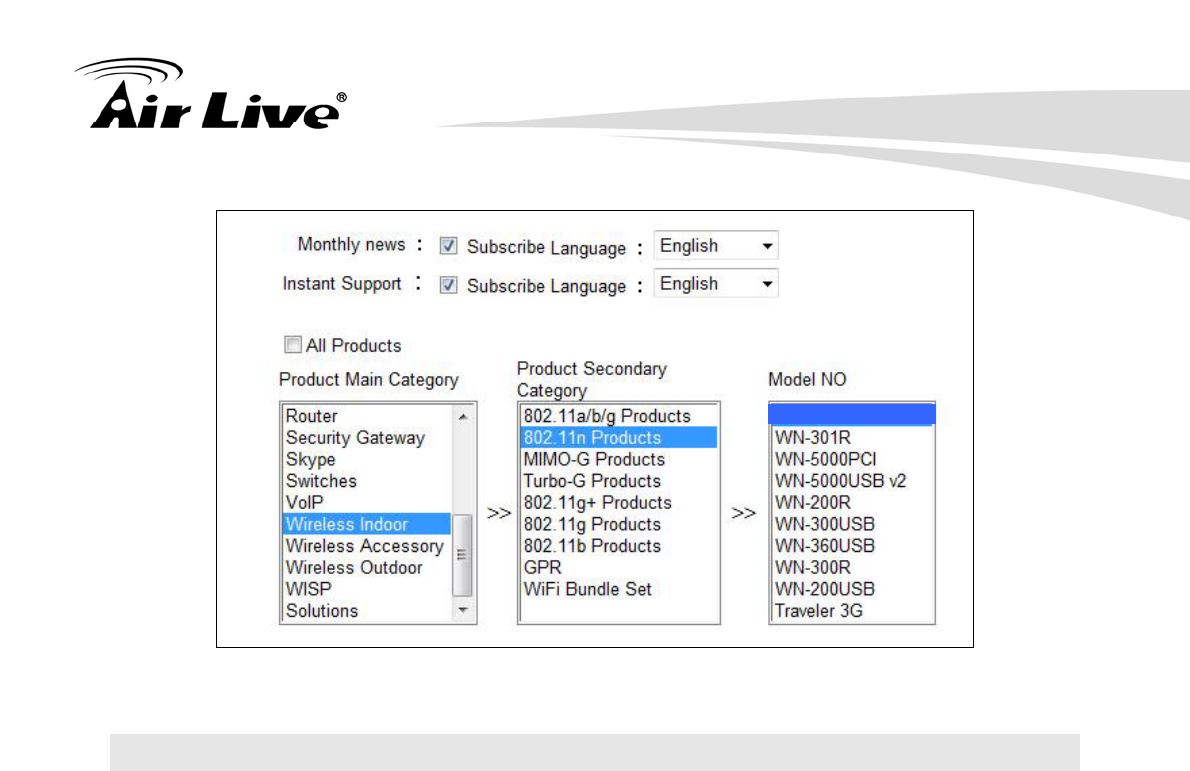
1. Introduction
AirLive N.Power User’s Manual 2
1.3 Features
Wireless-N AP Router
1 x USB 2.0 Port
Work with 3G/3.5G/UMTS/EVDO/HSDPA USB Dongle
7 LED indicators
Hotspot authentication function
150Mbps 1T1R Wireless-b/g/n standard
12V Passive POE Port
WAN port for ADSL/Cable Modem support
3G Router, AP, Client, Bridge, Repeater modes
Router, AP, Client, Bridge, Repeater modes
Bandwidth Control
8MB Flash, 32MB SDRAM
Green AP energy saving function
Wall Mount Screw Holes
Emergency firmware recovery mode
N.Powe
r
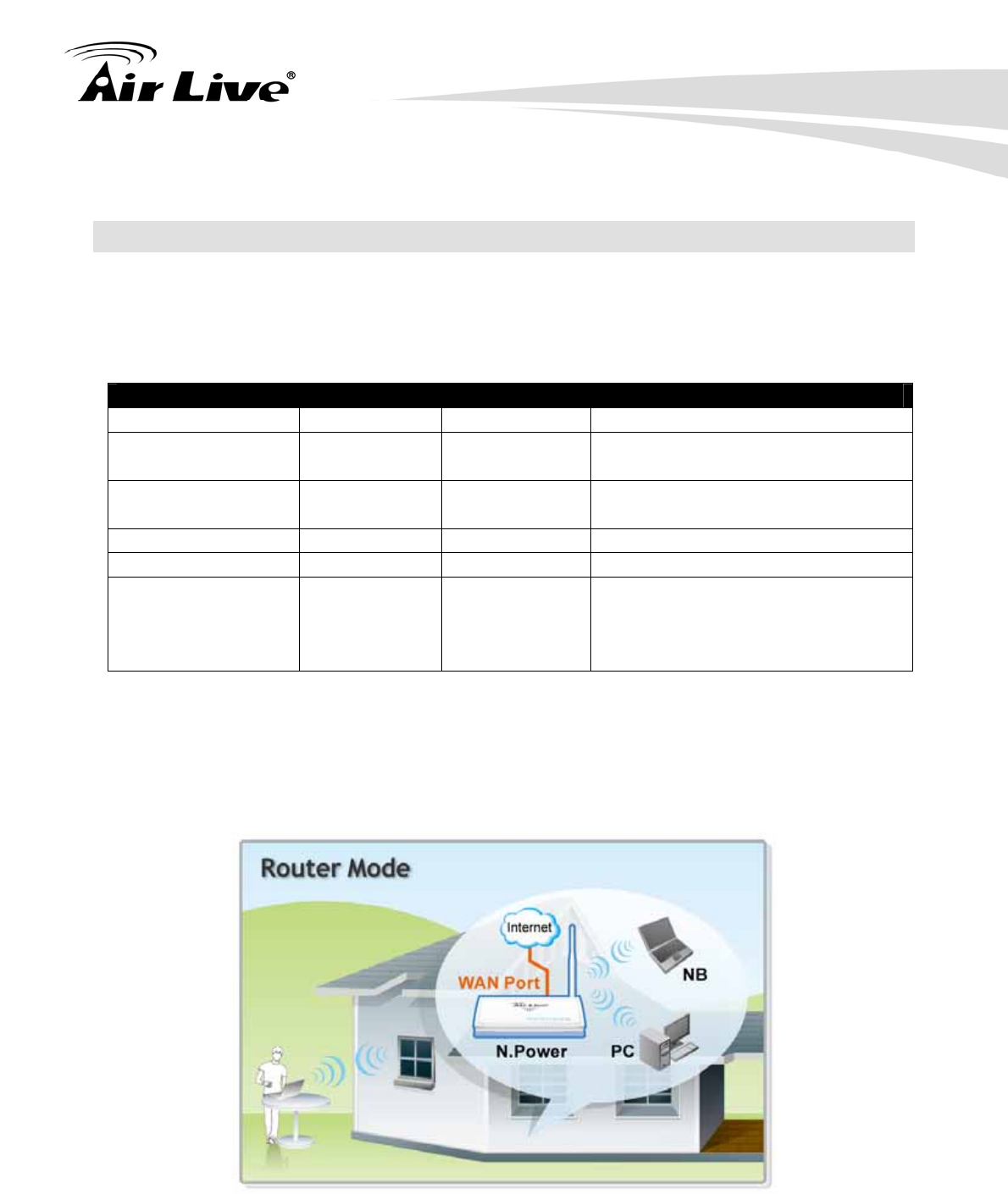
1. Introduction
3 AirLive N.Power User’s Manual
1.4 Operation Modes
The N.Power can perform as a multi-function wireless device. Through the AirLogic web
interface, users can easily select which wireless mode they wish the N.Power to perform.
The N.Power can be configured to operate in the following wireless operation modes:
N.Power Wireless Operation Mode
Wireless Mode Radio WAN Application
Router AP Yes
Sharing Internet Broadband
Wirelessly
AP AP none
Hotspot only or extend distance
of another WDS AP/Router
Client Client none Connect to AP Router
WDS Bridge WDS none Create a backbone connection
WDS Repeater AP + WDS N/A
Extend the wireless signal. WDS
Repeater setting is inside the
“Wireless Settings” of Router
mode and AP Mode.
1.4.1 Router Mode
In this mode, you can share your Internet connection both wired and wirelessly. The NAT
is applied for IP Sharing function from your WAN port to the LAN ports and wireless
interface.
1.4.2 AP mode
When operating in the Access Point mode, the N.Power becomes the center hub of the
wireless network. All wireless cards and clients connect and communicate through

1. Introduction
AirLive N.Power User’s Manual 4
N.Power. This type of network is known as “Infrastructure network”. Other N.Power or
802.11 b/g/n devices can connect to AP mode through Client Mode.
1.4.3 Client Mode
The N.Power acts as if it is a wireless adapter to connect with a remote Access Point.
Users can attach a computer or a router to the LAN port of N.Power to get network access.
1.4.4 WDS Bridge Mode
This mode is best used when you want to connect LAN networks together wirelessly (for
example, between office and warehouse). WDS Bridge using WPA-PSK or WPA2-PSK
encryptions might be limited to devices using the same wireless chipset.
WDS Bridge works by entering remote Bridge’s wireless MAC address on the WDS table.
You can find the MAC address on the bottom label of the N.Power.
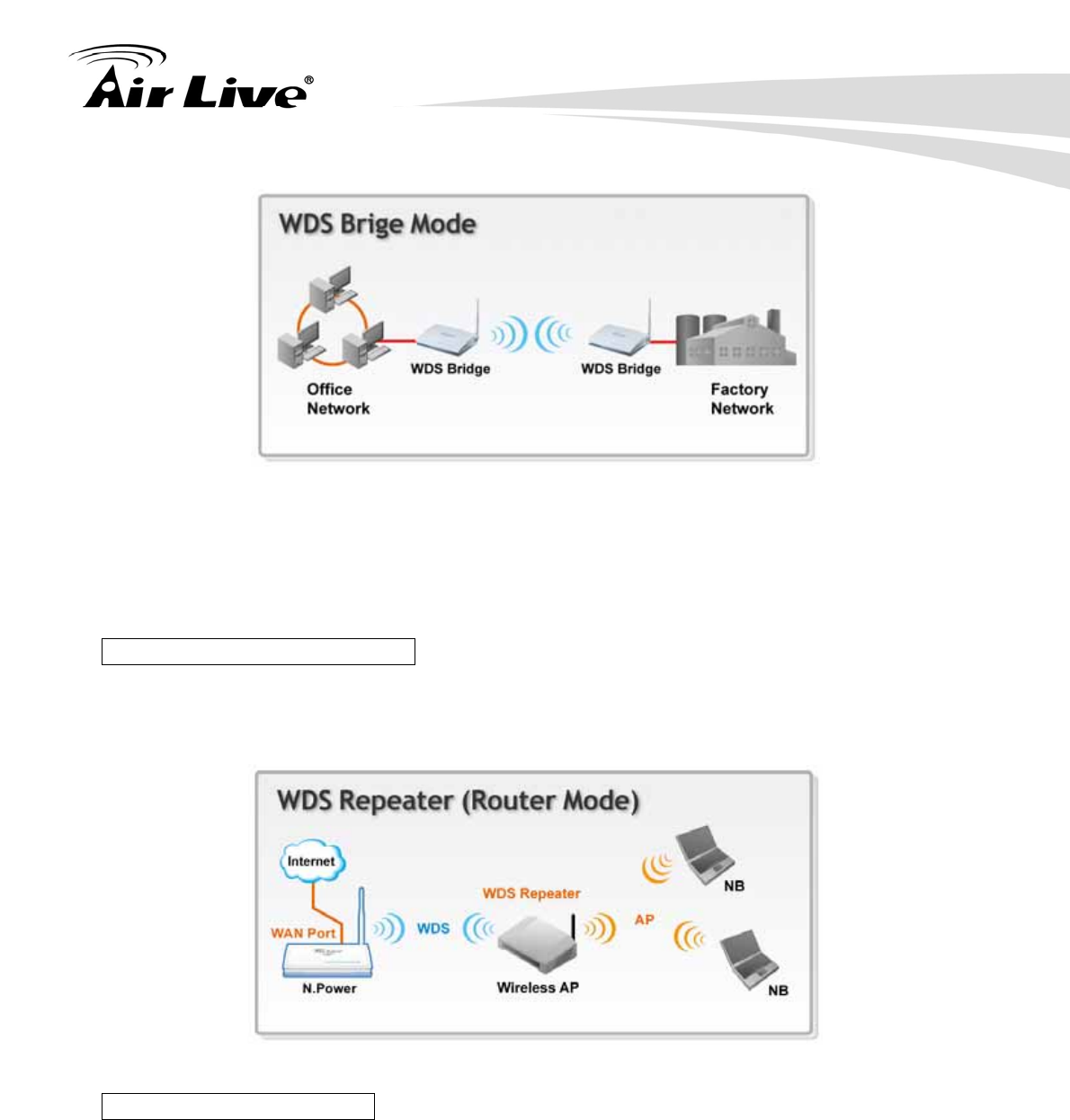
1. Introduction
5 AirLive N.Power User’s Manual
1.4.5 WDS Repeater Mode
The purpose of repeater is to extend the wireless signal of the remote AP/Router. In
N.Power, the AP mode and the Router mode also turn it to “WDS Repeater mode.” You can
find the WDS settings in the “Wireless Settings” page. Both sides must support WDS
connection to work.
WDS Repeater in Router Mode
The WDS Repeater function in Router mode is to allow the remote AP to extend the
wireless signal of N.Power. Please see the diagram below:
WDS Repeater in AP Mode
The WDS Repeater function in AP mode is to extend the wireless signal of remote AP.
Please see the diagram below for details:
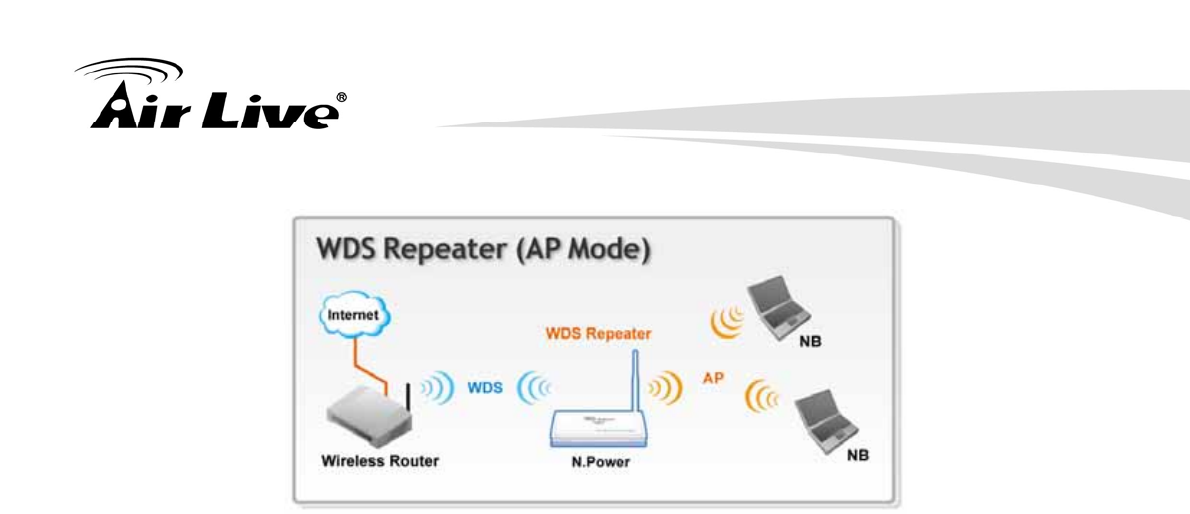
1. Introduction
AirLive N.Power User’s Manual 6
For information on how to configuration WDS Repeater, please go to section 4.4.10 or
section 6.2.8.

2. Installing the N.Power
7 AirLive N.Power User’s Manual
2 2. Installing the N.Power
This section describes the hardware features and the hardware installation procedure for
the N.Power. For software configuration, please go to chapter 3 for more details.
2.1 Before You Start
It is important to read through this section before you install the N.Power
The LAN1 port also work as the passive POE port
You must install the antenna first before plugging in the power. Otherwise,
the wireless radio might be damaged. Damage caused by not following
the installation procedure might void your warranty.
The passive PoE DC Injector is optional; it is not included with the package.
Please use a 12V passive POE system with N.Power’s passive POE port. Do
not use 802.3af 48V system or PoE switch with this device.
To protect the N.Power USB port from damage, please turn off the power when
plugging in or pulling out USB dongle from the USB port.
Work with 3G/3.5G/UMTS/EVDO/HSDPA USB Dongle
2.2 Package Content
The N.Power package contains the following items:
One N.Power main unit
One 12V 1A DC power adapter
1 x Antenna
User’s Guide CD
Quick Start Guide
2.3 Knowing your N.Power
Below are descriptions and diagrams of the product:
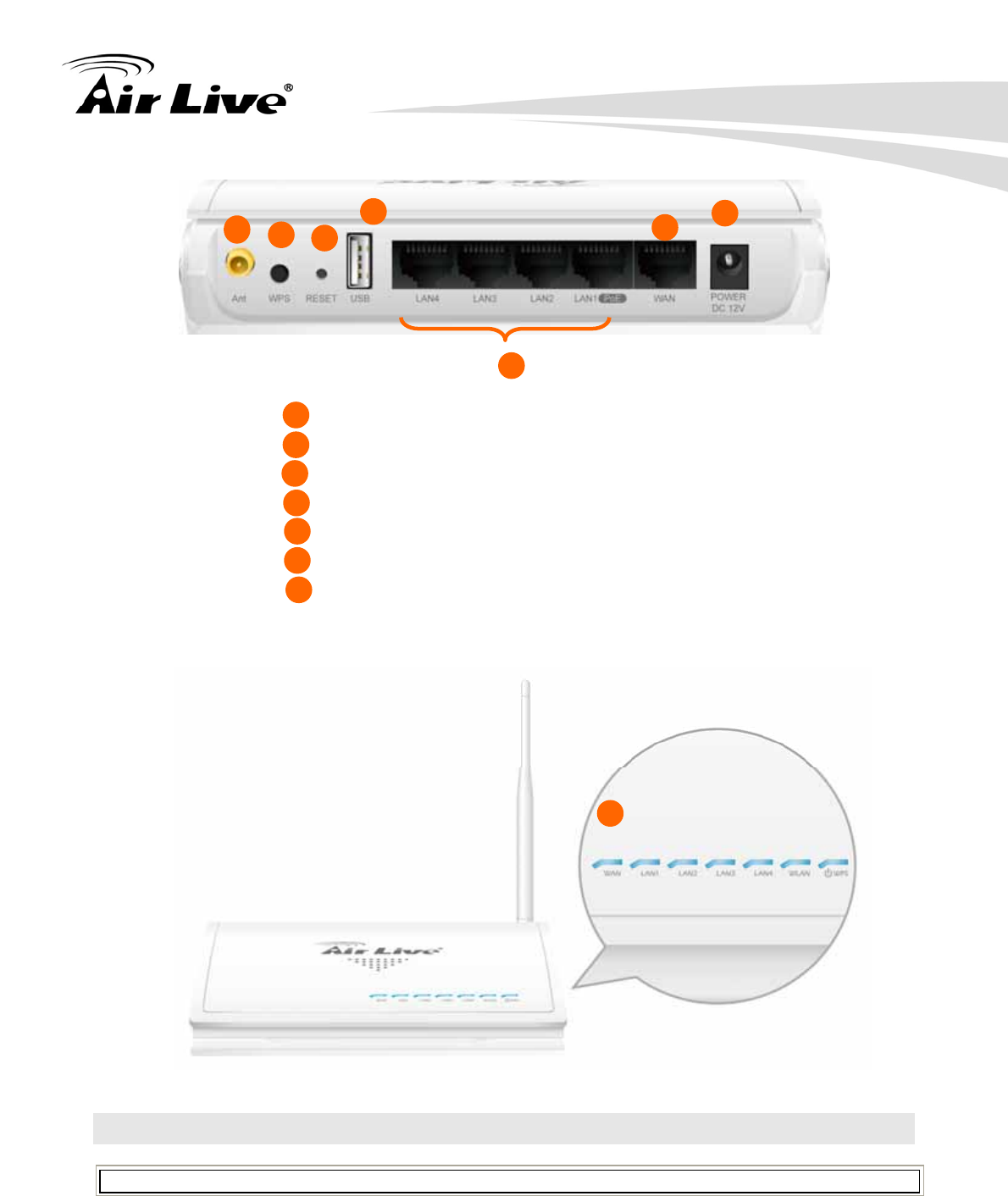
2. Installing the N.Power
AirLive N.Power User’s Manual 8
Antenna Connector
Power Adapter Connector
WAN Port
LAN Ports (LAN1 for Passive PoE Port)
Reset Button
WPS Button
USB Port (For 3G Dongle Use)
2.4 Hardware Installation
.1. Please install the antennas by turning clock wise into the RF antenna connectors
1
2
4
5
6
1 2
3
4
5
6
8 LED Indicators
3
7
7
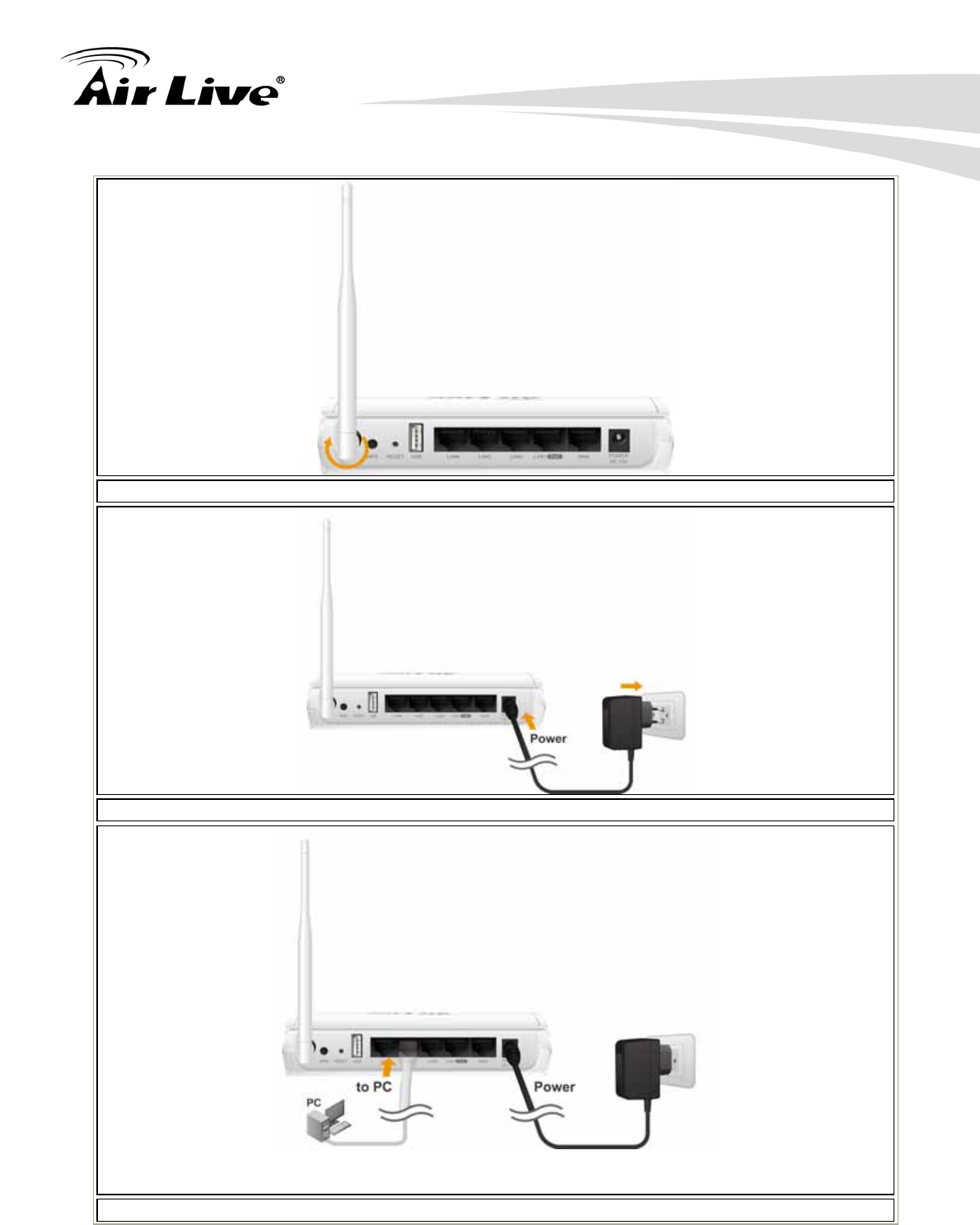
2. Installing the N.Power
9 AirLive N.Power User’s Manual
2. Now connect the power adapter to the N.Power
3. Connect the Ethernet cable to one of the LAN port and the other end to your PC.
4. If you have broadband connection, please connect the Internet cable to “WAN port”.
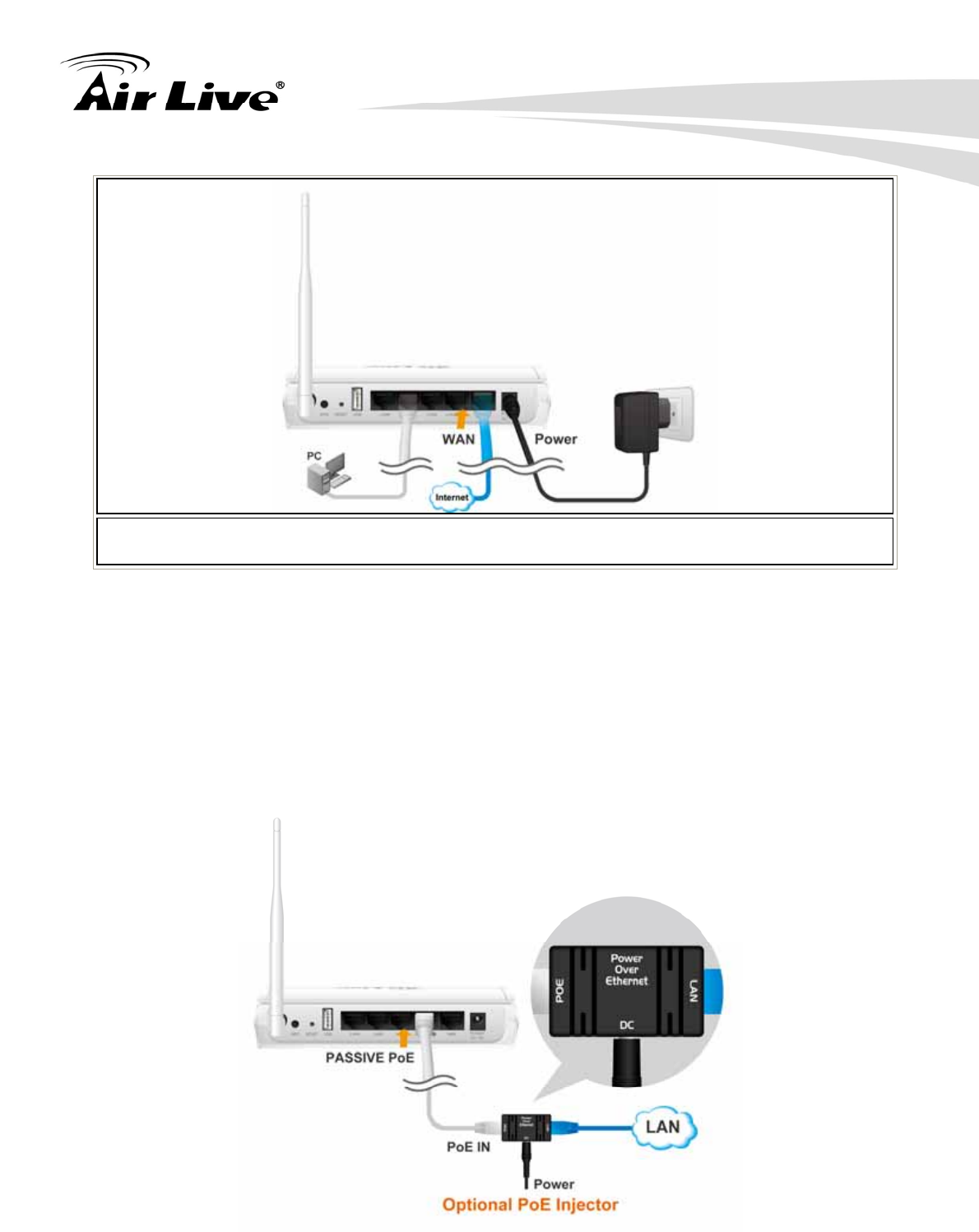
2. Installing the N.Power
AirLive N.Power User’s Manual 10
5. Open your browser and type “192.168.1.254” to access the web management
interface.
2.4.1 Passive PoE Installation
If you want to supply the power by using Passive PoE, please follow the installation
diagram below. Please note that the passive DC Injector is not included with N.Power, it
needs to be purchased separately (AirLive Model: PoE-1P). N.Power uses 12V passive
PoE system, it doesn’t work with 802.3af PoE switch or 48V PoE Kit. It is recommended
to use a power adapter of 12Vdc at 1.25A or greater if you have the USB dongle installed.
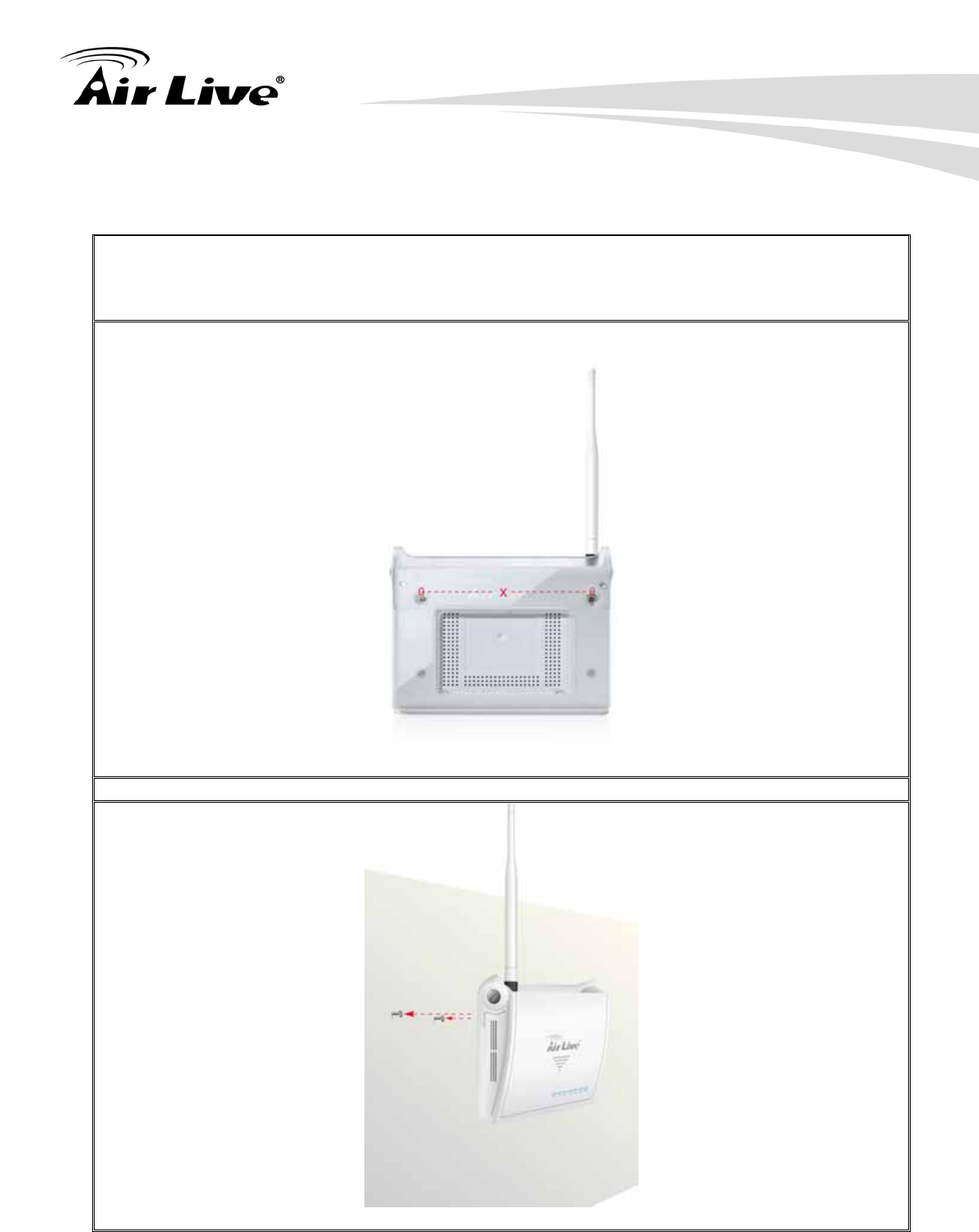
2. Installing the N.Power
11 AirLive N.Power User’s Manual
2.4.2 Wall Mount Installation
1. The holes for the wall mount screw are on the underside of the case. Please measure the
distance between the holes. Then install 2 screws in the desire location with the measured
distance apart from each other. Please do not screw all the way in, leave some space for
mounting with the N.Power
2. Now please hang the N.Power on those 2 screws.
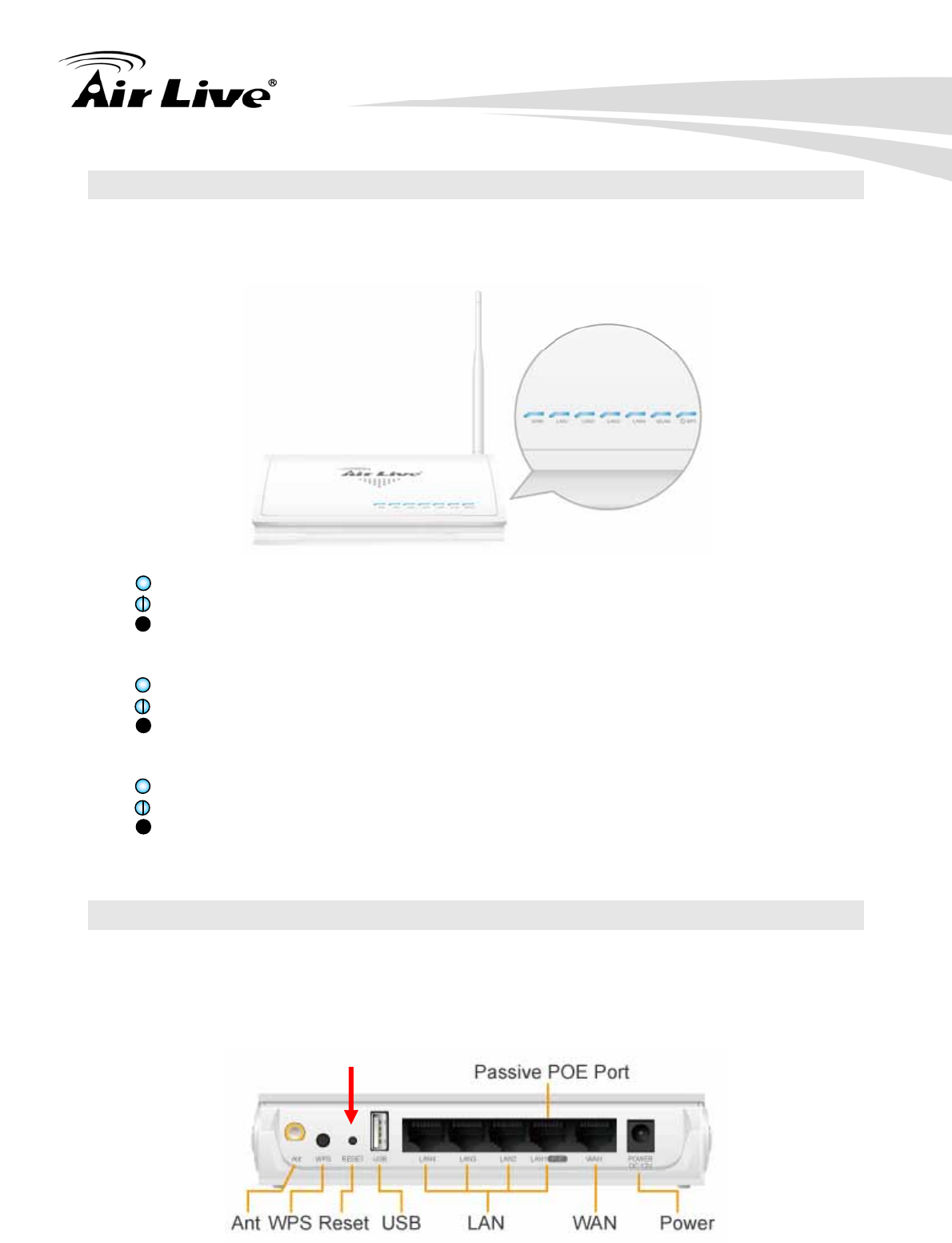
2. Installing the N.Power
AirLive N.Power User’s Manual 12
2.5 LED Table
This section describes the LED behavior of N.Power. You can find the LED on the top
side of the N.Power.
WPS (Power)
Steady Blue – Normal Operation
Slow Flashing: WPS Surveying
OFF – No Power
WLAN
Slow Flashing : Radio is active
Fast Flashing: Transmitting Data
OFF: Radio Disabled
LAN1 ~4, WAN
Steady Blue : Link established
Fast Flashing: Transmitting Data
OFF: No Link
2.6 Restore Settings to Default
If you have forgotten your N.Power’s IP address or password, you can restore your
N.Power to the default settings by pressing on the “reset button” for more than 10 seconds.
You might need a pen or pencil for this operation. The reset button is inside the bottom
case. Please see diagram below for details.

3. Configuring the N.Power
13 AirLive N.Power User’s Manual
The N.Power offers web browser (http) as management interface. In this chapter, we will
explain N.Power’s management interface and how to get into them.
3.1 Important Information
The following information will help you to get start quickly. However, we recommend you
to read through the entire manual before you start. Please note the password and SSID
are case sensitive.
The default IP address is: 192.168.1.254 Subnet Mask: 255.255.255.0
The default Account is “admin”
The default Password is “airlive”
The default SSID is “airlive”
The default wireless mode is : Router mode
Please remember to “Apply Change” for settings to be saved and take effect.
Please remember to “Reboot” the device after all settings are changed.
The Emergency Firmware Recovery only works when you connect to LAN1~4
By Default, the DHCP server is turned on in Router mode. The other modes’
DHCP servers are turned off. Therefore, if you switch from Router mode to other
modes, please remember to configure your PC’s IP address manually.
For instruction on how to configure the FTP function, please go to Chapter 4.3.
3.2 Prepare your PC
The N.Power can be managed remotely by a PC through either the wired or wireless
network. The default IP address of the N.Power is 192.168.1.254 with a subnet mask of
255.255.255.0. This means the IP address of the PC should be in the range of
192.168.1.1` to 192.168.1.253.
To prepare your PC for management with the N.Power, please do the following:
1. Connect your PC directly to the LAN port on the DC Injector of N.Power
3 3. Configuring the
N.Power
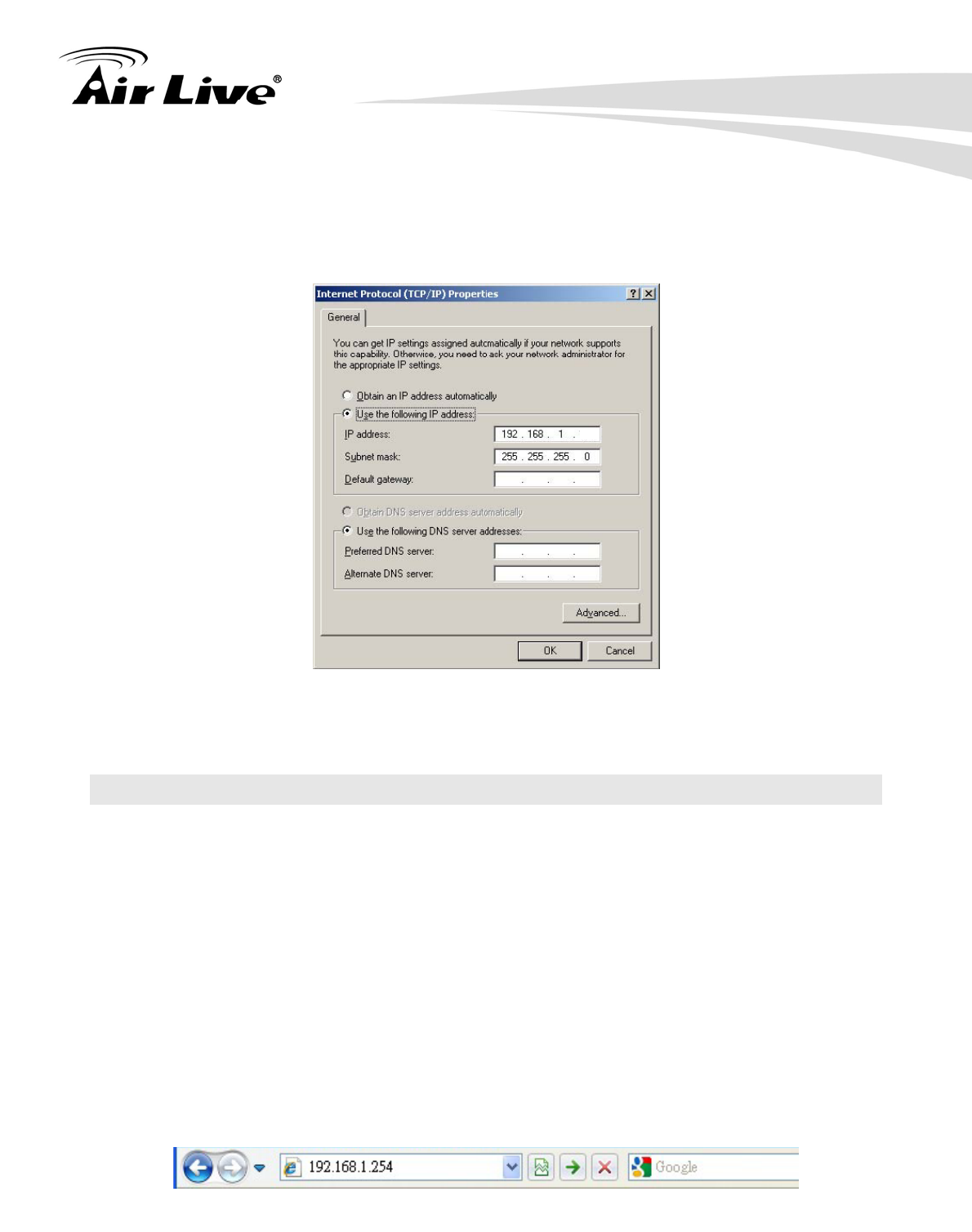
3. Configuring the N.Power
AirLive N.Power User’s Manual 14
2. Set your PC’s IP address to “Obtain an IP address automatically”. The N.Power
should provide your PC a valid IP address.
3. If you want to set your PC’s IP address manually, please set to 192.168.1.50 (or other
address in the same subnet)
You are ready now to configure the N.Power using your PC.
3.3 Introduction to Web Management
The N.Power can be configured using the Web management interfaces by simply typing its
IP address in the web browser. Most functions of N.Power can be accessed by it.
If you are placing the N.Power behind router or firewall, you might need to open the port 80
at virtual server on your firewall/router. This procedure is not necessary in most cases
unless there is a router/firewall between your PC and N.Power.
3.3.1 Getting into Web Management
To get into the Normal Web Management, simply type in the N.Power’s IP address (default
IP is 192.168.1.254) into the web browser’s address field.
50
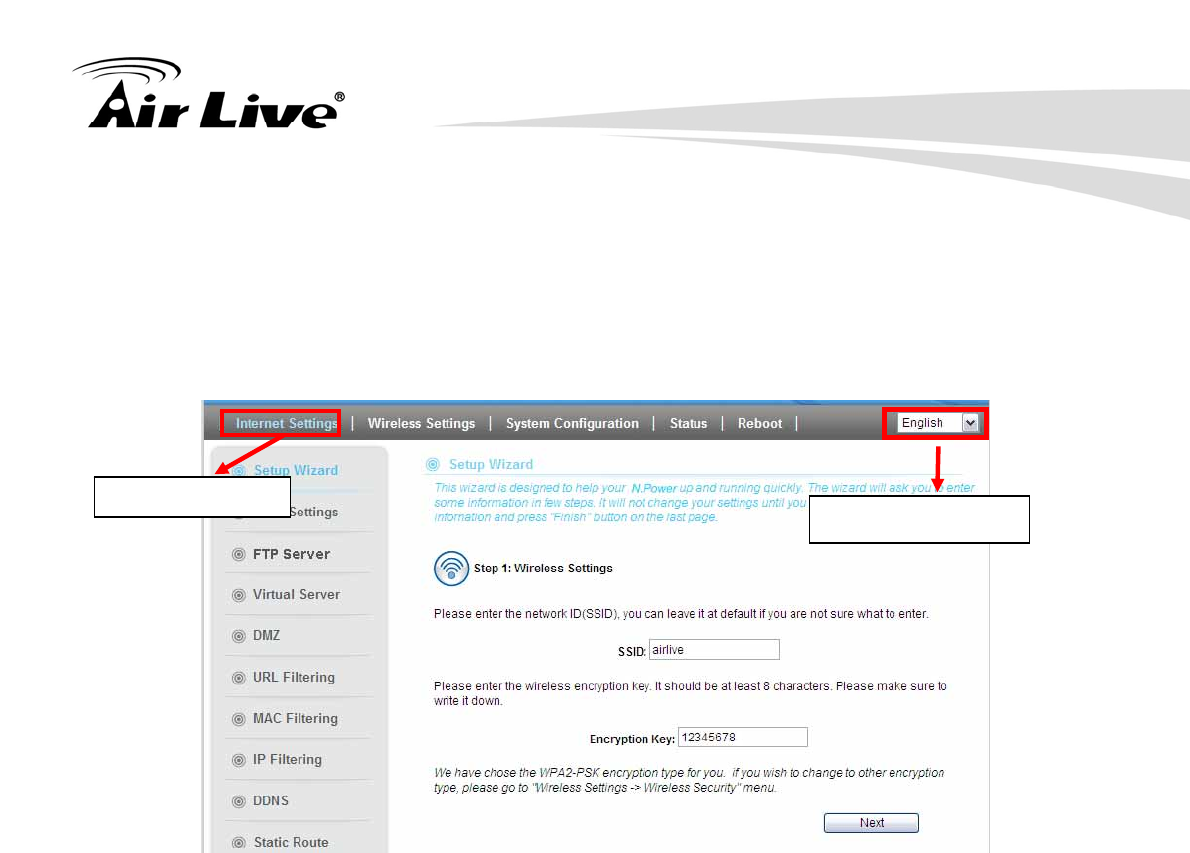
3. Configuring the N.Power
15 AirLive N.Power User’s Manual
3.3.2 Web Menu Structure
We recommend users to browse through N.Power’s web management interface to get an
overall picture of the functions and interface.
After you enter the Web configuration, the following screen will appear:
Internet Settings: When you choose Router mode, the “Internet Settings” bottom
will be shown and you will be able to configure internet related functions here.
This menu will disappear when you switch to other wireless mode.
Wireless Settings: The N.Power’s wireless settings are different between wireless
modes. Only functions that are applicable to the wireless mode will show to
simplify configuration. You can also change the operation mode from this menu.
For explanation of different wireless modes, please refer to Chapter 1.
System Configuration: All non-wireless and router mode settings are in this
category. The system configurations including changing password, upload
firmware, backup configuration..
Status: This section for monitoring the status of N.Power. It provides information
on Device Information, Statistic, Client table, and Log.
Reboot: Most of settings will require to click the “Reboot” bottom to take effect the
settings you applied.
Language Selection: You can change the language for the Web interface from
here.
Language Selection
Internet Settings
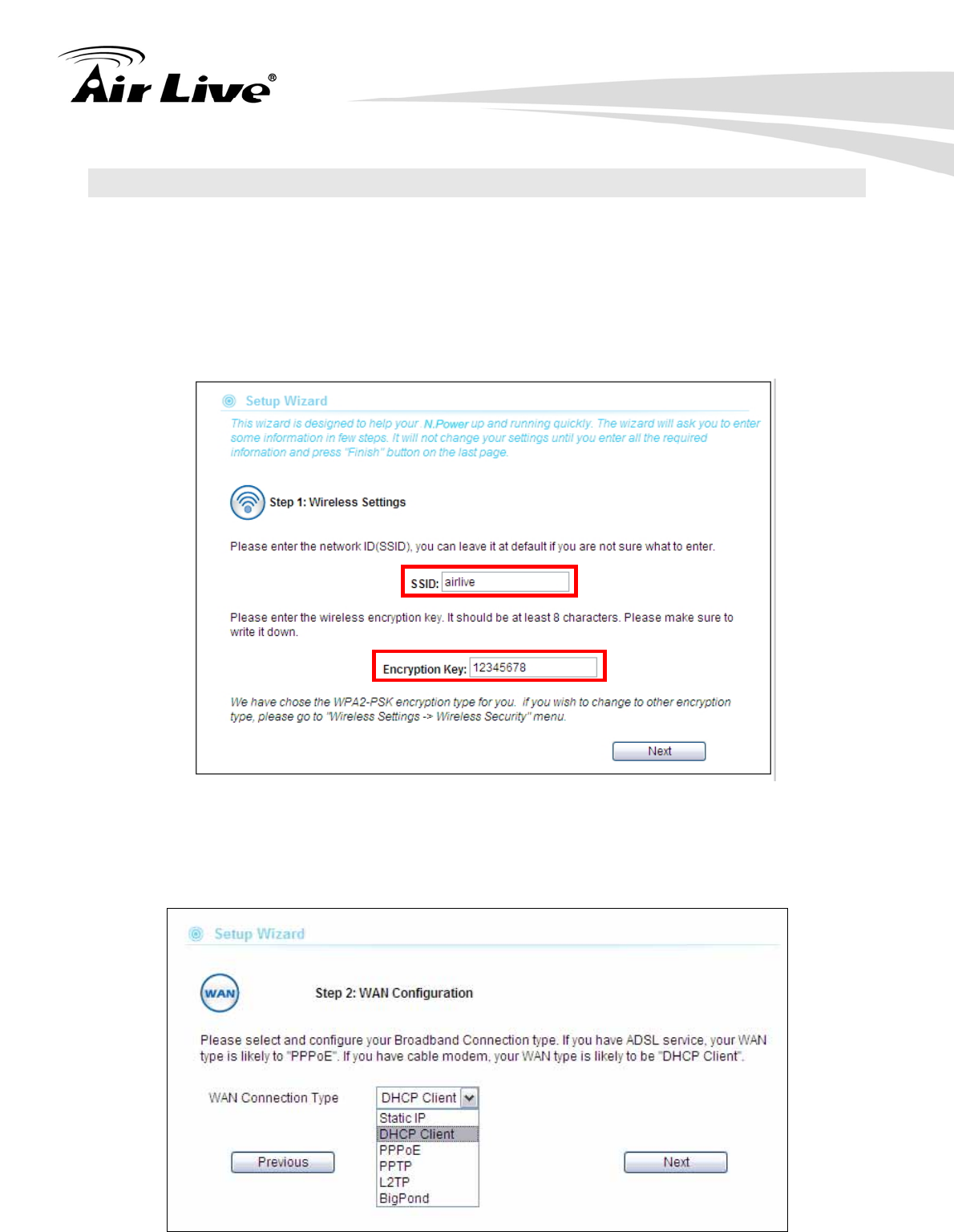
3. Configuring the N.Power
AirLive N.Power User’s Manual 16
3.4 Configuration Wizard
The configuration Wizard is the first screen you will see after you login. It will ask you a
few questions to setup your wireless and broadband connection quickly.
Step 1: Please enter your own SSID and Encryption Key. The default encryption type is
WPA2-PSK (AES). The encryption key should be at least 8 alphanumeric
characters.
Step 2: Choose your Broadband Connection type. If you are not sure about setup
information, please ask your ISP for parameters.
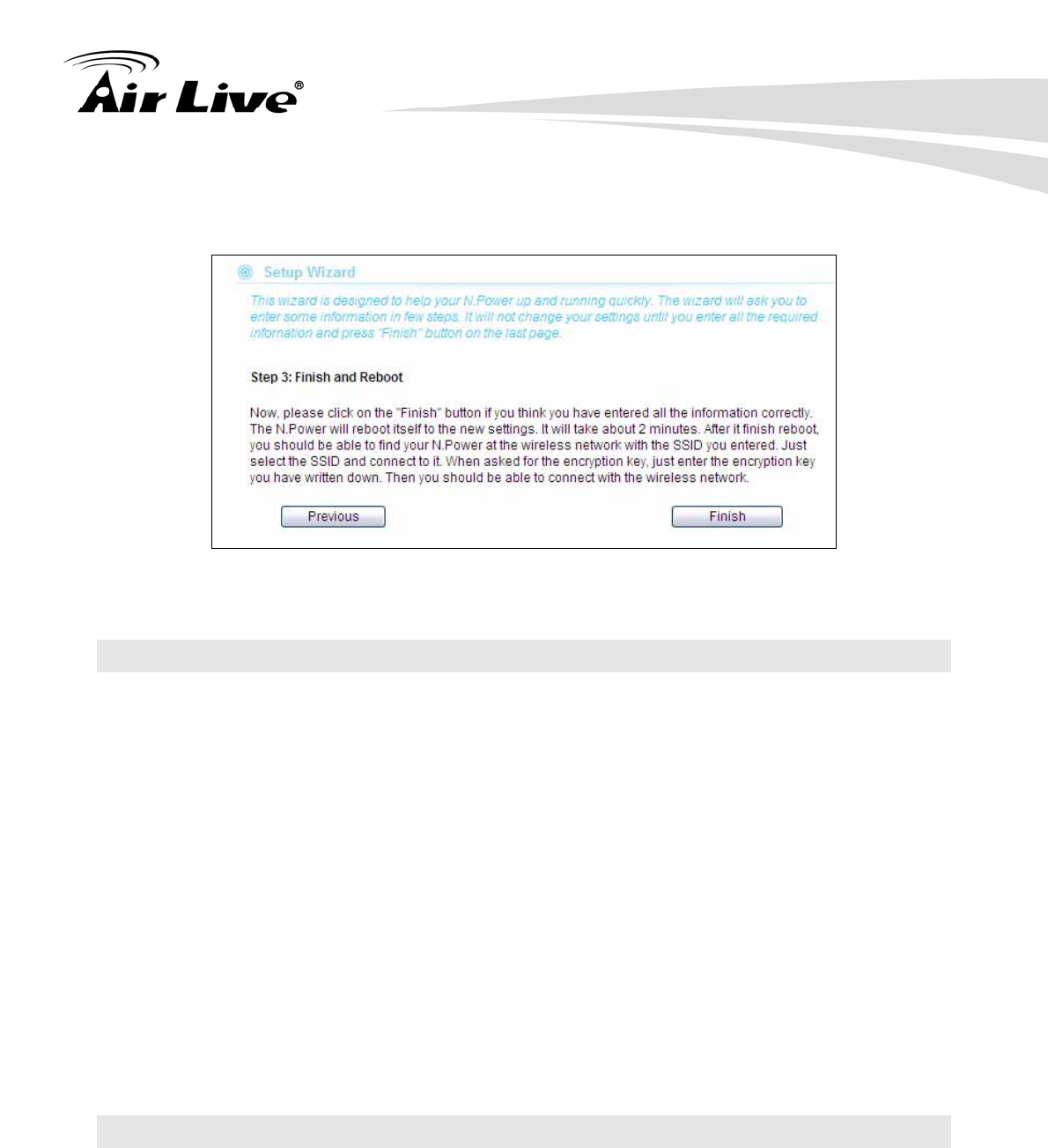
3. Configuring the N.Power
17 AirLive N.Power User’s Manual
Step 3: Please click “Finish” to reboot the system if you are sure about all settings.
3.5 Change Operation Mode
The wireless settings of N.Power are dependant on the wireless operation mode you
choose. For explanation on when to use what operation mode, please refer to Chapter 1
Changing Mode Procedure:
1. Select “Wireless Setting”
2. Choose your required wireless mode.
3. The AP might ask you to confirm the mode change. Once confirm, the AP will reboot to
its new mode.
Note: When you change from Router mode to other modes, the DHCP server will be turned off. In
this case, you must manually configure your PC’s IP address to the same subnet as the
N.Power. Likewise, when you change from other modes to Router mode, the DHCP server will be
turned on.
3.6 WPS (WiFi Protected Setup)
WPS is a system that simplifies the process to established wireless security. There are two
ways to configure WPS connection:
1. PBC (Push Button Communication) using hardware or software:
Push WPS buttons on both AP and Client site, the WPS connection will connect
automatically. You can find N.Power’s WPS Push button on the back of the router.
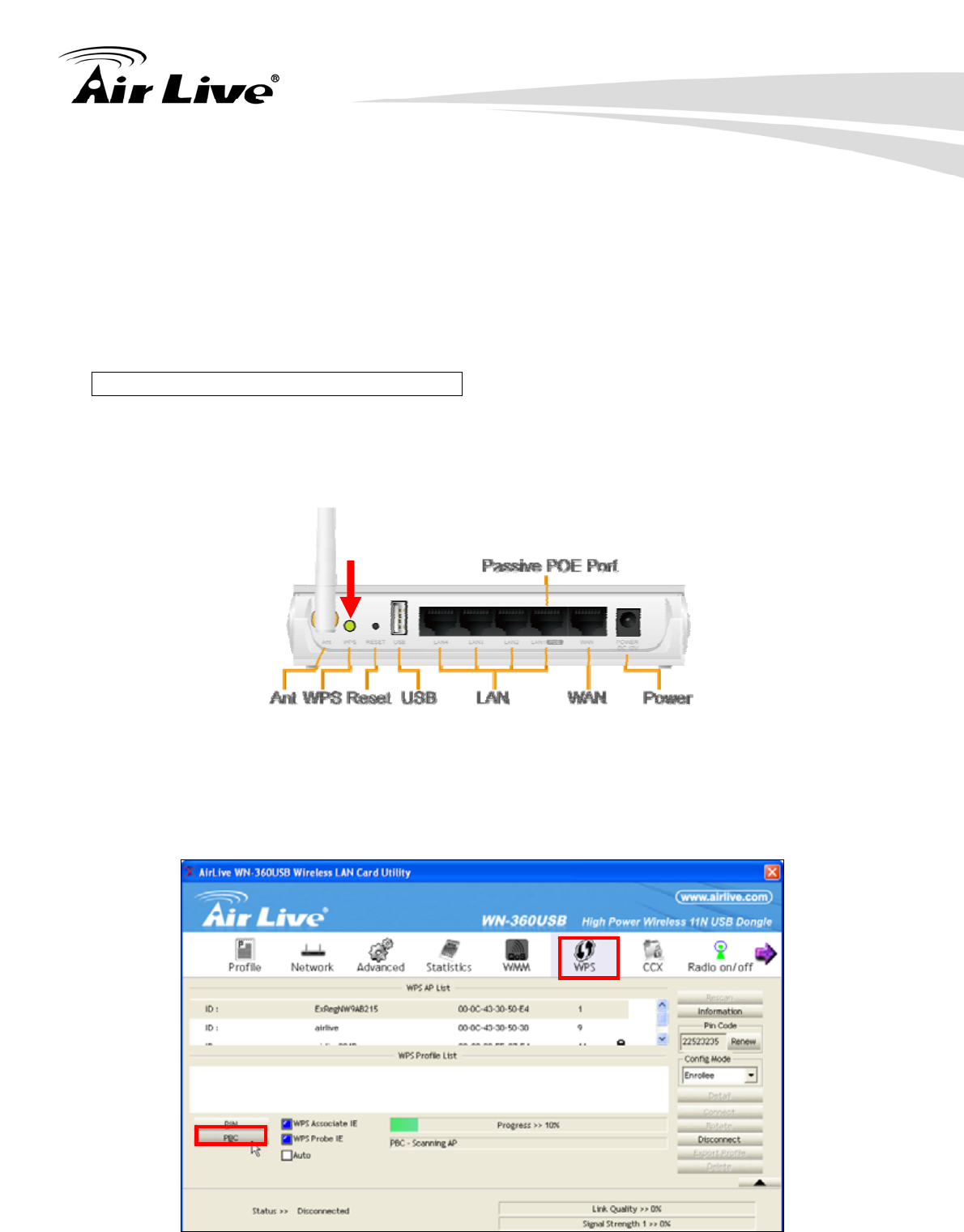
3. Configuring the N.Power
AirLive N.Power User’s Manual 18
2. PIN (Personal Information Number) Enrollee and Registrar:
WPS Registrar site should be entered the PIN Code from Enrollee site, the WPS
connection will connect automatically.
It is recommended to use the first option as it is much simpler to configure.
3.6.1 AP and Router Modes
Example1: Using Hardware Push button
Please push WPS button directly on the back of the N.Power. The “WPS” LED flash will
light and the N.Power will start to survey the client’s WPS signal in the current environment.
Please be noticed that, within two minutes, you have to turn on the utility of your wireless
network card and click PBC to connect automatically.
If you also have a hardware WPS button on your wireless card, you can push the button
immediately now. If not, you can usually find the WPS PBC function in the wireless utility.
Below is an example using AirLive WN-360USB wireless network card to connect with
N.Power.
6
7
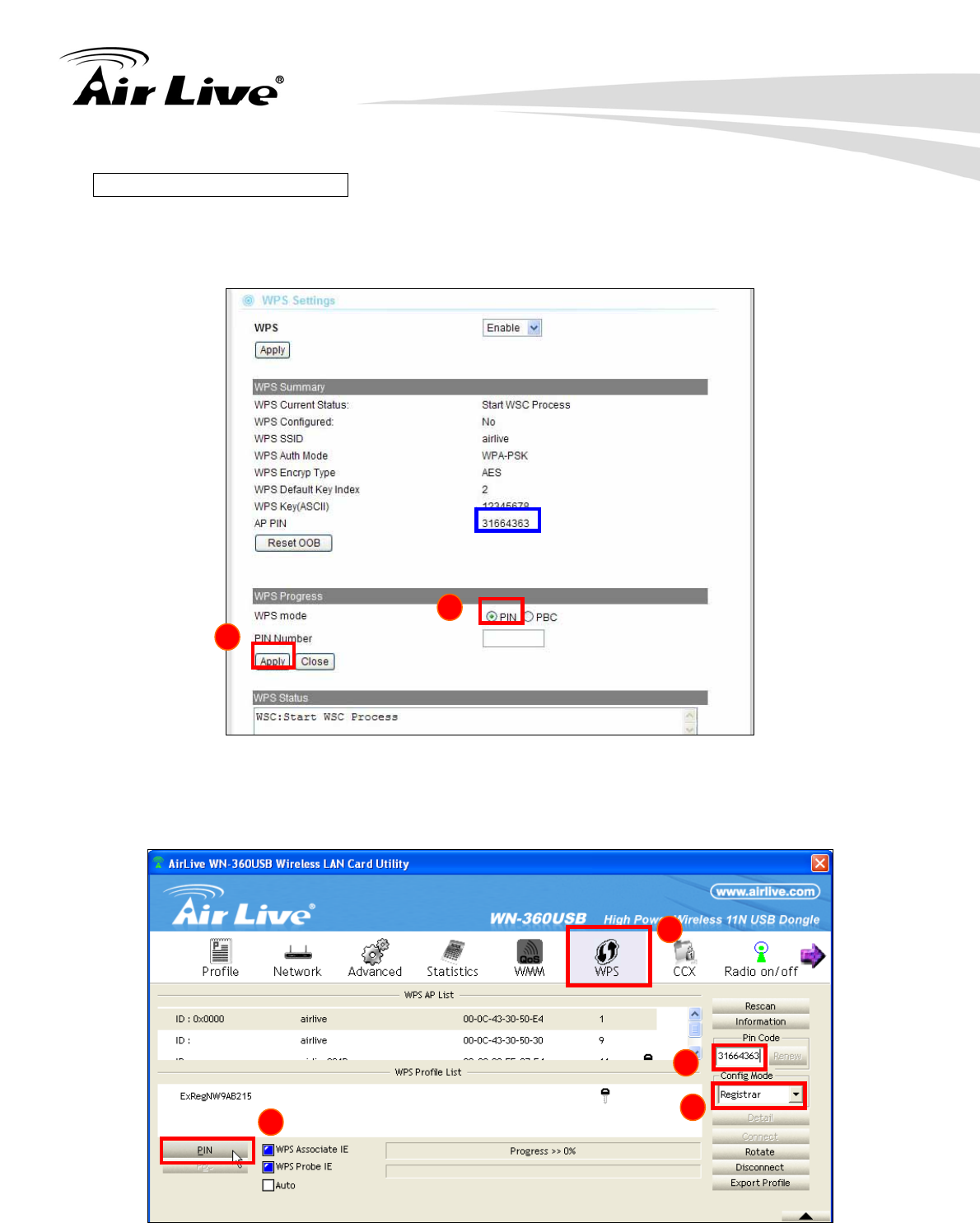
3. Configuring the N.Power
19 AirLive N.Power User’s Manual
Example 2: WPS Using PIN
Please login N.Power’s Web UI. Select Wireless Setting Æ WPS Setting. In the WPS
Progress, select “PIN” then “Apply.” You will get a PIN Code.
Then, please turn on the utility of your wireless network card. Choose WPS mode to
“Registrar” and enter the PIN Code. Press “PIN” and the connection will automatically
configure.
PIN Code
1
2
3
4
5
6
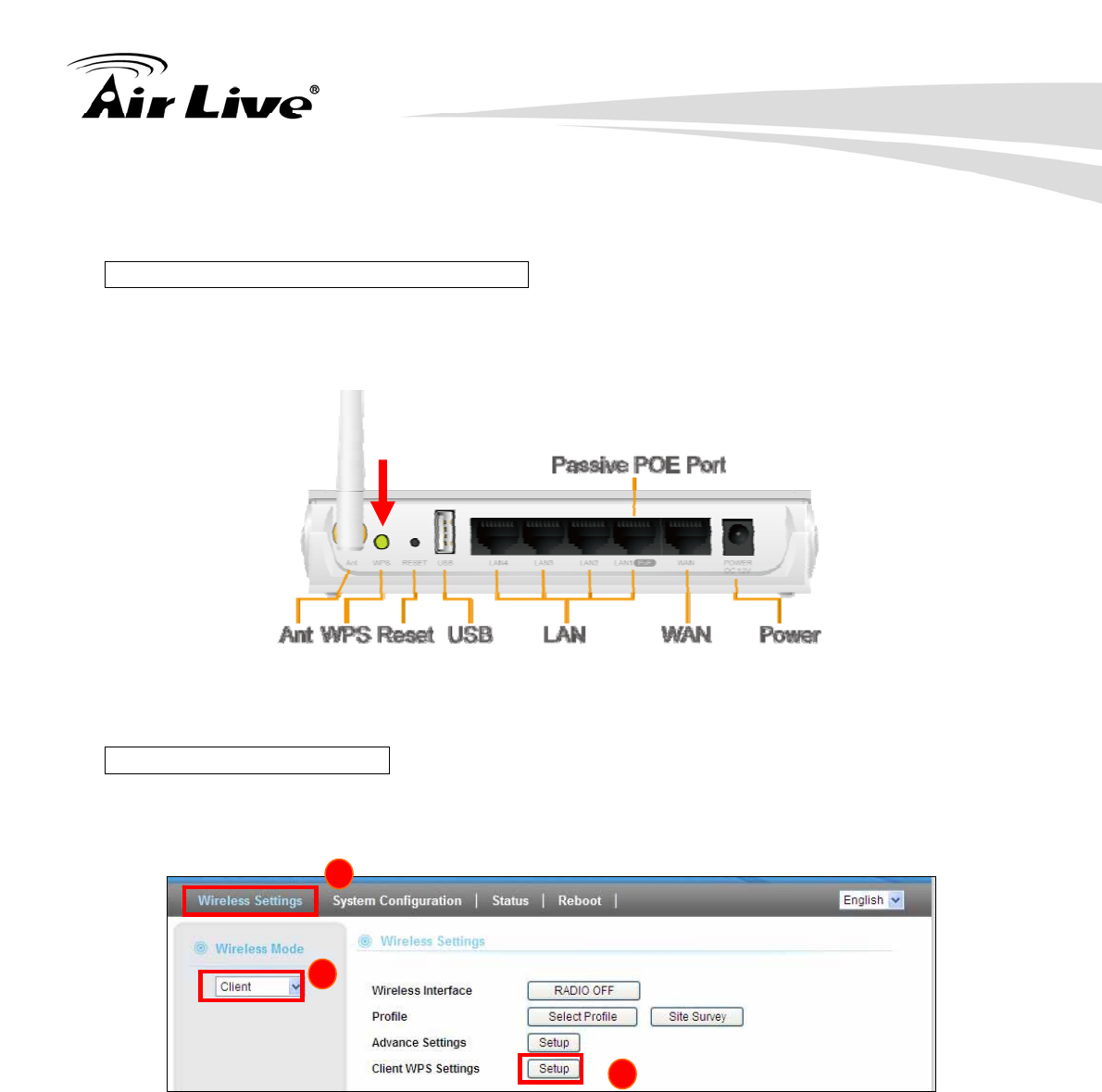
3. Configuring the N.Power
AirLive N.Power User’s Manual 20
3.6.2 Client Mode
Example 1: Using WPS hardware button
Please push WPS button directly on the back of the device. The “WPS” LED flash will light
and the N.Power will start to survey the AP’s WPS signal in the current environment.
Within two minutes, please push WPS button on your AP device, the connection will
automatic successfully.
Example 2: WPS using PIN
Please login N.Power’s Web UI. Select Wireless Setting Æ change to Client mode Æ
Client WPS Setting.
Select the SSID that you want to connect. Choose WPS mode to “Enrollee” and get a PIN
Code in the field. Then press “PIN Start” and the “WPS” LED flash will light two minutes
on the device’s housing.
1
2
3
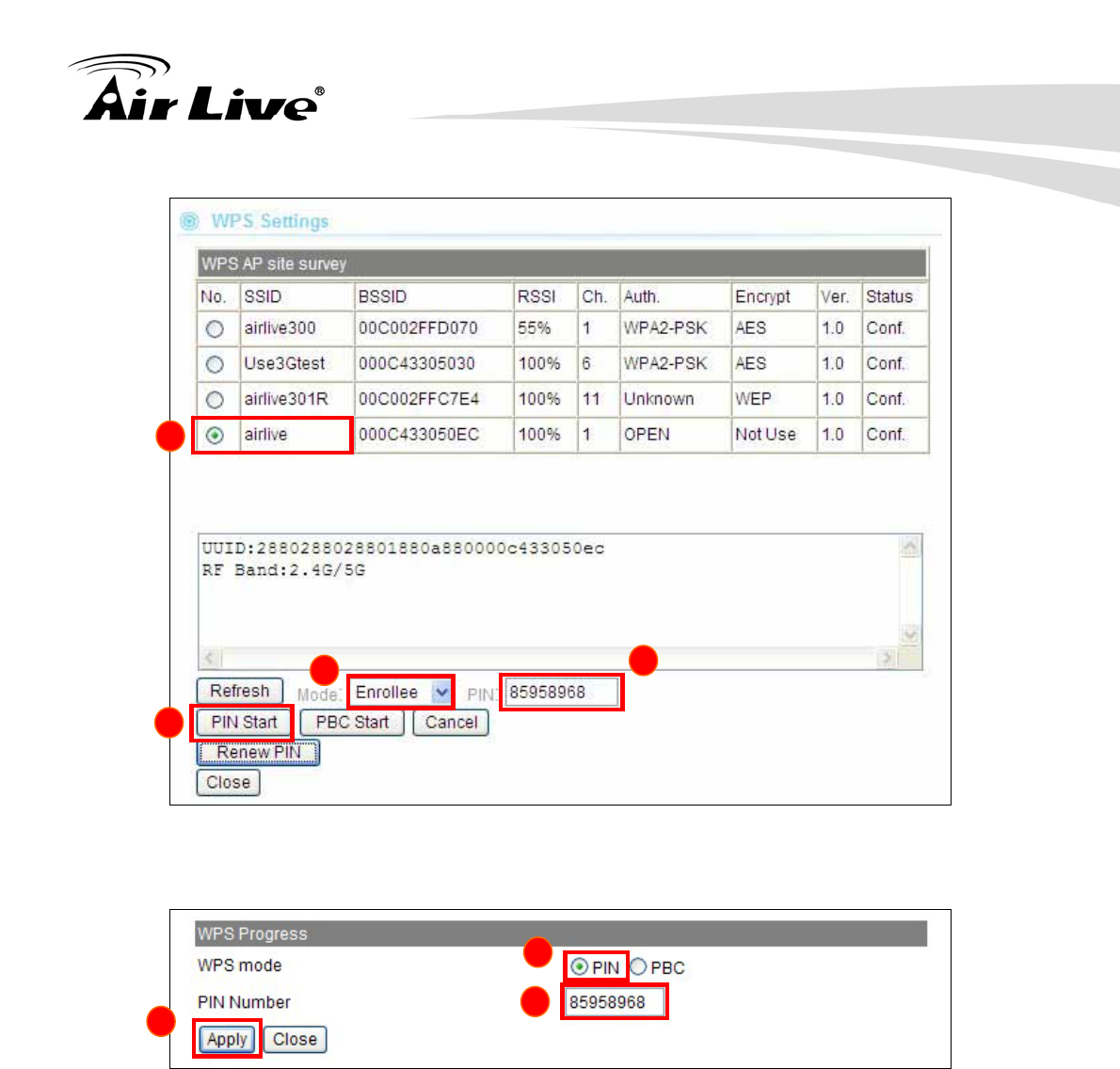
3. Configuring the N.Power
21 AirLive N.Power User’s Manual
Under AP site, Select Wireless Setting Æ WPS Setting. Choose WPS mode to “PIN” then
enter the PIN Code Æ click “Apply” and the connection will automatically configure.
Copy PIN Code
4
5 6
7
10
Enter PIN Code
8
9
10
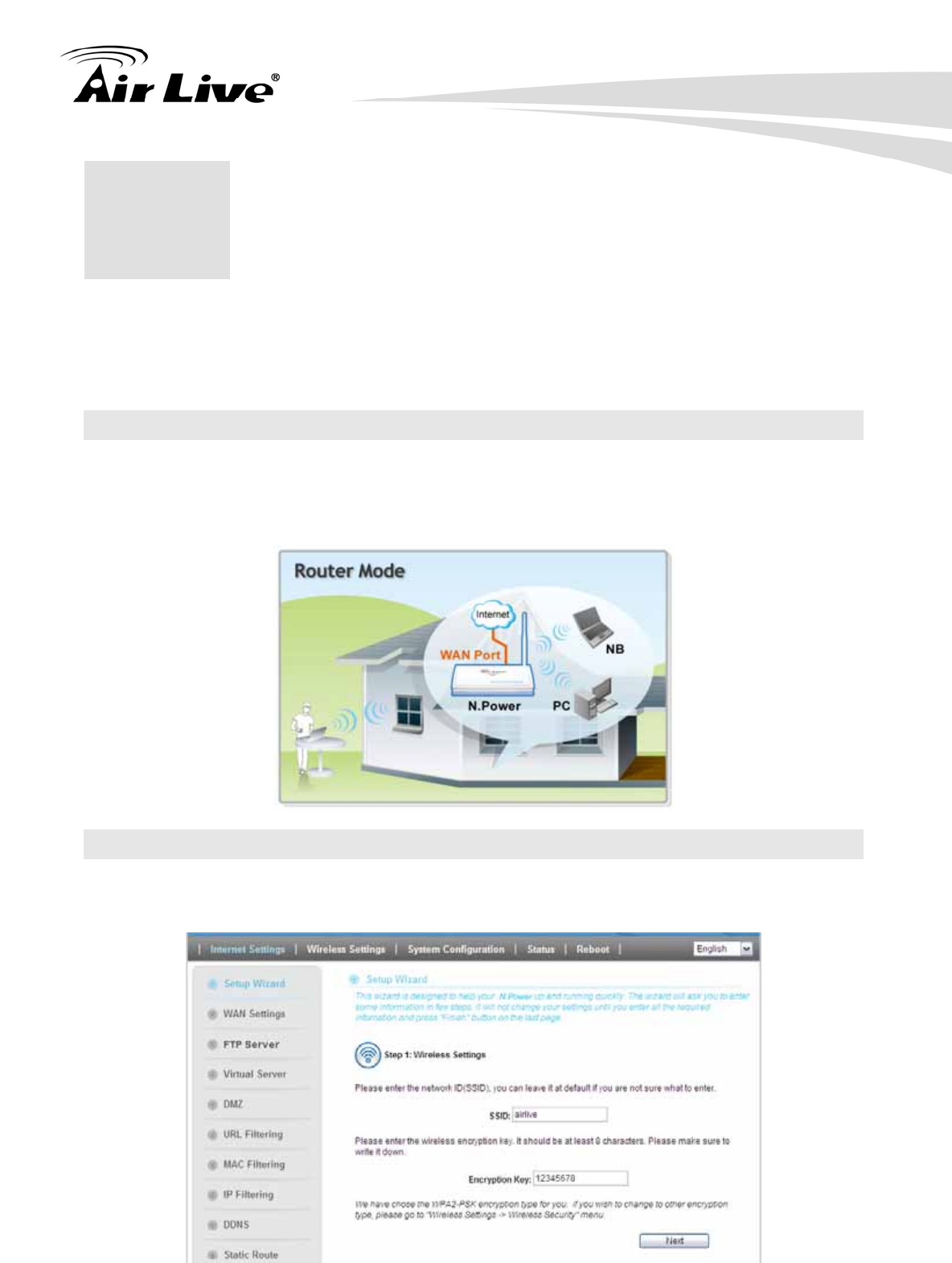
4. Configuration: Router Mode
AirLive N.Power User’s Manual 22
In this chapter, we will explain about the wireless settings for Router Mode. Please be
sure to read through Chapter 1.5 and Chapter 3’s “Introduction to Web Management”.
4.1 Application for Router Mode
The router mode is the main operation mode of the N.Power. In this mode, you can share
your Internet connection both wired and wirelessly. The NAT is applied for IP Sharing
function from your WAN port to the LAN ports and wireless interface.
4.2 Internet Setting Menu
The Internet Setting Menu is the first menu you will see after login to N.Power. All WAN
related configurations can be found here. This menu will not appear in any other modes.
4 4. Configuration: Router
Mode
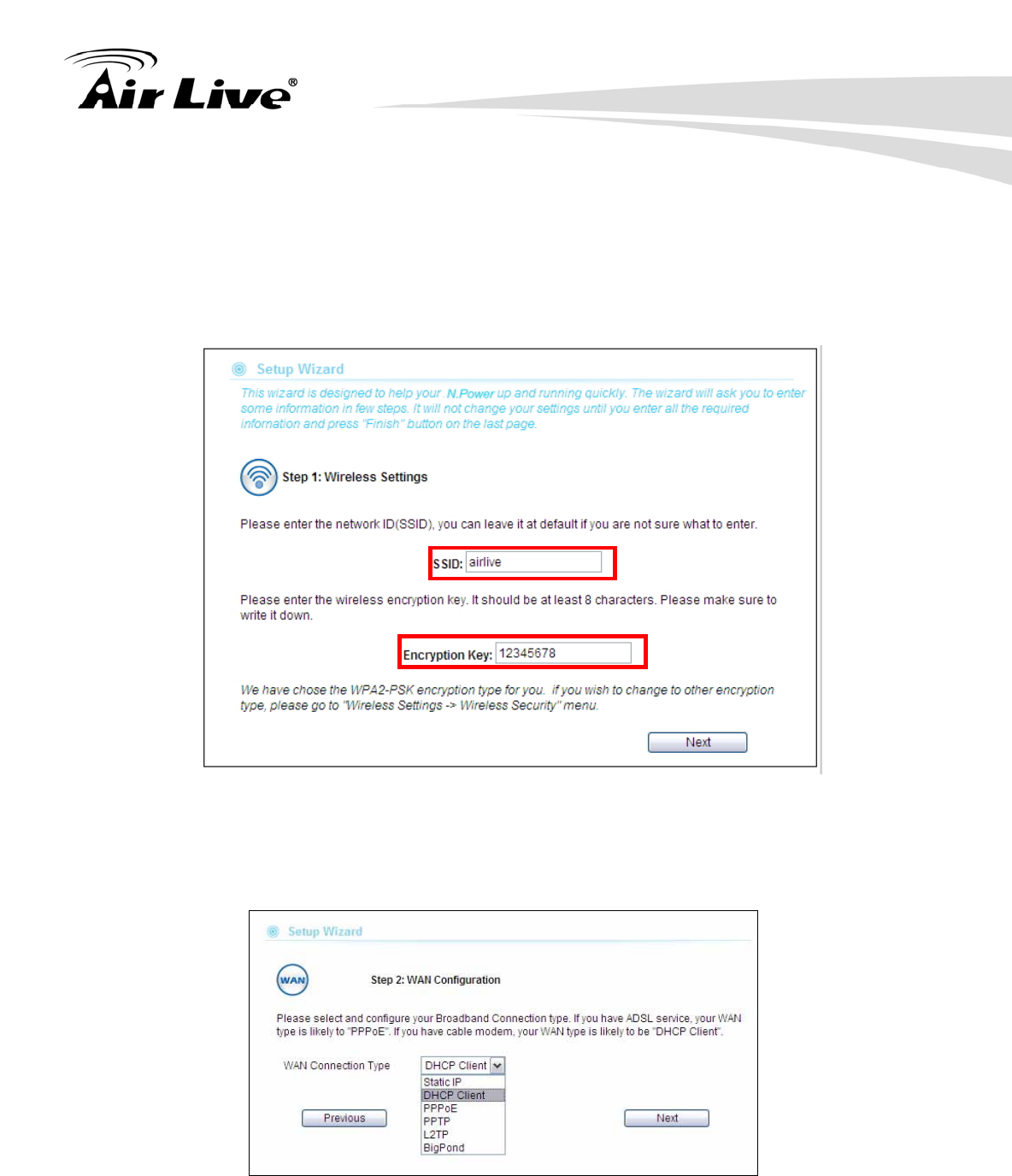
4. Configuration: Router Mode
23 AirLive N.Power User’s Manual
4.2.1 Setup Wizard
The configuration Wizard is the first screen you will see after you login. It will ask you a
few questions to setup your wireless and broadband connection quickly.
Step 1: Please enter your own SSID and Encryption Key. The default encryption type is
WPA2-PSK (AES). The encryption key should be at least 8 alphanumeric
characters.
Step 2: Now, please choose the WAN type and enter your account information. If you
are not sure about setup information, please ask your ISP for parameters.
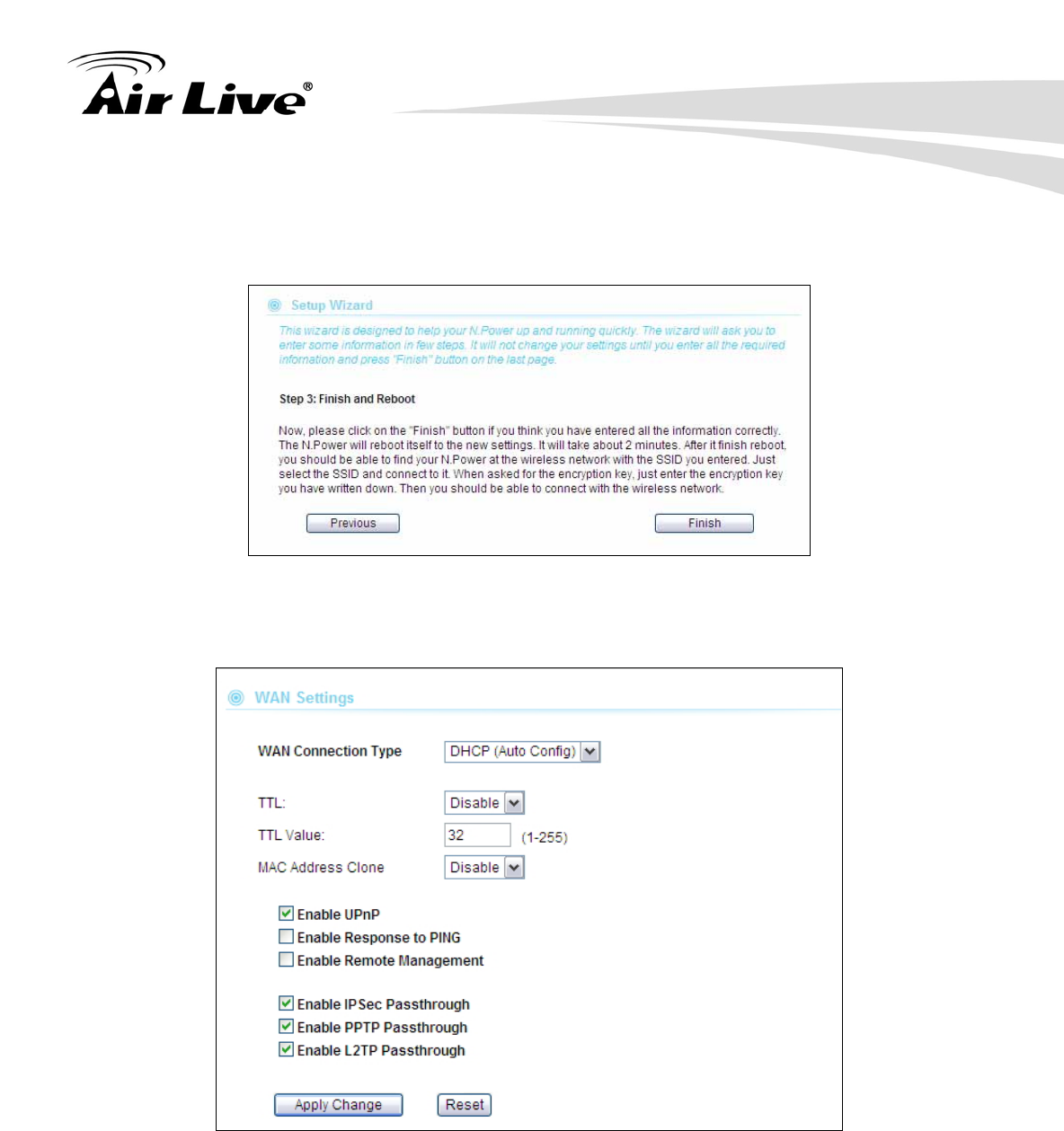
4. Configuration: Router Mode
AirLive N.Power User’s Manual 24
Step 3: Please click “Finish” to reboot the system if you are sure about all settings.
4.2.2 WAN Setting
Internet Settings -> WAN Settings
WAN Connection Type: Choose your ISP connection Type. If you are using ADSL
connection, the most likely connection type is PPPoE. If you are using Cable Modem,
the most likely connection type is DHCP. However, please consult with your ISP
about the correct setting first.
TTL: Time to Live is a 8-bit value in the IP header. Your ISP might require to set this
value to work. Please consult with your ISP settings to check if setting the TTL is
required. In most cases, it is not. If it is required, please enable TTL then enter the
value in the below field.

4. Configuration: Router Mode
25 AirLive N.Power User’s Manual
MAC address clone: If your ISP lock Internet access by MAC address of your PC.
You might need to enable this function and enter your PC’s MAC address here.
Enable UPnP: Enable universal plug and play
Enable Response to PING: Please enable this if you want N.Power to response to
remote PING command
Enable Remote Management: Enable this option for remote access of the web
management interface.
Enable VPN Pass Through: If you have VPN servers in your local area network, you
need to turn on the VPN pass through to allow remote access to the VPN networks.
4.2.3 Virtual Server
Internet Settings -> Virtual Server
Virtual server allows you to specify one or more applications running on server computers
on the LAN that may be accessed by any Internet user. Internet data destined for the
specified public port will be directed to the specified private port number on the LAN client
with the specified private IP address.
If you want to allow your web server, ftp server, or email server to be accessible from
Internet, you would need to open specific port on the virtual server to your local IP address.
The N.Power feature “Copy PC” and “Pre-defined” services to simply the process of
creating virtual server.
Example1: Open FTP service to your PC
6. Step 1: Enable the Virtual Server function
7. Step 2: Click on “Copy PC” icon to copy the IP address of your PC.
8. Step 3: Click on “Pre-Define” for a list of popular service and select “FTP”.
9. Step 4: Click on “Apply” and the new virtual server should appear on table list.
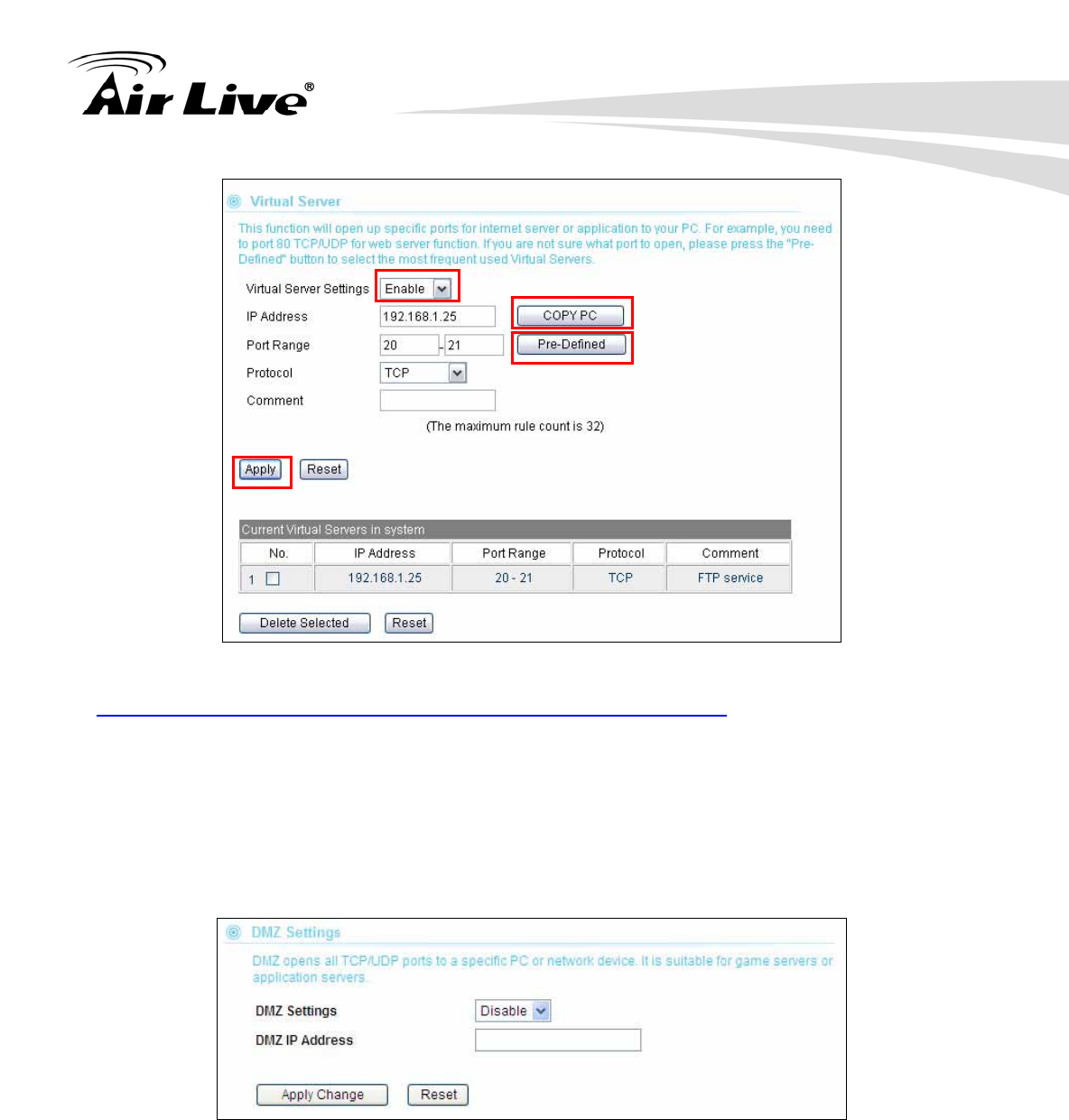
4. Configuration: Router Mode
AirLive N.Power User’s Manual 26
For a list of most frequent used TCP and UDP ports. Please visit
http://en.wikipedia.org/wiki/List_of_TCP_and_UDP_port_numbers
4.2.4 DMZ
Internet Settings -> DMZ
DMZ opens all TCP/UDP ports to particular IP address on the LAN side. It is used mostly
for setting gaming servers behind the N.Power.
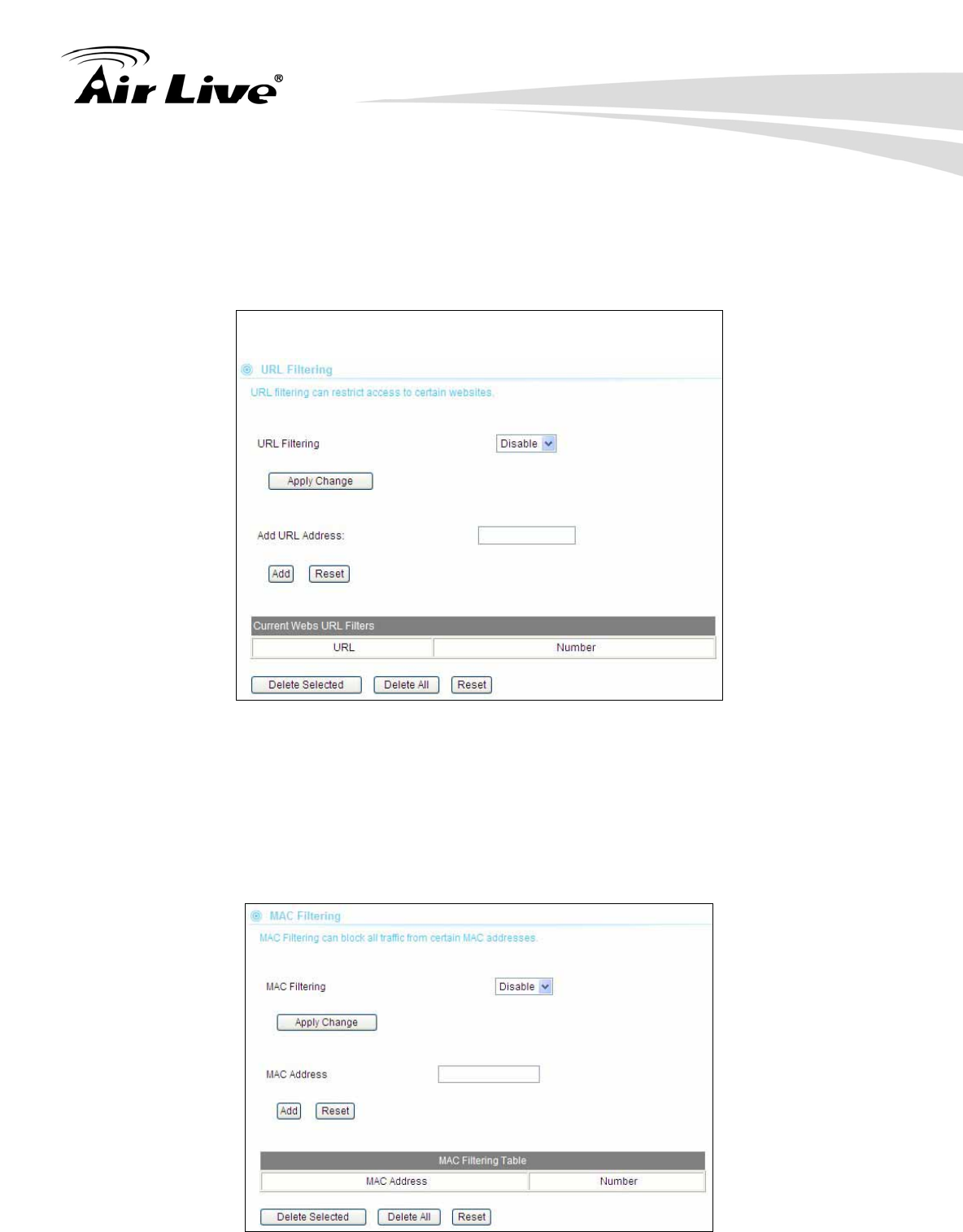
4. Configuration: Router Mode
27 AirLive N.Power User’s Manual
4.2.5 URL Filtering
Internet Settings -> URL Filtering
The N.Power provides URL filter function to stop access to certain website. It is useful for
parents to stop children from accessing some websites.
4.2.6 MAC Filtering
Internet Settings -> MAC Filtering
MAC filter can filter out traffic from certain MAC addresses. It can prevent access to
internet from certain stations in the local LAN. Please enter the MAC address in
XX-XX-XX-XX-XX format. For example: 00-4F-66-11-22-33
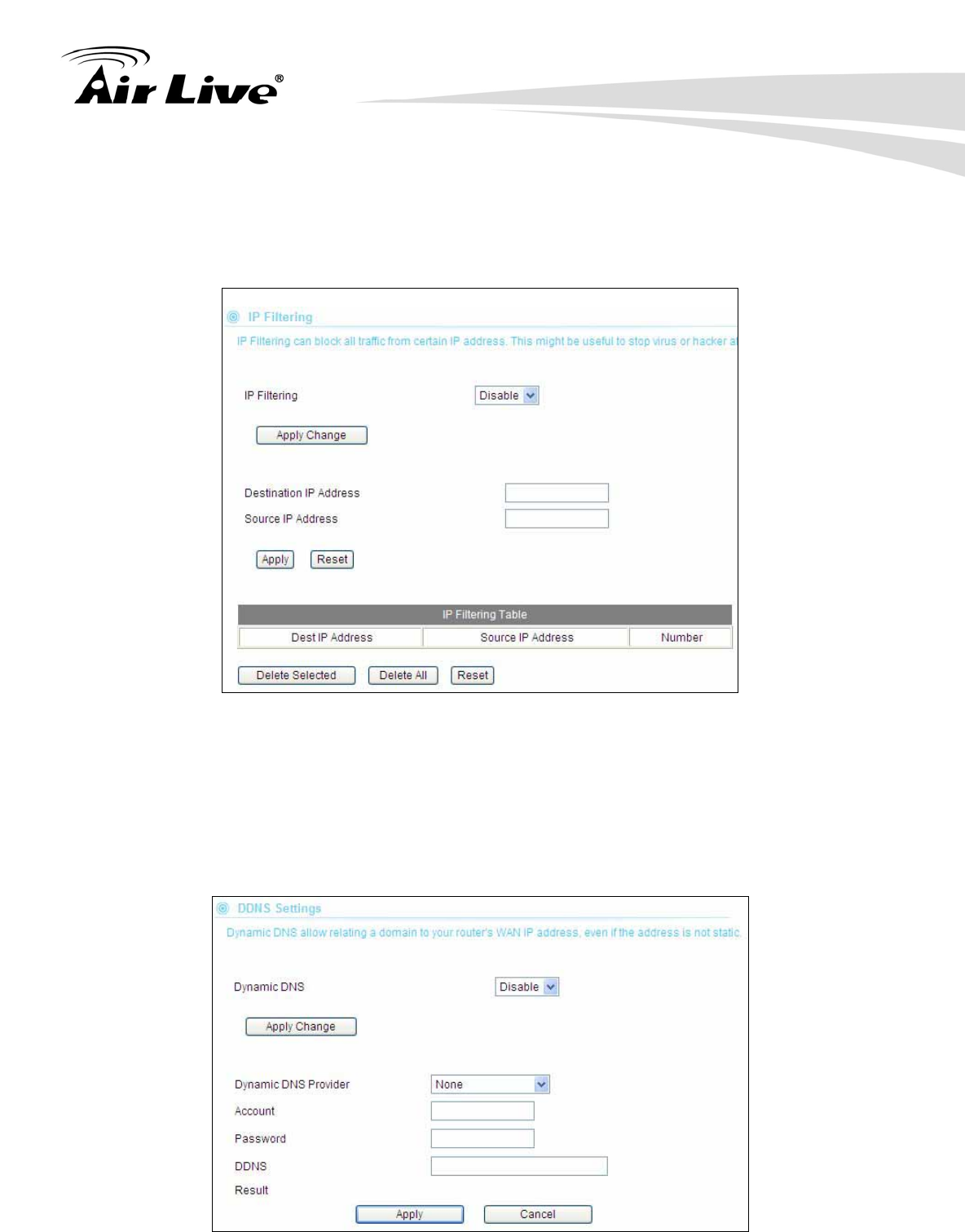
4. Configuration: Router Mode
AirLive N.Power User’s Manual 28
4.2.7 IP Filtering
Internet Settings -> IP Filtering
IP filtering allows you to block certain IP addresses from accessing the network.
4.2.8 DDNS
Internet Settings -> DDNS
Dynamic Domain Name System. An algorithm that allows the use of dynamic IP address for
hosting Internet Server. A DDNS service provides each user account with a domain name.
The N.Power support “Dyndns.org”, “zoneedit.com” and “no-ip.com” service.
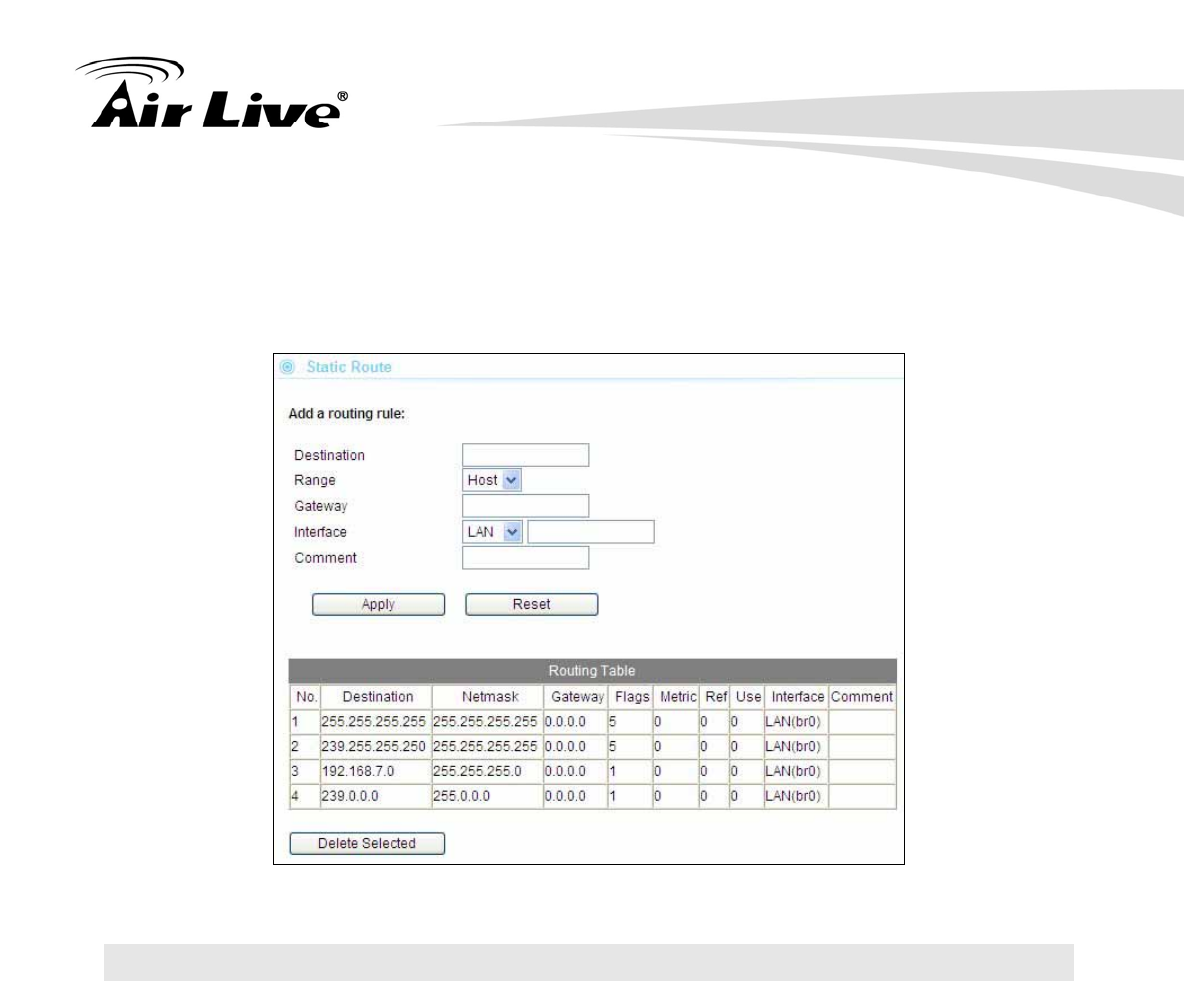
4. Configuration: Router Mode
29 AirLive N.Power User’s Manual
4.2.9 Static Route
Internet Settings -> Static Route
Static Route allows you to setup the routing table manually.
4.3 FTP Function
The N.Power supports file sharing through FTP function. Before you start, please notice
the following requirements and restrictions for FTP function.
The FTP function is only available in Router mode
The FTP functions only support file names with western alphabets (such as
English).
The N.Power support anonymous or password FTP accounts. Up to 3 password
accounts are supported.
The FTP configuration can be found in the “Internet Settings” menu. By default, it is
disabled. You must enable the option to start FTP. Please remember to click on “Apply”
button after finish settings.
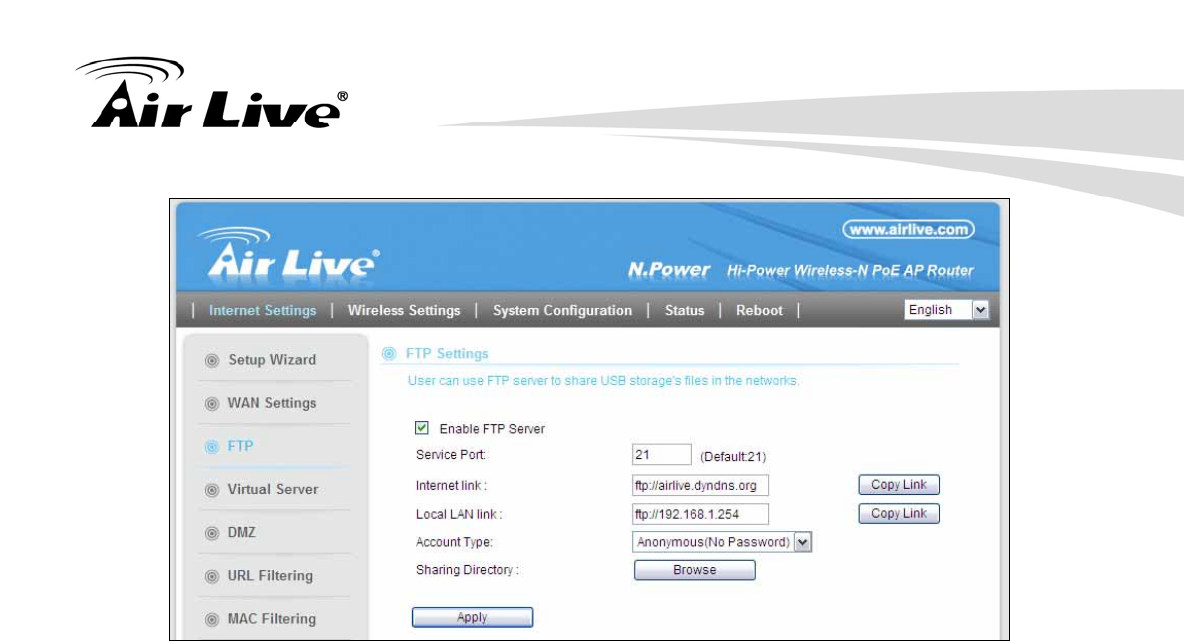
4. Configuration: Router Mode
AirLive N.Power User’s Manual 30
Enable FTP Server: By default, the FTP server is disabled. Please enable by
checking the box and press “Apply” button.
Service Port: You can change the TCP/UDP port for FTP access here. The
default is port 21; it is advised to leave the settings at default. When you change
the service port, the FTP link will also change. For example, if you change
service port to 2121. The LAN FTP Link will become ftp://192.168.1.254:2121.
Internet Link: The N.Power will automatically display the Internet FTP link so
you can copy and email to your friends for access. This link is for FTP access via
Internet.
Local LAN Link: This is the link on the local LAN where you can access the
content of the FTP file sharing. Press the “Copy Link” button and paste it to your
browser for access.
Account Type: There are 2 different FTP account types.
Anonymous (No Password): There is no password protection for this
account type. Anyone can access the FTP directory. The access is “Read
only”. That means you can download files but not upload.
Password: Up to 3 users account can be configured. Each requires
username and password to access. Each user can have different sharing
directory. You can choose “Read” and/or “Write” access for each account
type. When you choose the “Password” Account Type. The following
“Account Table” will appear:
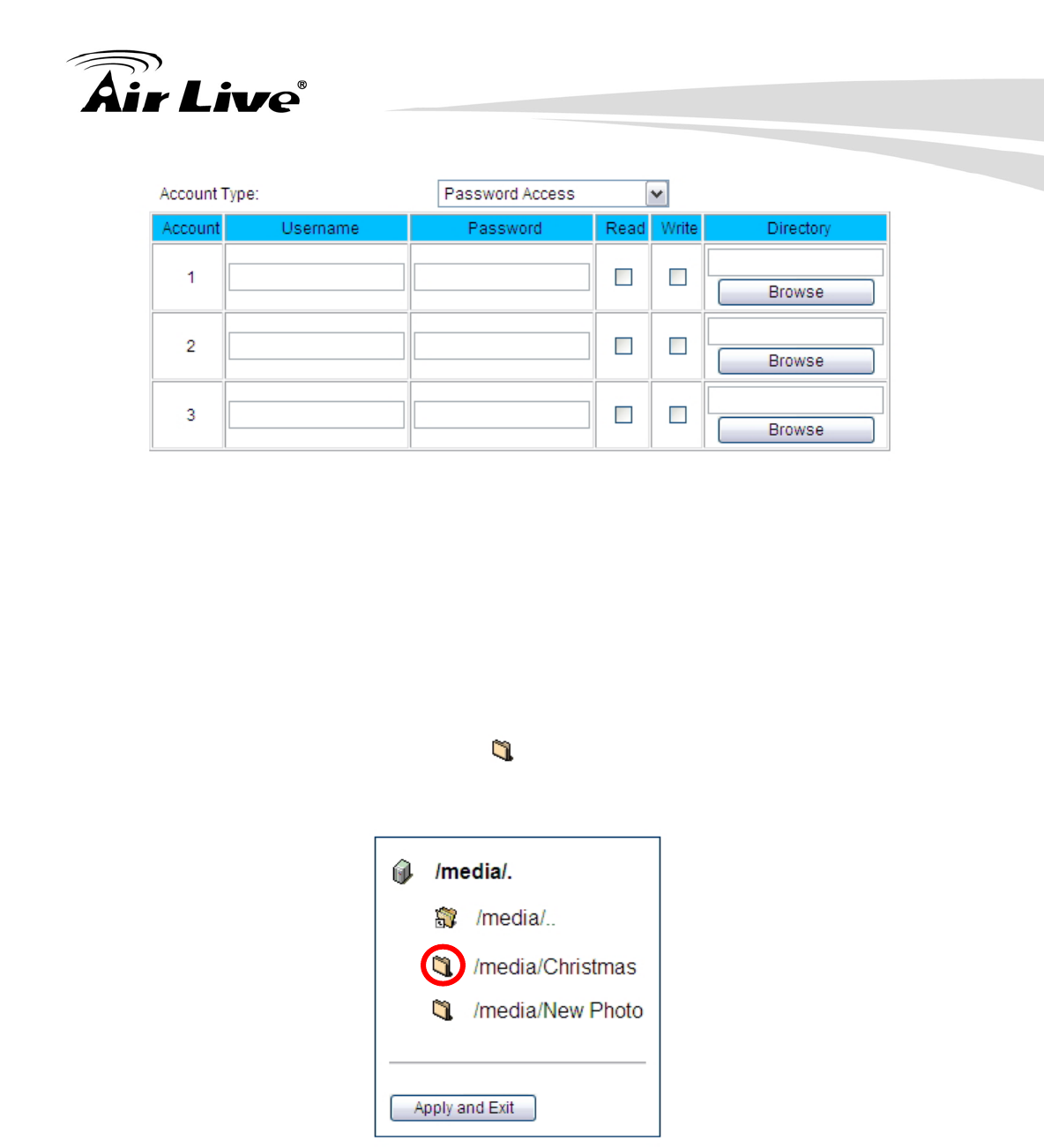
4. Configuration: Router Mode
31 AirLive N.Power User’s Manual
Username: Name of the user’s account
Password: The password required for FTP access
Read: The ability to read/download from the N.Power. This should be turned
on
Write: The ability to write/upload files to the N.Power.
Directory: This will determine the sharing directory for N.Power. You can
enter the path manually (it starts with “/media/”), or click on the “Browse”
button to choose the directory. The N.Power can read into 5 levels of
directory depth.
Browse: You can choose a directory to share by using file browser. Please
click on the “Directory Icon” to navigate up and down the directory tree.
After finish, please click on “
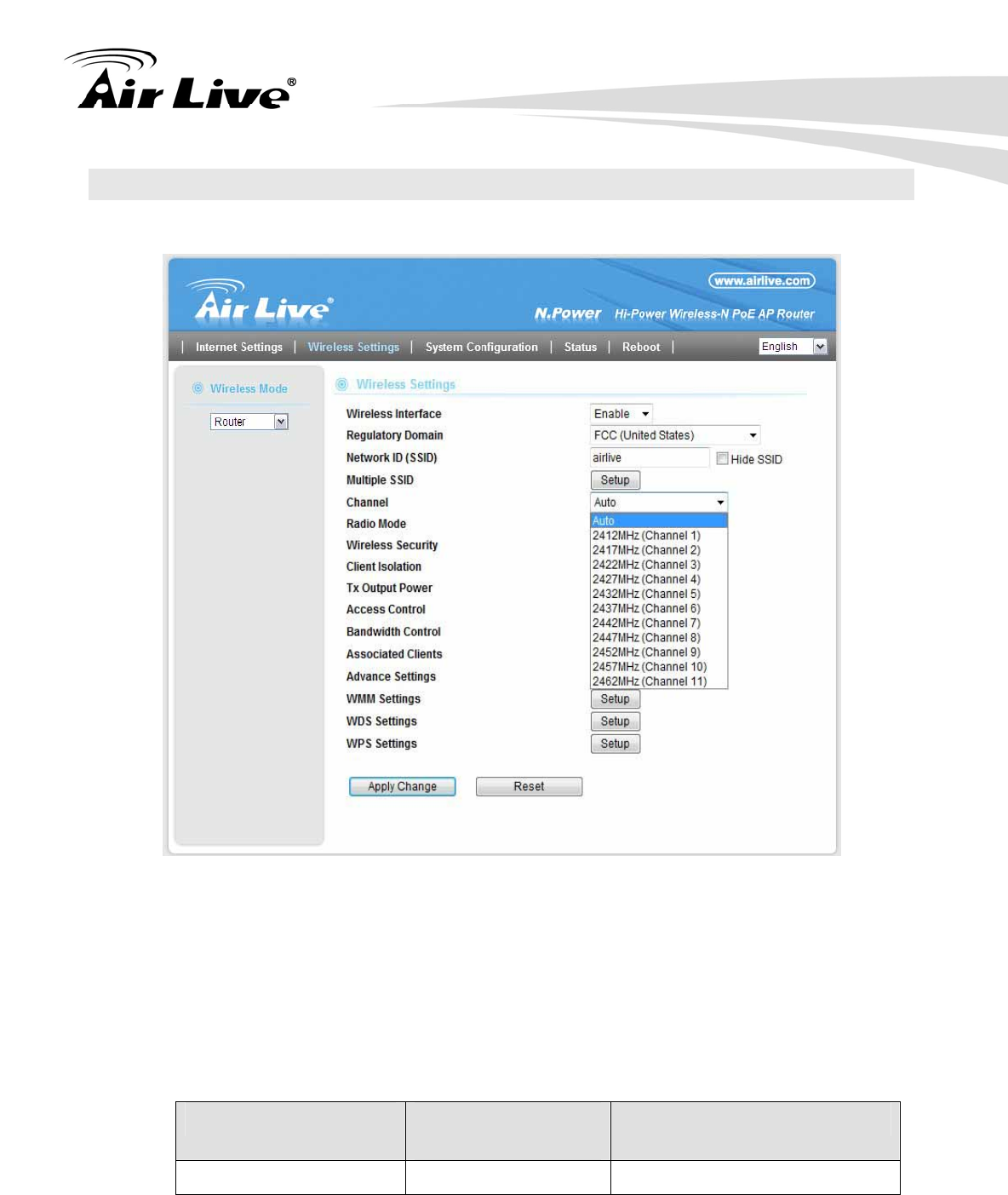
4. Configuration: Router Mode
AirLive N.Power User’s Manual 32
4.4 Wireless Settings Menu
When you select “Wireless Settings” on the top menu; the following screen will appear:
4.4.1 Regulatory Domain
Wireless Settings -> Regulatory Domain
The Regulatory Domain decides what channels and Tx output power levels are available
for your country. For the United States, the regulatory domain is FCC. FCC has the
following channel and power regulation.
Regulatory Domain Available
Channels Maximum Tx Output Power
FCC (United States) 1~11 23dBm
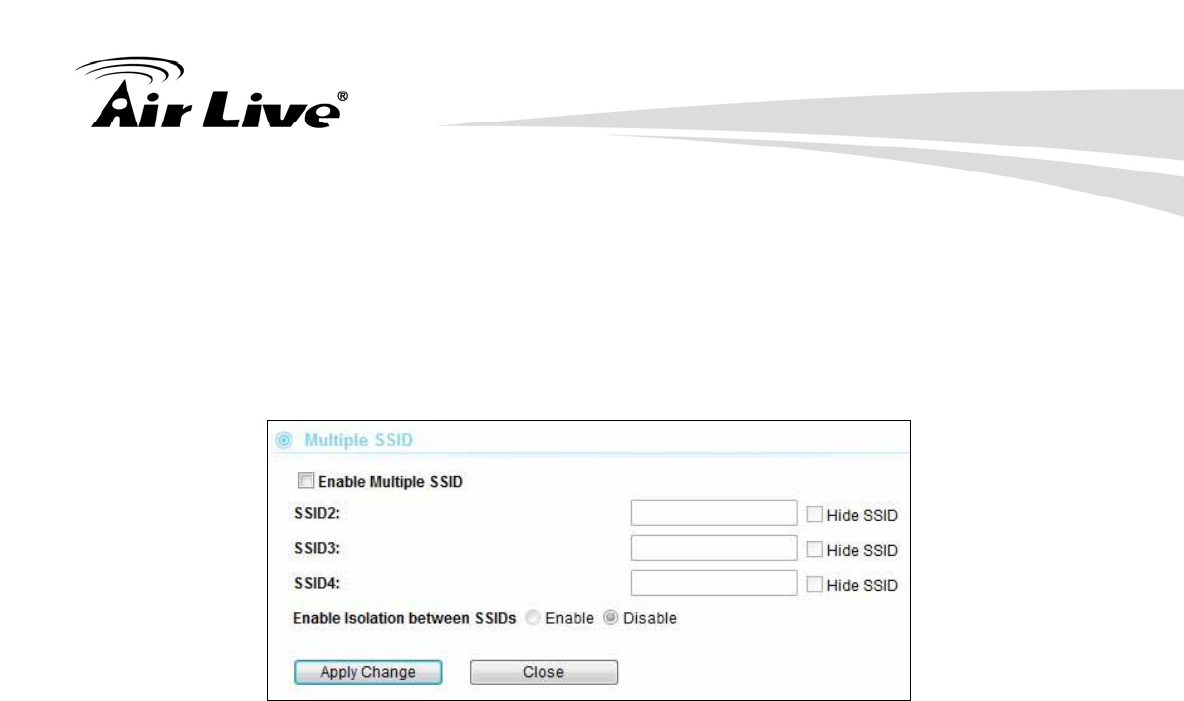
4. Configuration: Router Mode
33 AirLive N.Power User’s Manual
4.4.2 Multiple SSID
Wireless Settings -> Multiple SSID
Multiple SSID allows N.Power to create up to 4 different wireless networks (SSID). It is
also known as “Virtual AP” function. Each SSID can have its Encryption policy. The
SSID1 is the main SSID under Wireless Setting page.
Hide SSID: The wireless network will become invisible, only accessible to people who
knows the SSID name.
Enable Isolation between SSIDs: Enable this option will disable traffic between
different SSIDs.
4.4.3 Channel
Wireless Settings -> Channel
The channel is the frequency range used by radio. In 802.11g/b standard, there are
maximum of 14 Channels. However, the available channels in each country are
dependant on the local regulation. For the United States, you can use channel 1 to 11.
Each wireless channel takes between 22 to 25MHz of frequency width. But the channels
are only 5MHz apart. Therefore, only every 5 channels can be free of interference with
each other. It is recommended that you can do a site survey to find about what channels
are used by surrounding AP and choose a channel that is not used by other APs.
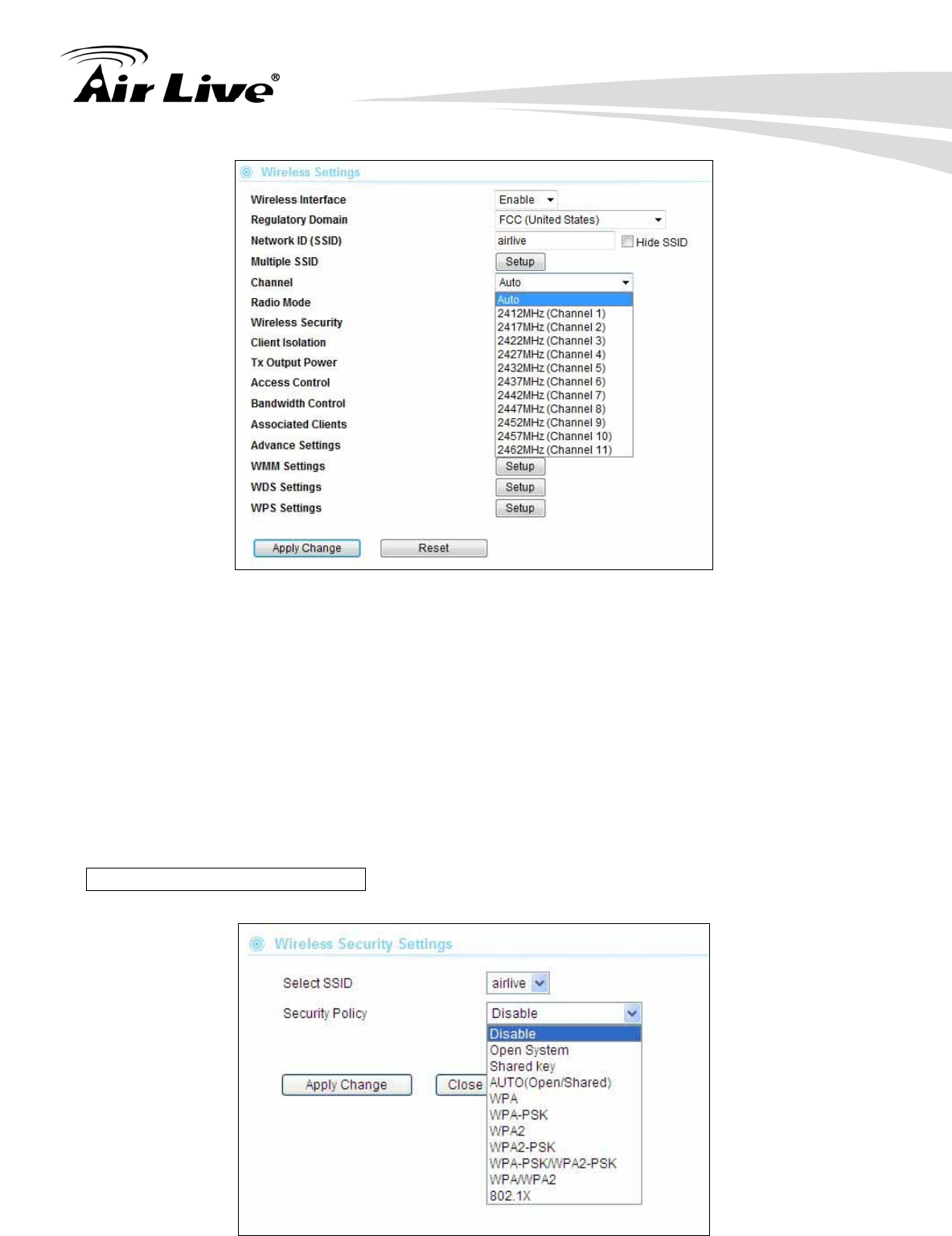
4. Configuration: Router Mode
AirLive N.Power User’s Manual 34
4.4.4 Wireless Security
Wireless Settings -> Wireless Security
You should set up the wireless security immediately to ensure the security of your data
transmission and to prevent the unauthorized access. The easiest way to setup encryption
is to use the “Setup Wizard”. It automatically chooses the most secured and easiest
scheme for your wireless security settings. However, if you wish to choose your own
encryption scheme, the N.Power offers various type of encryption including WEP,
WPA-PSK, WPA, WPA2, WPA2-PSK encryptions method. In general, the WPA-PSK and
WPA2-PSK are the most popular and secured encryption scheme.
Procedure to make encryption
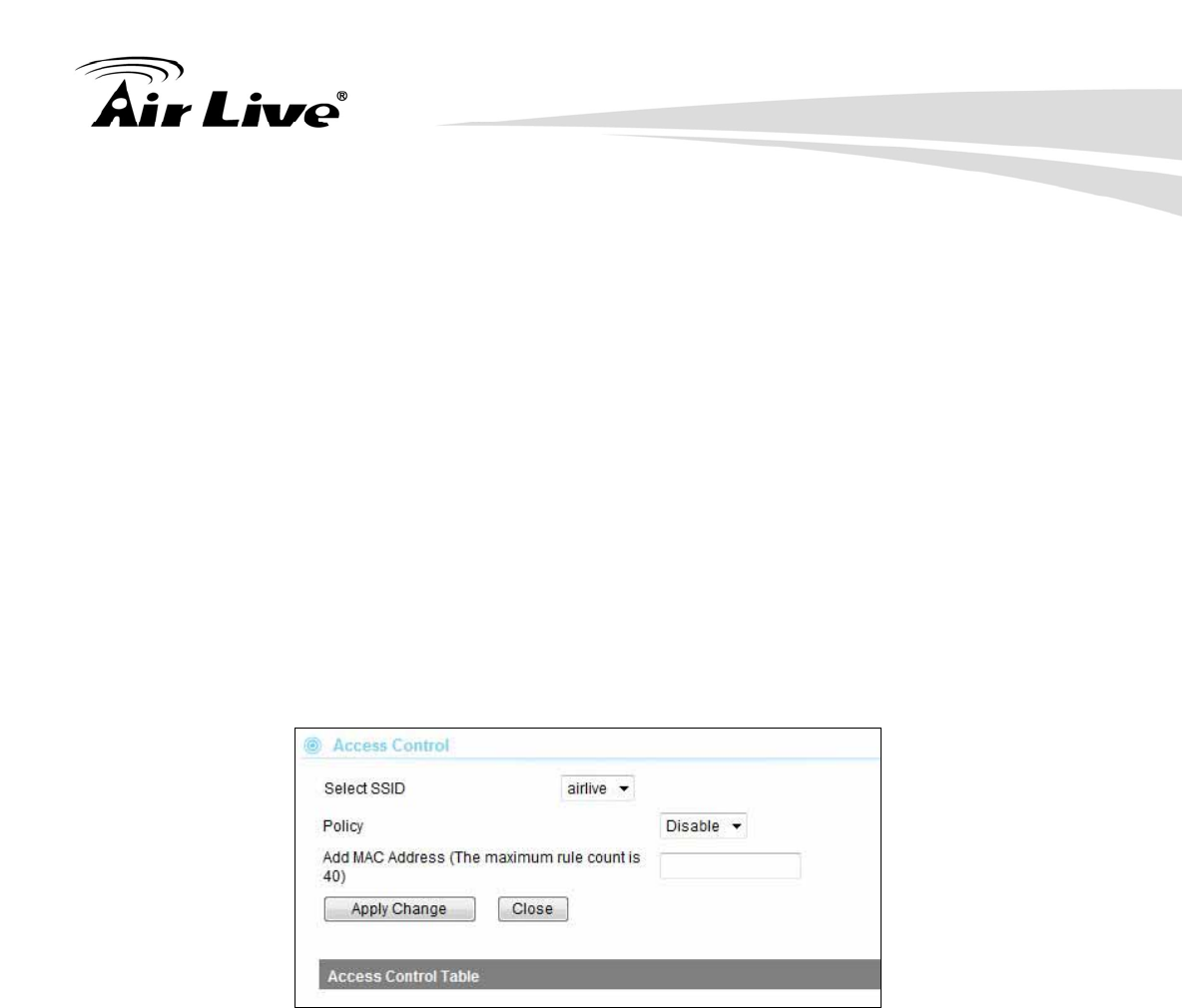
4. Configuration: Router Mode
35 AirLive N.Power User’s Manual
Step1: Select your SSID: If you have enabled the “Multiple SSID” function, there will
be more than one SSID to choose from. Each SSID (Virtual AP) can have its own
security policy.
Step2: Select Security Policy: N.Power offers a full suite of security policy including
WEP(Pre-Shared Key), WPA(certificate), WPA-PSK(AES), WPA2-PSK(AES), and
802.1x Radius Authentication. Recently WiFi regulation prevents the use of TKIP
encryption in 11n mode. Therefore, the TKIP is only available in 11b/g mode. We
highly recommend using WPA2-PSK AES Encryption as the easiest and much
secured scheme for encryption.
4.4.5 Access Control
Wireless Settings -> Access Control
The N.Power allows you to define a list of MAC addresses that are allowed or denied to
access the wireless network. This function is available only for Access Point and AP
Router modes. This function is available only for Access Point and Gateway modes.
Disable: When selected, no MAC address filtering will be performed.
Allow list: When selected, data traffic from only the specified devices in the
table will be allowed in the network.
Deny list: When selected, data traffic from the devices specified in the table
will be denied/discarded by the network.
4.4.6 Bandwidth Control
Wireless Settings -> Bandwidth Control
The N.Power can limit the bandwidth by IP address or MAC address. Please first enable
the Bandwidth Control, and then select IP Control or MAC Control.
Enable Bandwidth Control: Check this box and press “Apply Change” to
enable bandwidth control
IP Control: To limit the bandwidth of one single IP address.
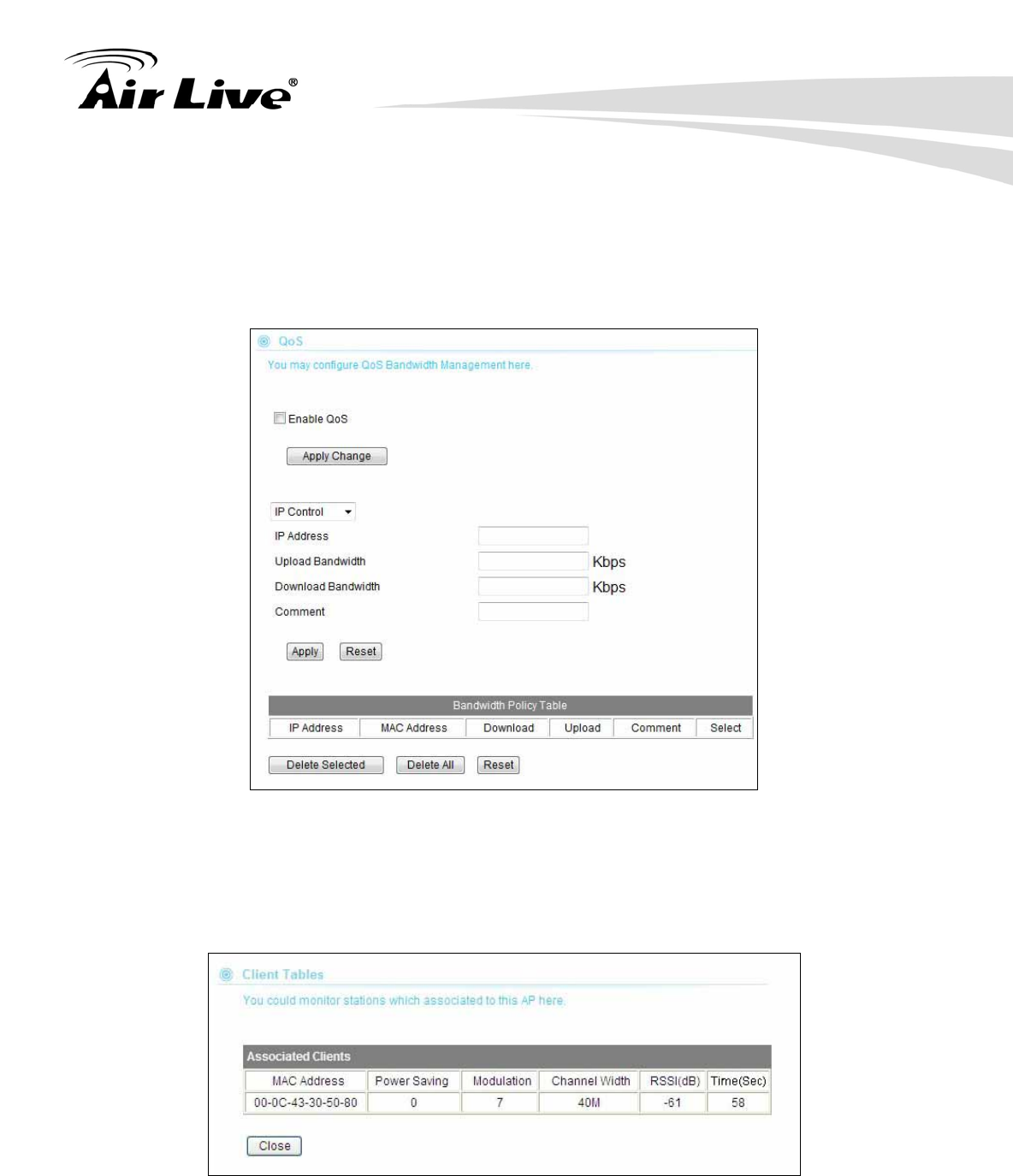
4. Configuration: Router Mode
AirLive N.Power User’s Manual 36
MAC Control: To limit the bandwidth of one single MAC address.
Upload Bandwidth: please input upstream bandwidth limit in Kbps
Download Bandwidth: please input downstream bandwidth limit in Kbps
Comment: note for the bandwidth policy
4.4.7 Associated Client
Wireless Settings -> Associated Client
You can check the wireless clients’ status on this table
MAC Address: MAC address of the wireless clients. If you need to find the IP
address, please go to Status->Client Table menu.
Power Saving: 0: The power saving mode is off. 1: The power saving mode is on.
Modulation: Show the which MCS level is used in 11n mode.
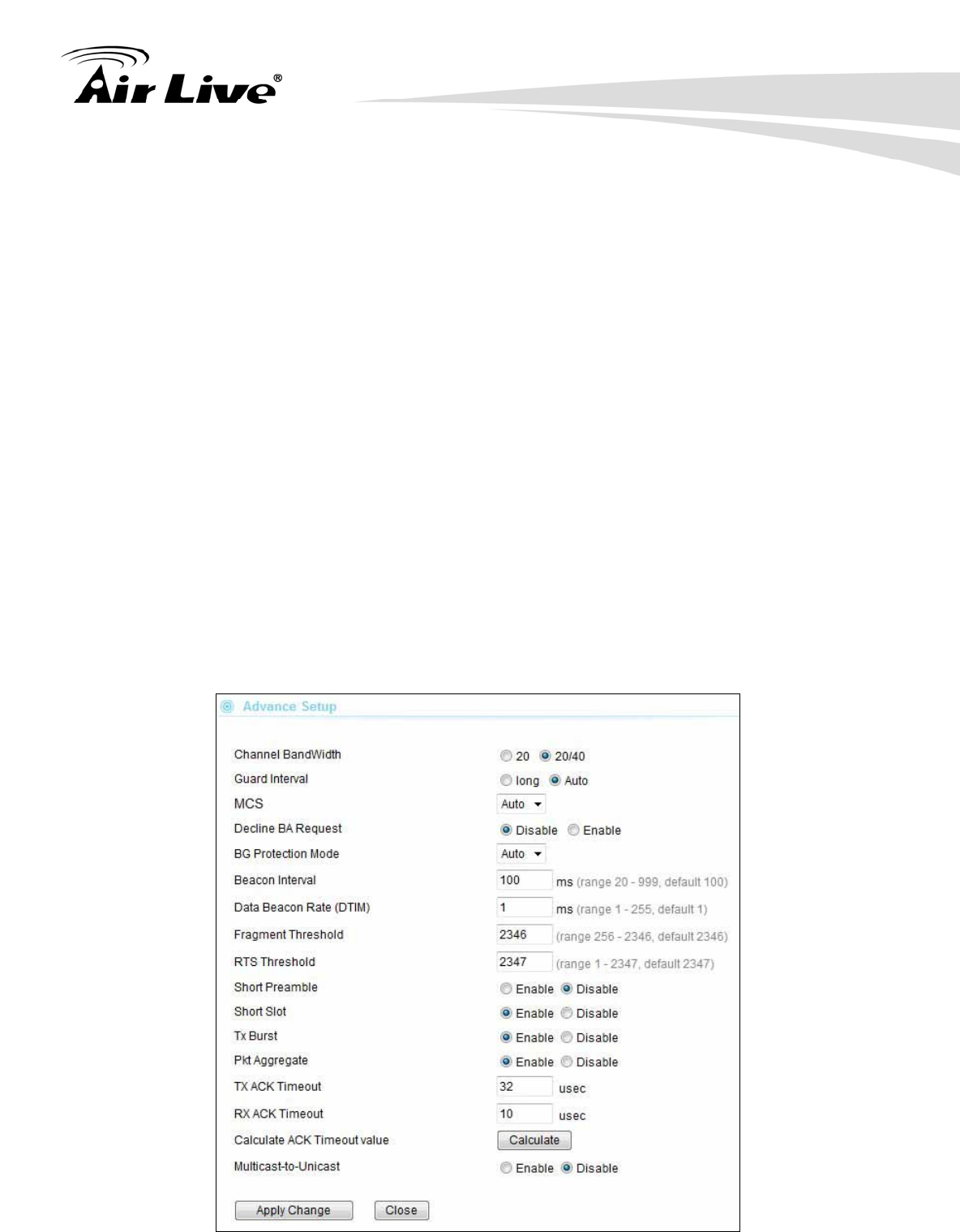
4. Configuration: Router Mode
37 AirLive N.Power User’s Manual
Channel Width: This indicates whether client is using 20MHz or 40MHz channel
width.
RSSI (dBm): The signal strength of the client device.
Time (Sec): The connected time of the wireless client.
4.4.8 Advanced Settings
Wireless Settings -> Advance Settings
Channel Width: You can choose 20MHz or 20/40MHz channel width. Choose
20MHz for compliance with laws in some countries. 40MHz offers faster performance
than 20MHz
Guard Interval: Guard interval is placed at the beginning of each transmission. It is
used to reduce the interference effect of multi-path transmissions. The use of long
Guard Interval may perform better in interference or multipath environment. However,
it can reduce the performance.
MCS (Modulation and Code Scheme): MCS level for the 11n mode. It is
recommended to leave it at Auto.

4. Configuration: Router Mode
AirLive N.Power User’s Manual 38
Decline BA Request: Enable this option to decline the Block ACK requests by other
devices.
BG Protection: The 802.11g standard includes a protection mechanism to ensure
mixed 802.11b and 802.11g operation. If there is no such kind of mechanism exists,
the two kinds of standards may mutually interfere and decrease network’s
performance.
Beacon Interval: The device broadcasts beacon frames regularly to announce its
existence. The beacon Interval specifies how often beacon frames are transmitted in
time unit of milliseconds. The default value is 100, and a valid value should be between
1 and 65,535.
Fragmentation: When the size of a unicast frame exceeds the fragmentation
threshold, it will be fragmented before the transmission. It should have a value of
256-2346 bytes, with a default of 2346. If you experience a high packet error rate,
you should slightly decrease the Fragmentation Threshold.
RTS Threshold: RTS/CTS frames are used to gain control of the medium for
transmission. Any unicast (data or control) frames larger than specified RTS threshold
must be transmitted following the RTS/CTS handshake exchange mechanism. The
RTS threshold should have a value between 256-2347 bytes, with a default of 2347. It
is recommended that this value does not deviate from the default too much.
Short Preamble: A preamble is a signal used in wireless environment to synchronize
the transmitting timing including Synchronization and Start frame delimiter. In a "noisy"
network environment, the Preamble Type should be set to Long Preamble. The Short
Preamble is intended for applications where minimum overhead and maximum
performance is desired. If in a "noisy" network environment, the performance will be
decreased.
Tx Burst and Packet Aggregate: These are the scheme used for improving the
performance of the data transmission in 11n and Turbo modes. It is recommended to
keep the settings on.
AckTimeOut: When a packet is sent out from one wireless station to the other, it will
wait for an Acknowledgement frame from the remote station. The station will only
wait for a certain amount of time; this time is called the ACK timeout. In most
conditions, please do not change the Tx and Rx Acktimeout value. The
N.Power’s default value is correct in most cases.
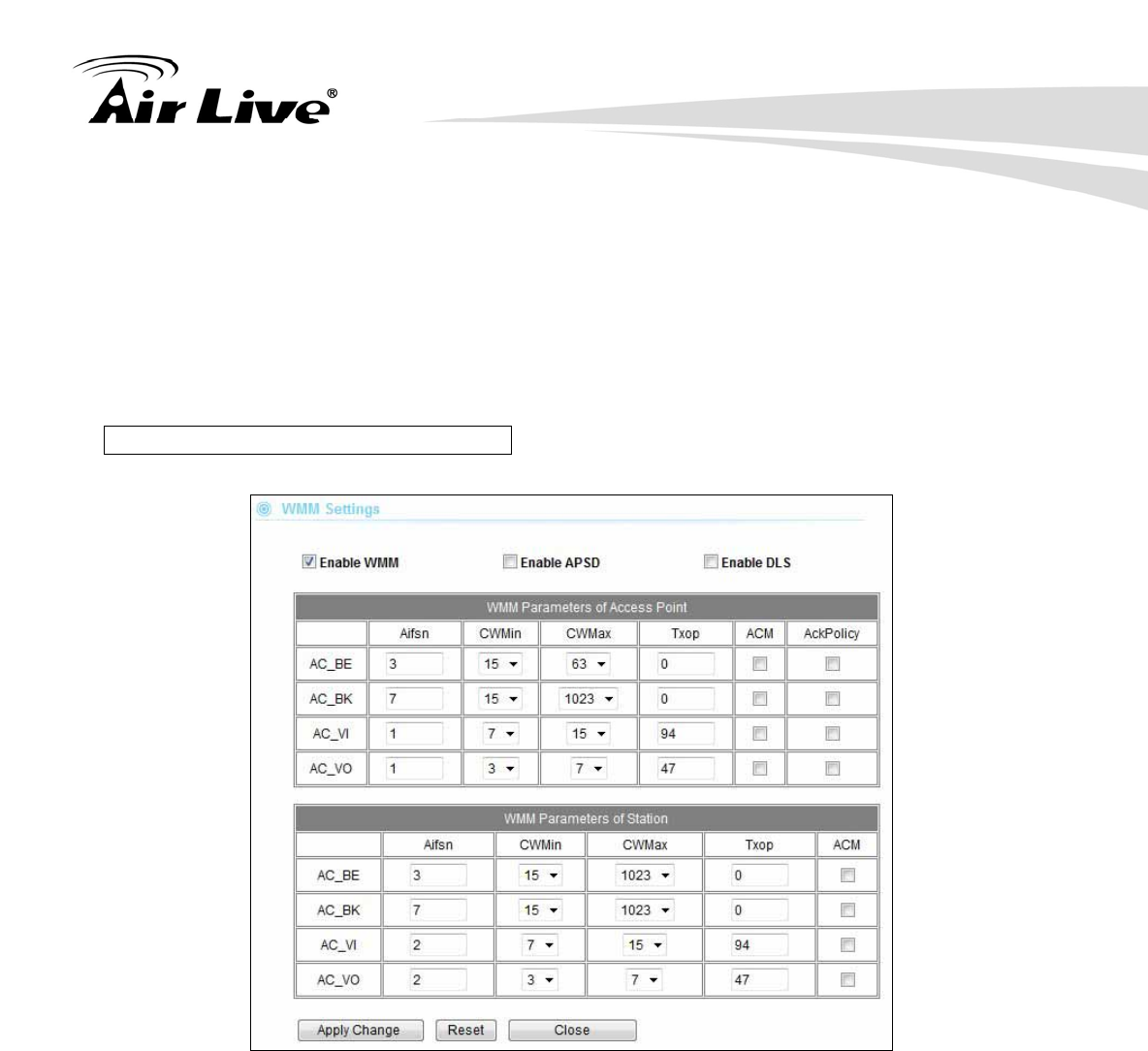
4. Configuration: Router Mode
39 AirLive N.Power User’s Manual
4.4.9 WMM Settings
Wireless Settings -> WMM Settings
Wi-Fi Multimedia (WMM) is a standard to prioritize traffic for multimedia applications. The
WMM Settings is to specify parameters on multiple data queue for better performance of
differentiated wireless traffic like Voice-over-IP (VoIP), other types of audio, video, and
streaming media as well as traditional IP data over the AP.
Configure the WMM QoS Parameters
AC Type
The queue and associated priorities and parameters for transmission are as follows:
Data 0 (Best Effort, BE): Medium priority queue, medium throughput and delay.
Most traditional IP data is sent to this queue.
Data 1 (Background, BK): Lowest priority queue, high throughput. Bulk data
that requires maximum throughput and is not time-sensitive is sent to this queue
(FTP data, for example):
Data 2 (Video, VI): High priority queue, minimum delay. Time-sensitive data
such as Video and other streaming media are automatically sent to this queue.
Data 3 (Voice, VO): Highest priority queue, minimum delay. Time-sensitive
data such as Voice over IP (VoIP) is automatically sent to this queue.

4. Configuration: Router Mode
AirLive N.Power User’s Manual 40
Packets in a higher priority queue will be transmitted before packets in a lower
priority queue.
ECWmin and ECWmax
If an access point detects that the medium is in use, it uses the DCF random backoff
timer to determine the amount of time to wait before attempting to access a given
channel again. Each access point waits some random period of time between retries.
The wait time (initially a random value within a range specified as the Minimum
Contention Window increases exponentially up to a specified limit Maximum
Contention Window.
The random delay avoids most of the collisions that would occur if multiple APs got
access to the medium at the same time and tried to transmit data simultaneously. The
more active users you have on a network, the more significant the performance gains
of the backoff timer will be in reducing the number of collisions and retransmissions.
The random backoff used by the access point is a configurable parameter. To describe
the random delay, a "Minimum Contention Window" (ECWMin) and a "Maximum
Contention Window" (ECWMax) is defined.
ECWmin: The value specified for the Minimum Contention Window is the
upper limit of a range for the initial random backoff wait time. The number used
in the random backoff is initially a random number between 0 and the number
defined for the Minimum Contention Window.
ECWmax: If the first random backoff time ends before successful
transmission of the data frame, the access point increments a retry counter, and
doubles the value of the random backoff window. The value specified in the
Maximum Contention Window is the upper limit for this doubling of the random
backoff. This doubling continues until either the data frame is sent or the
Maximum Contention Window size is reached.
AIFS
The Arbitration Inter-Frame Spacing (AIFs) specifies a wait time (in milliseconds) for
data frames. 802.11e uses interframe spaces to regulate which frames get access to
available channels and to coordinate wait times for transmission of different types of
data. The AIFs ensures that multiple access points do not try sending data at the same
time but instead wait until a channel is free. Valid values for AIFs are 1 through 255.
Transmission Opportunity
The Transmission Opportunity (TXOP) is an interval of time when a WMM client station
has the right to initiate transmissions onto the wireless medium. This value specifies
(in milliseconds) the Transmission Opportunity (TXOP) for client stations; that is, the
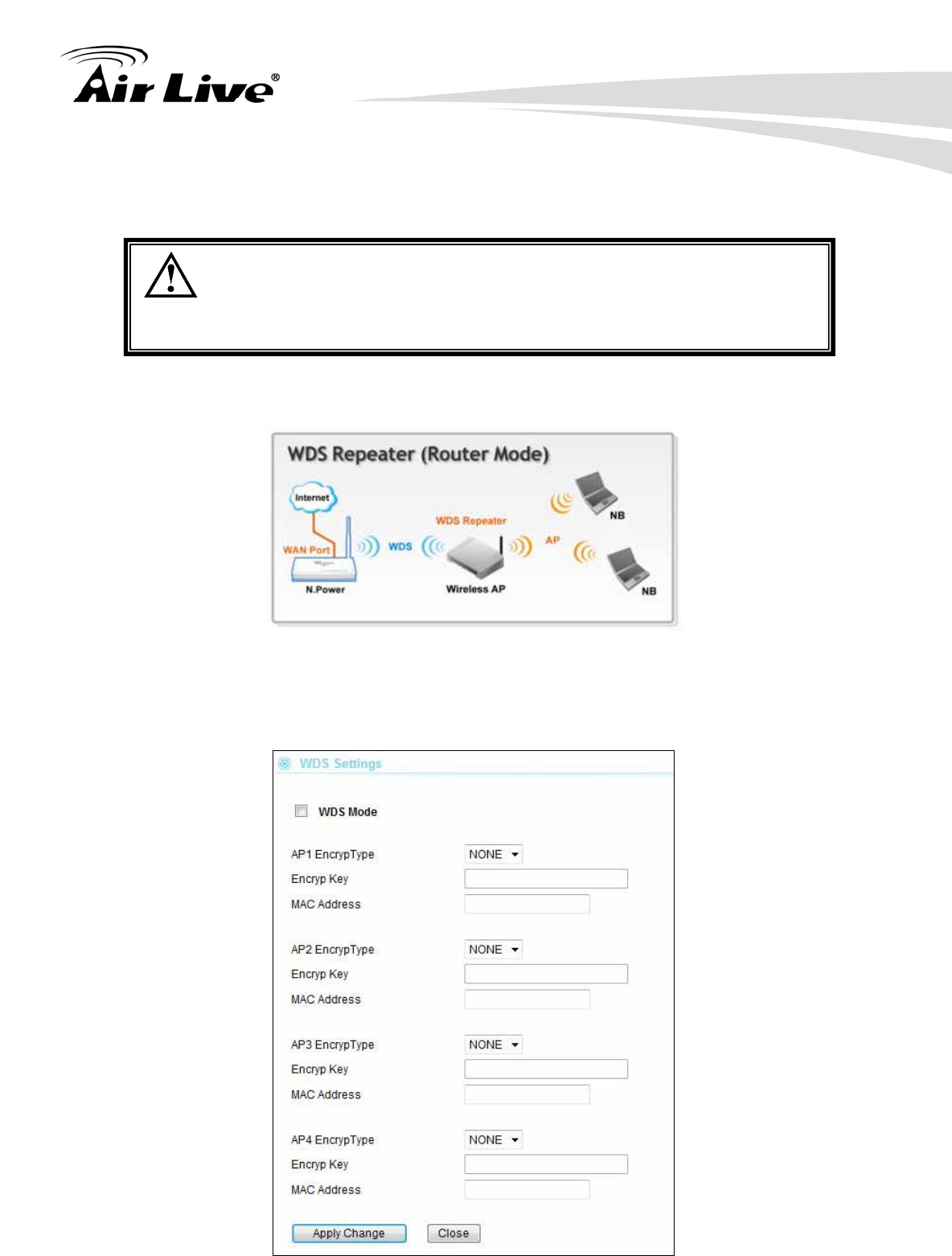
4. Configuration: Router Mode
41 AirLive N.Power User’s Manual
interval of time when a WMM client station has the right to initiate transmissions on the
wireless network.
We recommend that you use the default settings on the WMM QoS
page. Changing these values can lead to unexpected blockages of
traffic on your wireless LAN, and the blockages might be difficult to
diagnose.
4.4.10 WDS Settings (Repeater)
This is known as WDS Repeater function. Enable this setting to allow remote WDS
equipped AP to extend the wireless signal of N.Power. Up to 4 WDS repeaters can be
connect with N.Power. WDS works by entering the wireless MAC addresses (also known
as BSSID) of remote Access Points.
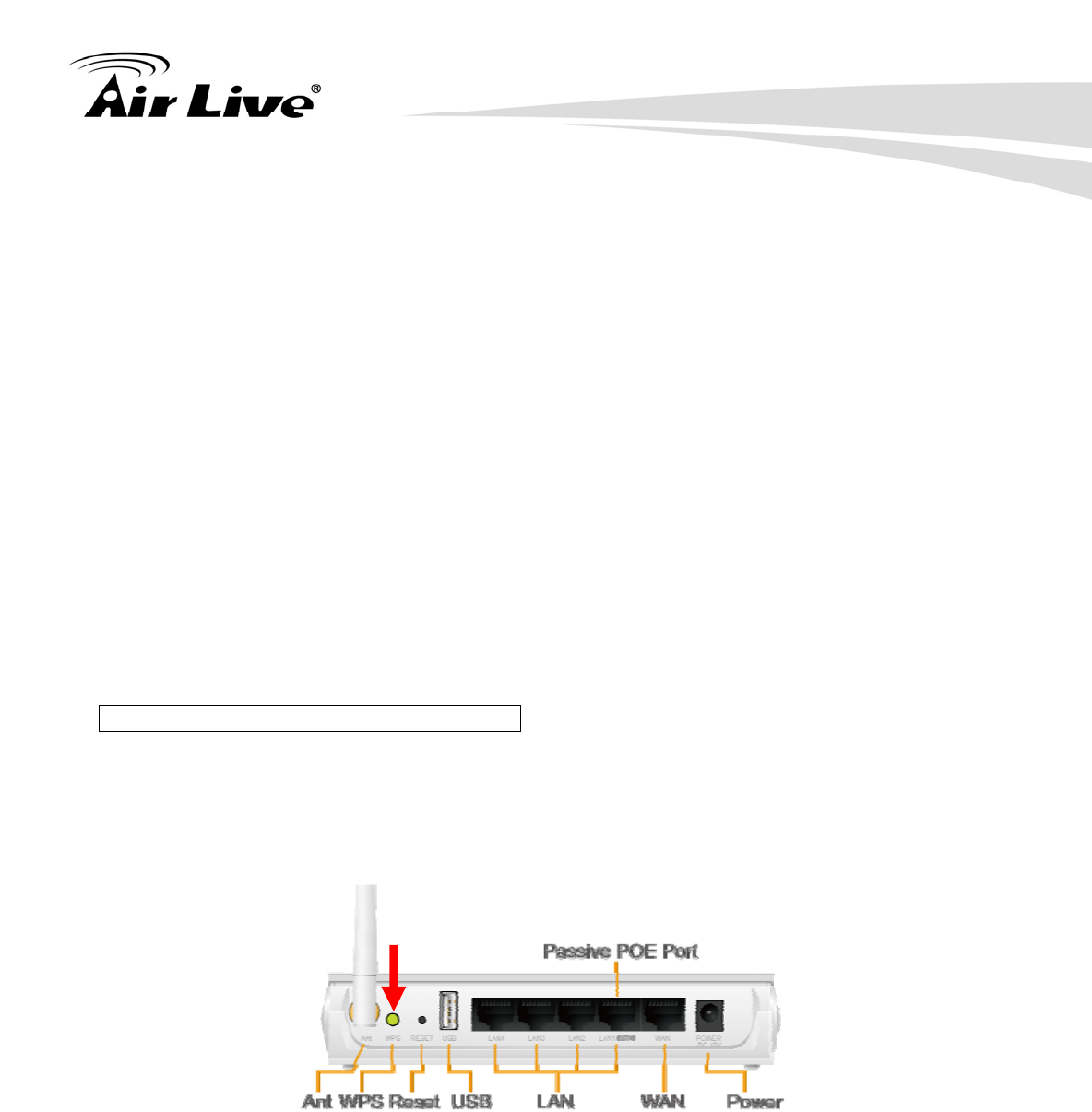
4. Configuration: Router Mode
AirLive N.Power User’s Manual 42
Encryp Type: You can use one of the following 4 encryption type.
None: No encryption is made. This is not recommended as it posts serious
security issue.
WEP: This is the most compatible type. However, it is also easier for
hackers to break. Use this only if AES or TKIP doesn’t work.
TKIP: Temporal Key Integrity Protocol, TKIP is more secured than WEP but
less secure than AES.
AES: The most secured encryption method. It is highly recommended to
use this method unless for compatibility issue.
Encryp Key: Please enter your encryption key here.
MAC Address: Please enter the Wireless MAC address or BSSID of the remote
Bridge. You can usually find it at remote Bridge’s device label.
4.4.11 WPS Settings
Example1: Using Hardware Push button
Please push WPS button directly on the back of the N.Power. The “WPS” LED flash will
light and the N.Power will start to survey the client’s WPS signal in the current environment.
Please be noticed that, within two minutes, you have to turn on the utility of your wireless
network card and click PBC to connect automatically.
If you also have a hardware WPS button on your wireless card, you can push the button
immediately now. If not, you can usually find the WPS PBC function in the wireless utility.
Below is an example using AirLive WN-360USB wireless network card to connect with
N.Power.
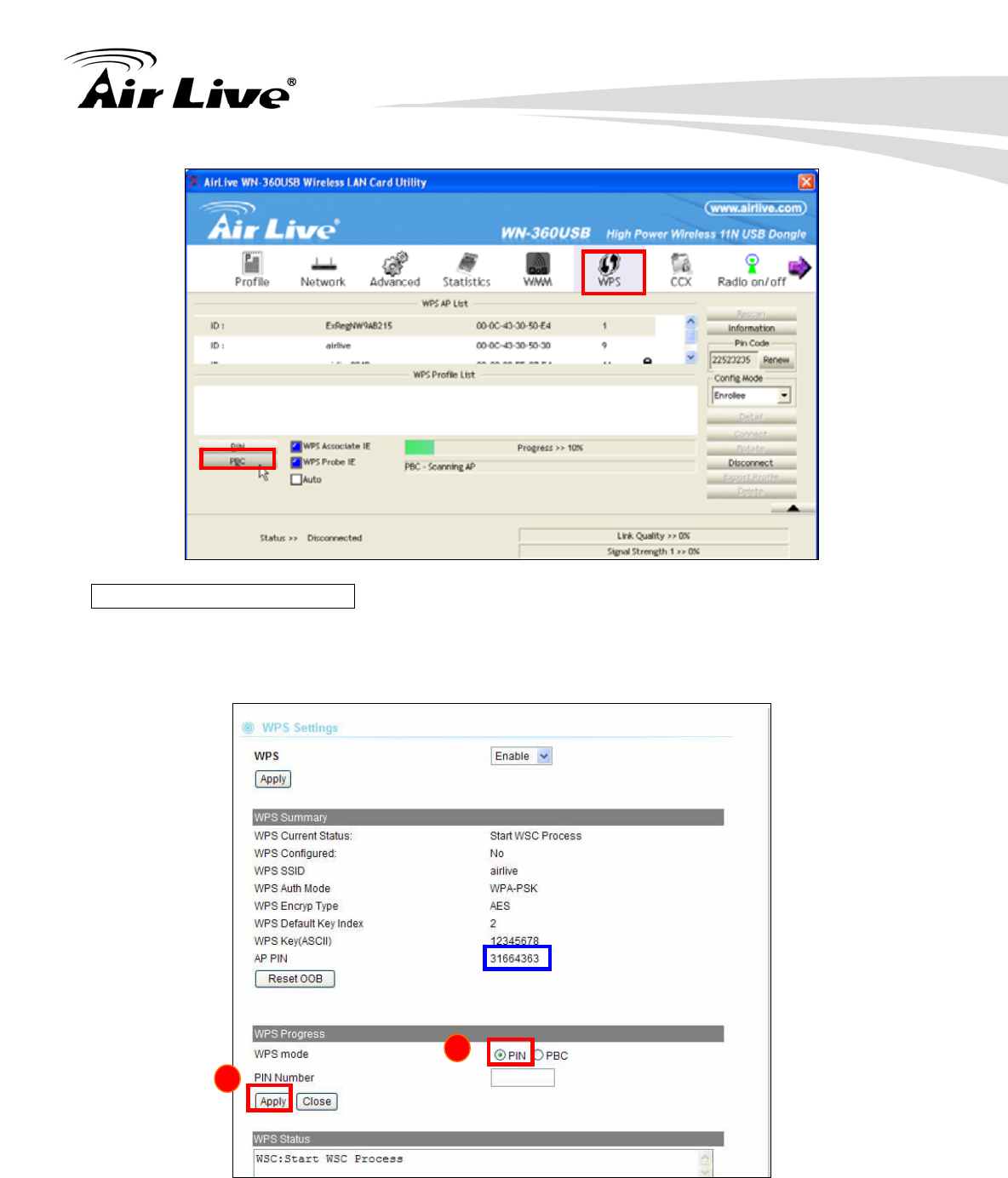
4. Configuration: Router Mode
43 AirLive N.Power User’s Manual
Example 2: WPS Using PIN
Please login N.Power’s Web UI. Select Wireless Setting Æ WPS Setting. In the WPS
Progress, select “PIN” then “Apply.” You will get a PIN Code.
Then, please turn on the utility of your wireless network card. Choose WPS mode to
“Registrar” and enter the PIN Code. Press “PIN” and the connection will automatically
configure.
6
7
PIN Code
1
2
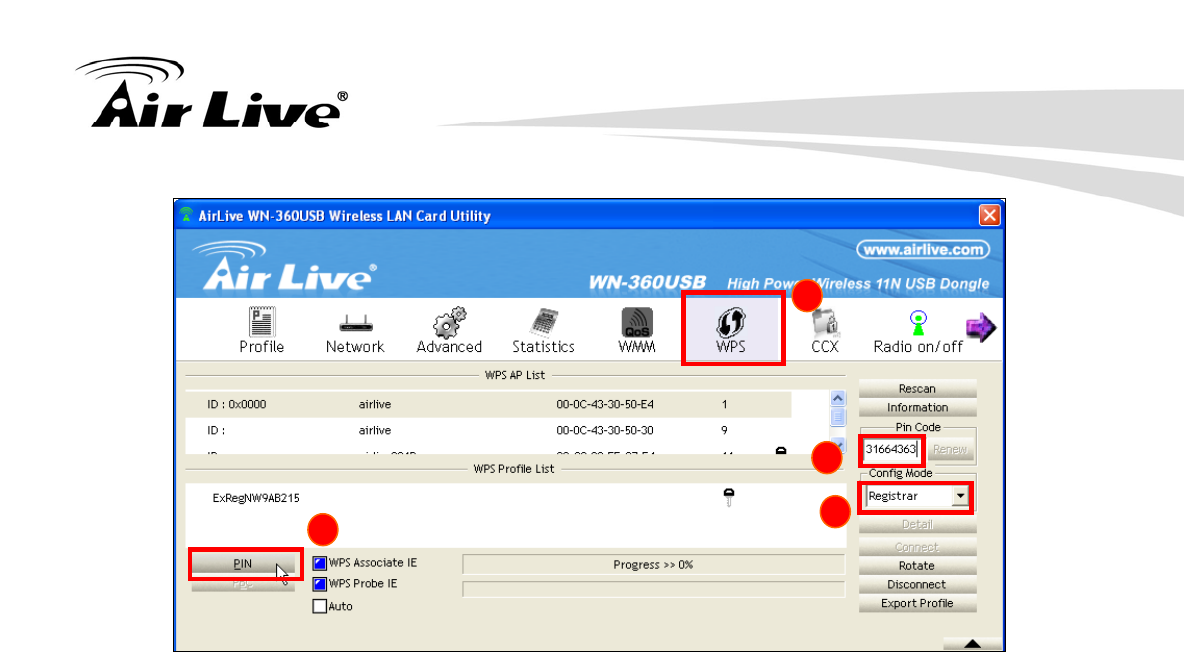
4. Configuration: Router Mode
AirLive N.Power User’s Manual 44
3
4
5
6
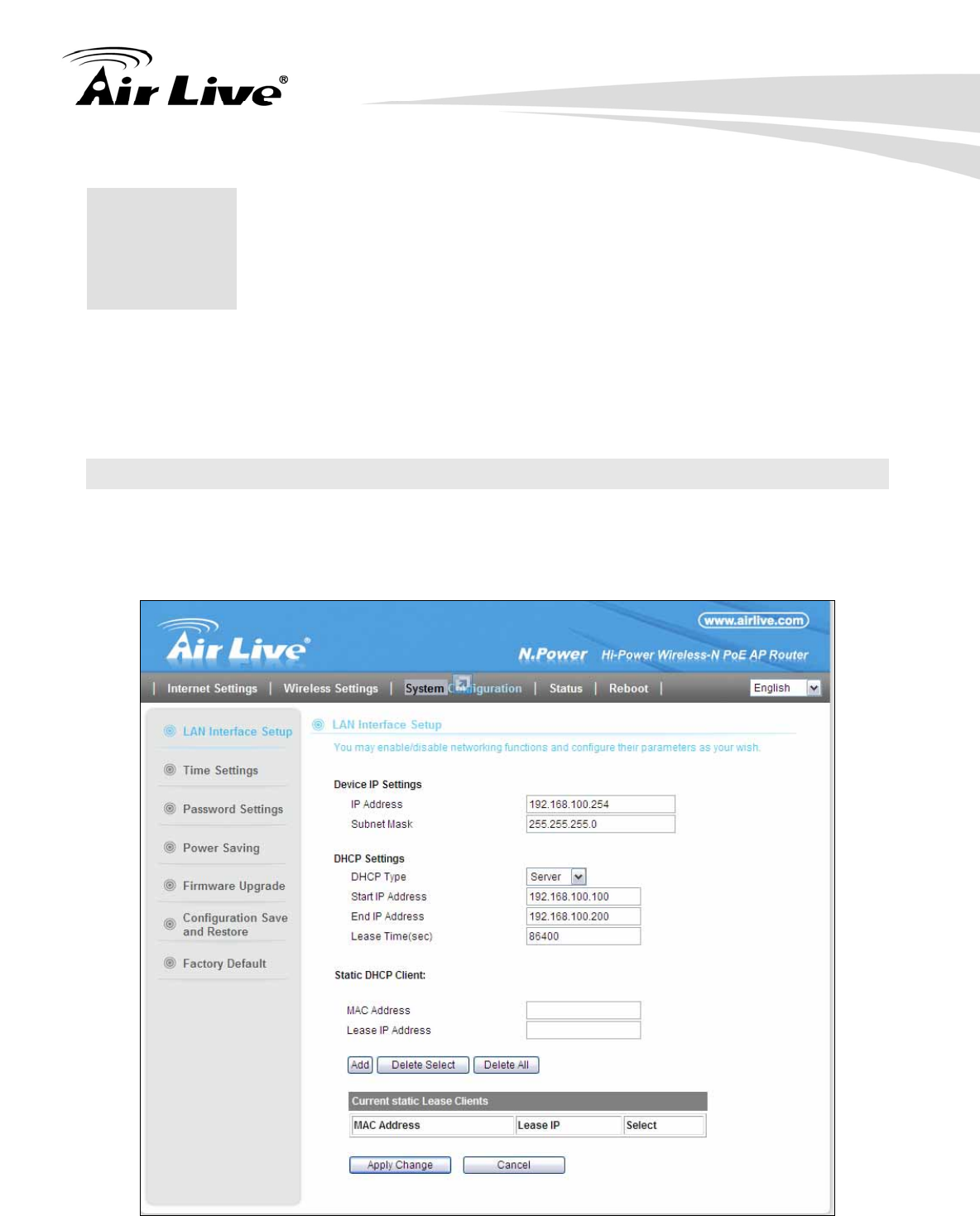
5. System Configuration and Status Menu
45 AirLive N.Power User’s Manual
In this chapter, we will explain about System Configurations Menu and the Status Menu of
the web management interface. Please be sure to read through Chapter 3’s “Introduction
to Web Management” first.
5.1 Menu Structure
When you click on the “System Configuration” menu on the top menu bar, the following
screen will appear. The system configuration includes all non-wireless settings. We will
explain their functions here.
5 5. System Configuration
and Status Menu
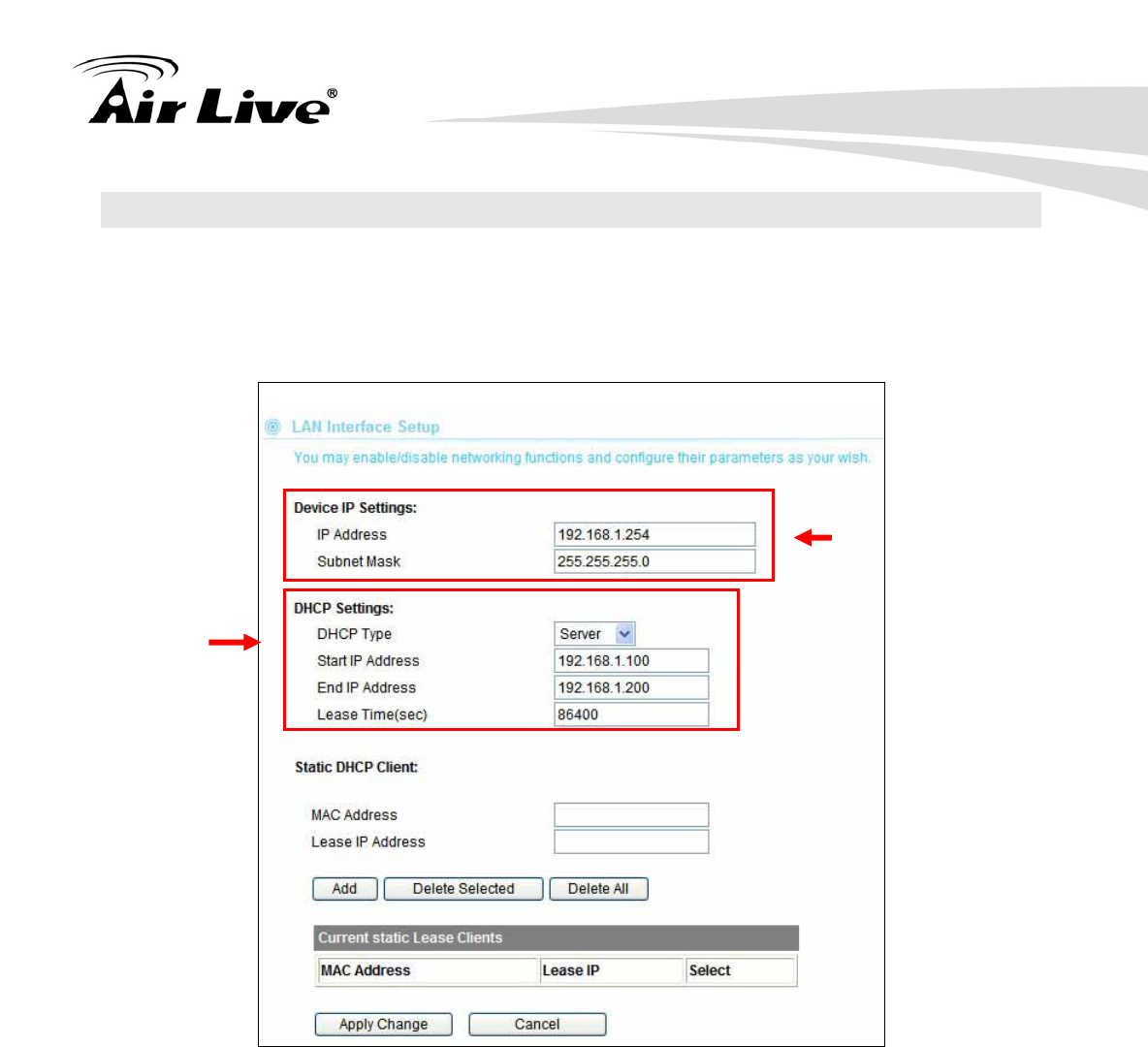
5. System Configuration and Status Menu
AirLive N.Power User’s Manual 46
5.2 LAN Interface Setup
System Configuration>> LAN Interface Setup
This menu is where you can configure all the aspect about LAN interface including IP
address, DHCP server settings...etc.
5.2.1 DHCP Settings
DHCP Service: You can enable or disable DHCP server here.
z Disable: Disable DHCP server. By default, the DHCP server is OFF
in AP, Client, and WDS Bridge mode.
z Server: The N.Power will act as DHCP server to provide IP addresses
to the clients on the LAN/Wireless interface. By default, the DHCP
server is on in router mode.
DHCP Client Range: You can define the IP pool from which the DHCP clients can
get IP address. Click on “Show Clients” to see the current DHCP client table.
Lease Time: You can define how long the N.Power will reserve IP address for a
particular PC or Devices here.
Device IP
Settings
DHCP
Settings
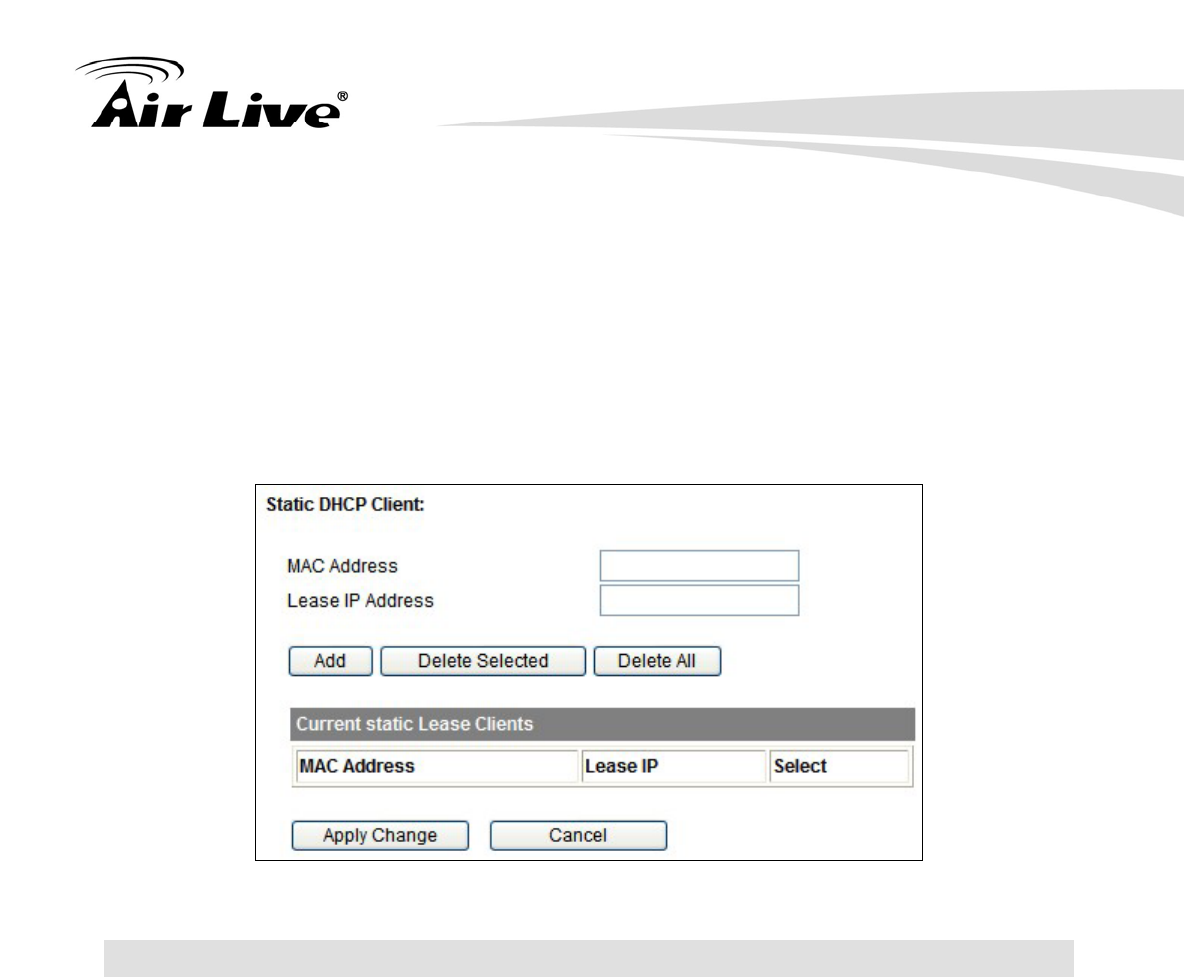
5. System Configuration and Status Menu
47 AirLive N.Power User’s Manual
5.2.2 Add DHCP Static Lease Client
If you want to lock IP address to a MAC address, you should add DHCP clients to the
“Static DHCP Client”. Up to 40 entries can be entered. Below is the procedure for
adding an entry:
5. 1. Enter the MAC address of the device
6. 2. Enter the IP address of the device
7. 3. Click on the “Add” button
5.3 Time Settings
System Configuration ->Time Settings
You can set the N.Power’s internal system clock by 2 methods. First is to enter the time
manually. Second is to set the time by NTP server. We strongly recommend setting the
time by NTP server because it will sync the time with remote server even after power
recycling. In another word, you will not lose time settings after power off.
Sync with Host: Push this button to copy the time from your PC
Time Zone: Select your nearby city here
NTP Server: This is the time server where your N.Power will sync the time with.
NTP Synchronization: How often your N.Power will sync the time with remote NTP
server.
Please remember to apply change after completing all settings.
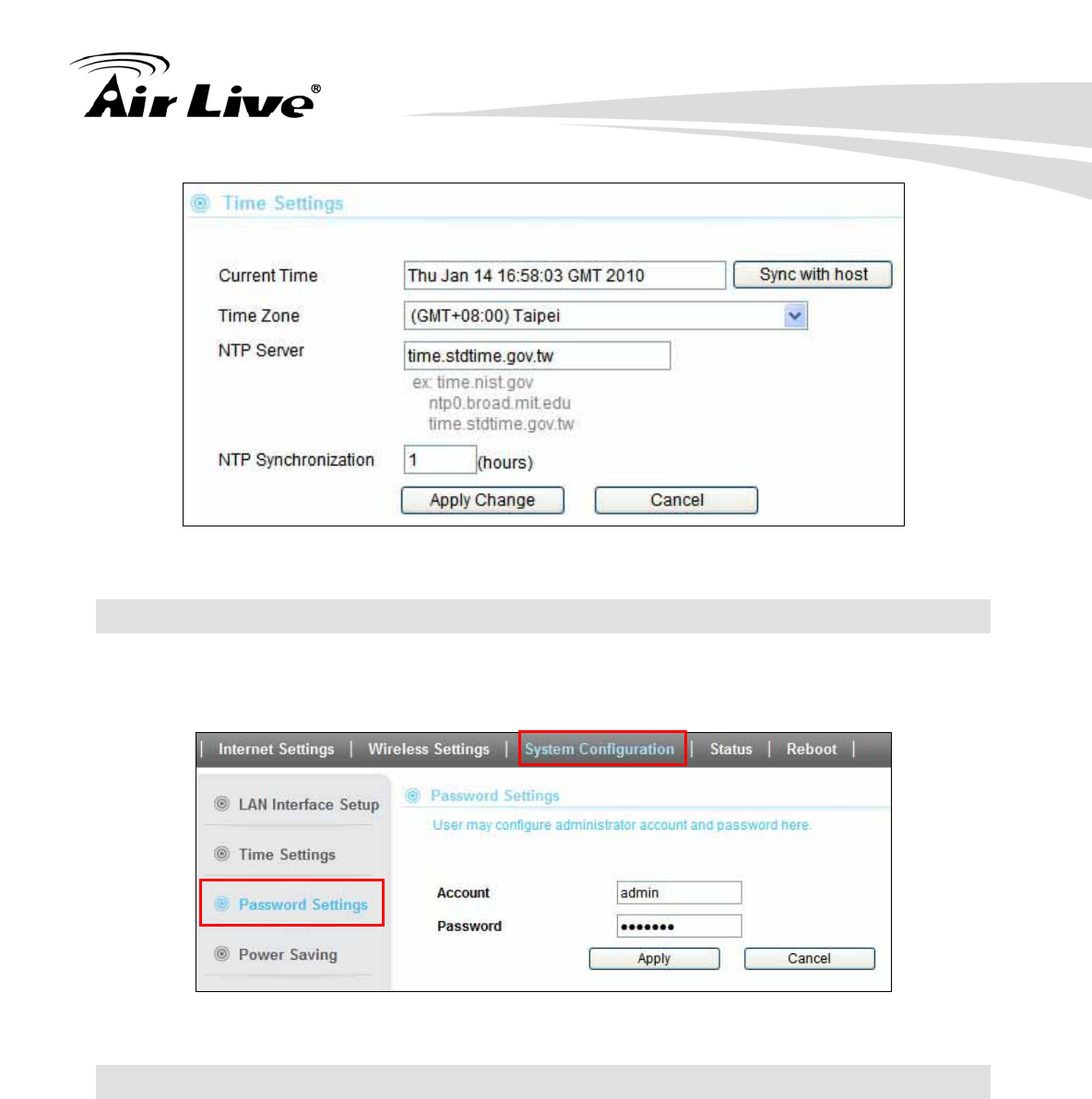
5. System Configuration and Status Menu
AirLive N.Power User’s Manual 48
5.4 Password Settings
System Configuration -> Password Settings
You can change your username and password from the image below:
5.5 Power Saving (Green AP)
System Configuration -> Power Saving
The power saving scheduling function allows user to define the wireless service time and
output power level. It can be used to conserve the energy of your AP. Please remember
to set the time first
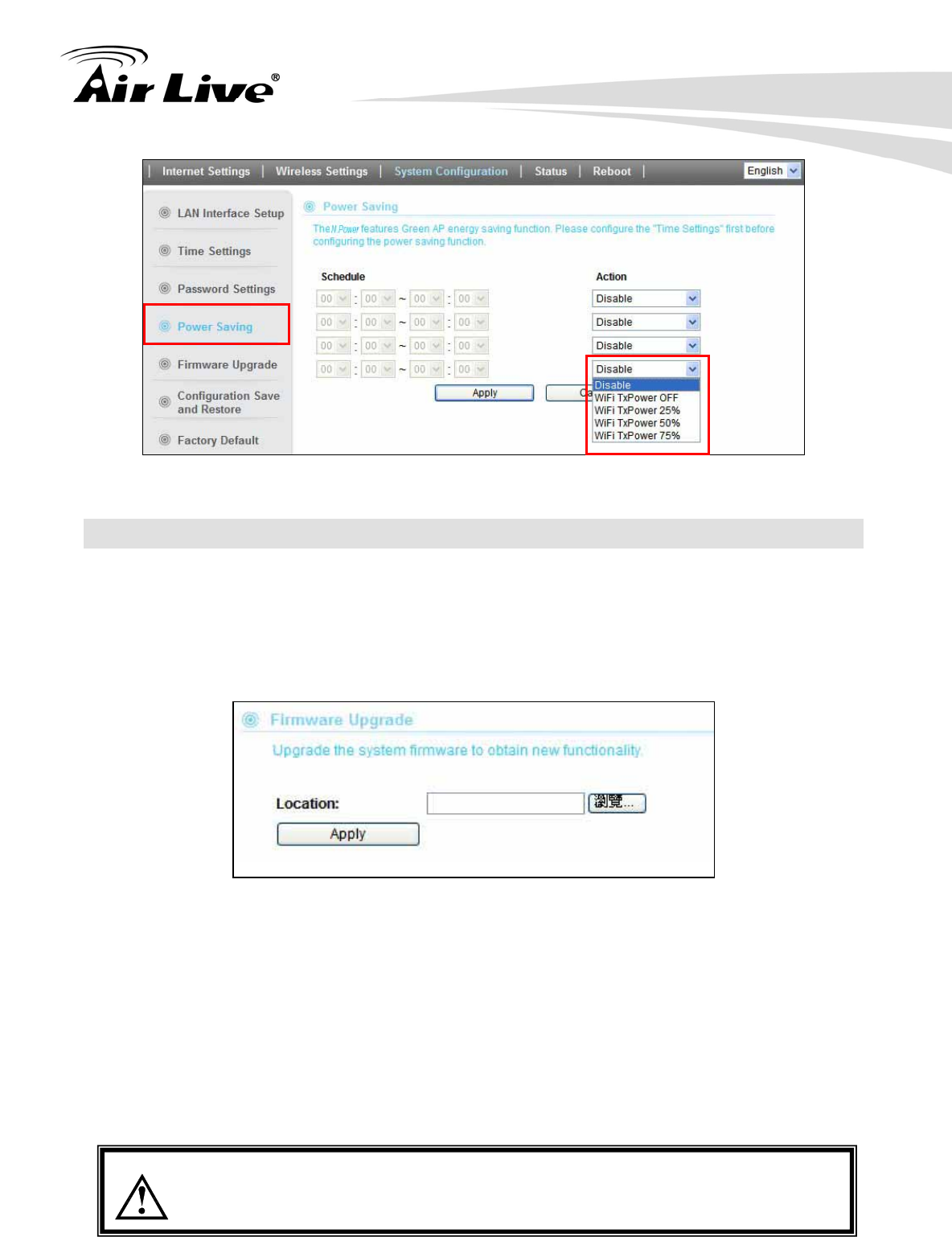
5. System Configuration and Status Menu
49 AirLive N.Power User’s Manual
5.6 Firmware Upgrade
System Configuration -> Firmware Upgrade
You can upgrade the firmware of your N.Power (the software that controls your N.Power’s
operation). Normally, this is done when a new version of firmware offers new features that
you want, or solves problems that you have encountered with the current version.
Upgrade Firmware:
To update the N.Power firmware, first download the firmware from AirLive web site to
your local disk. Then from the above screen enter the path and filename of the
firmware file (or click Browse to locate the firmware file). Next, Click the Apply button
to start.
The new firmware will be loaded to your N.Power. After a message appears telling you that
the operation is completed, you need to reset the system to have the new firmware take
effect.
Do not power off the device while upgrading the firmware. It is recommended
that you do not upgrade your N.Power unless the new firmware has new
features you need or if it has a fix to a problem that you’ve encountered.
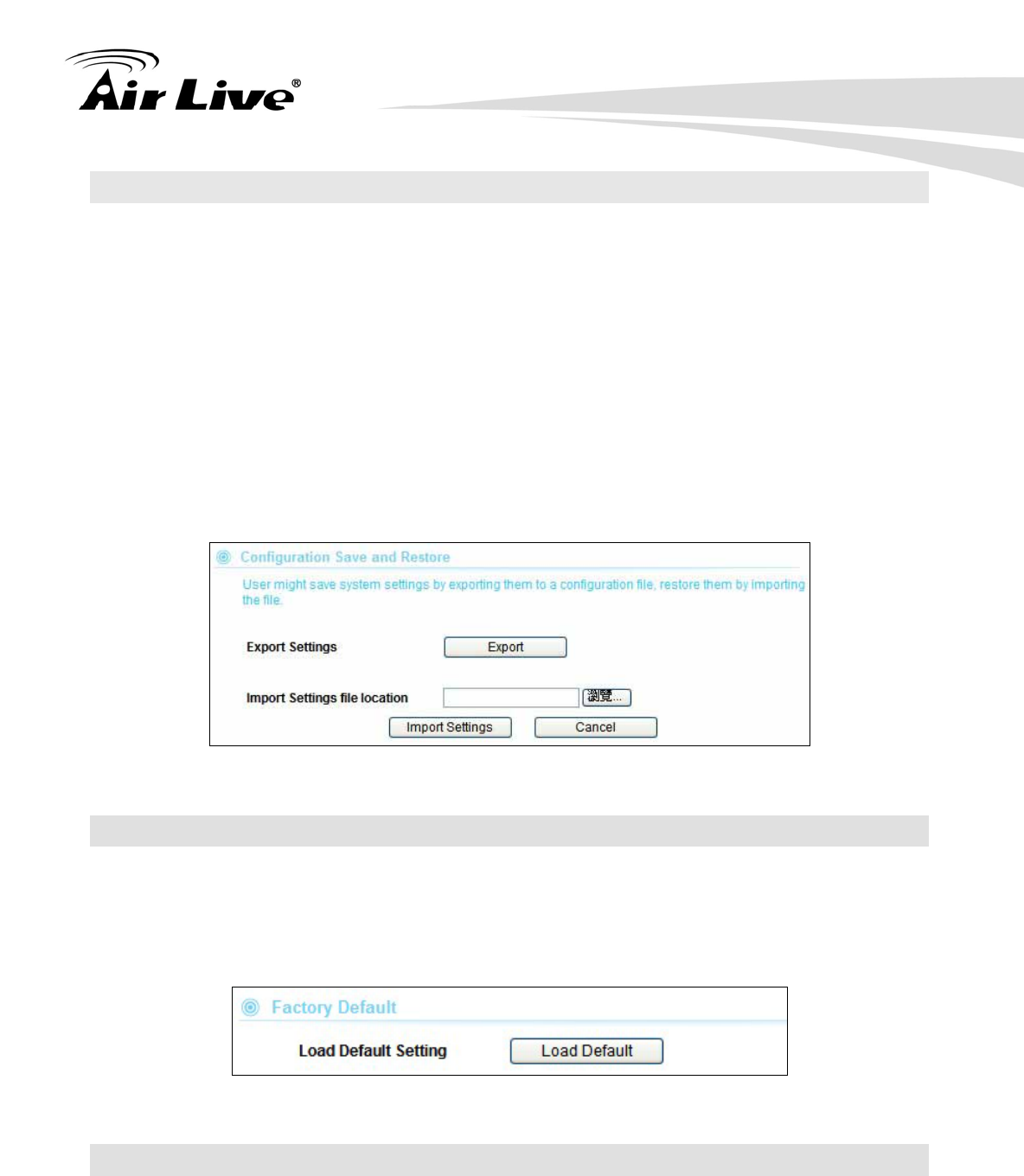
5. System Configuration and Status Menu
AirLive N.Power User’s Manual 50
5.7 Configuration Save and Restore
System Configuration -> Configuration Save and Restore
The N.Power can save and restore the settings to a file.
You can save system configuration settings to a file, and later download it back to the
N.Power
Export Settings: Export the configuration file to your PC so you can restore the
settings later.
Import Settings file location: Please browse for the configuration file location for
restoration of settings
5.8 Factory Default
System Configuration -> Factory Default
You can reset the configuration of your N.Power to the factory default settings.
5.9 Status Menu
5.9.1 Device Information
From this menu, you can know the Firmware version, System Up time, IP and MAC
addresses, and check whether the USB dongle is connected.
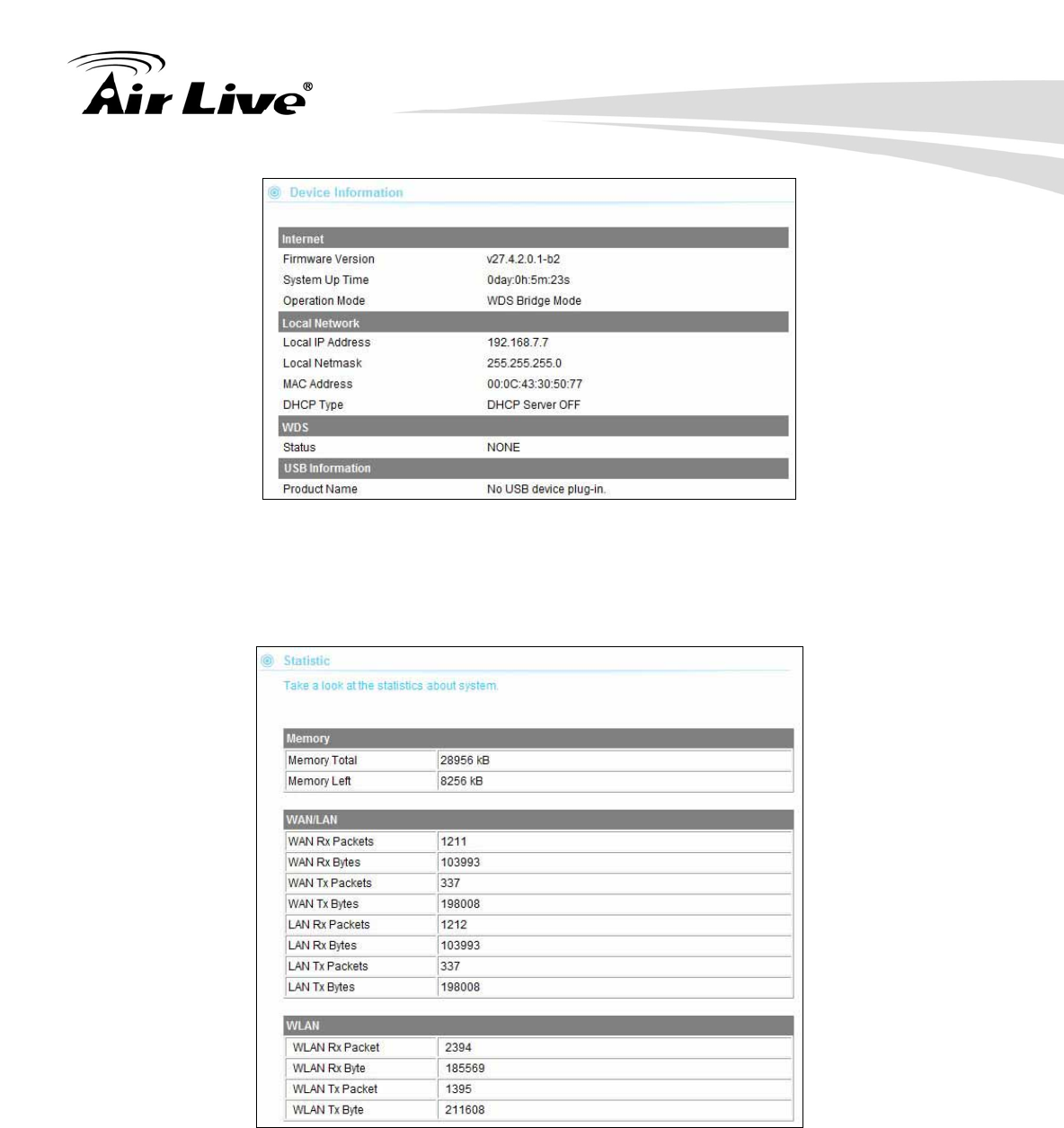
5. System Configuration and Status Menu
51 AirLive N.Power User’s Manual
5.9.2 Statistic
The Statistic menu displays the memory status, WAN traffic, LAN traffic, and WLAN traffic
conditions.
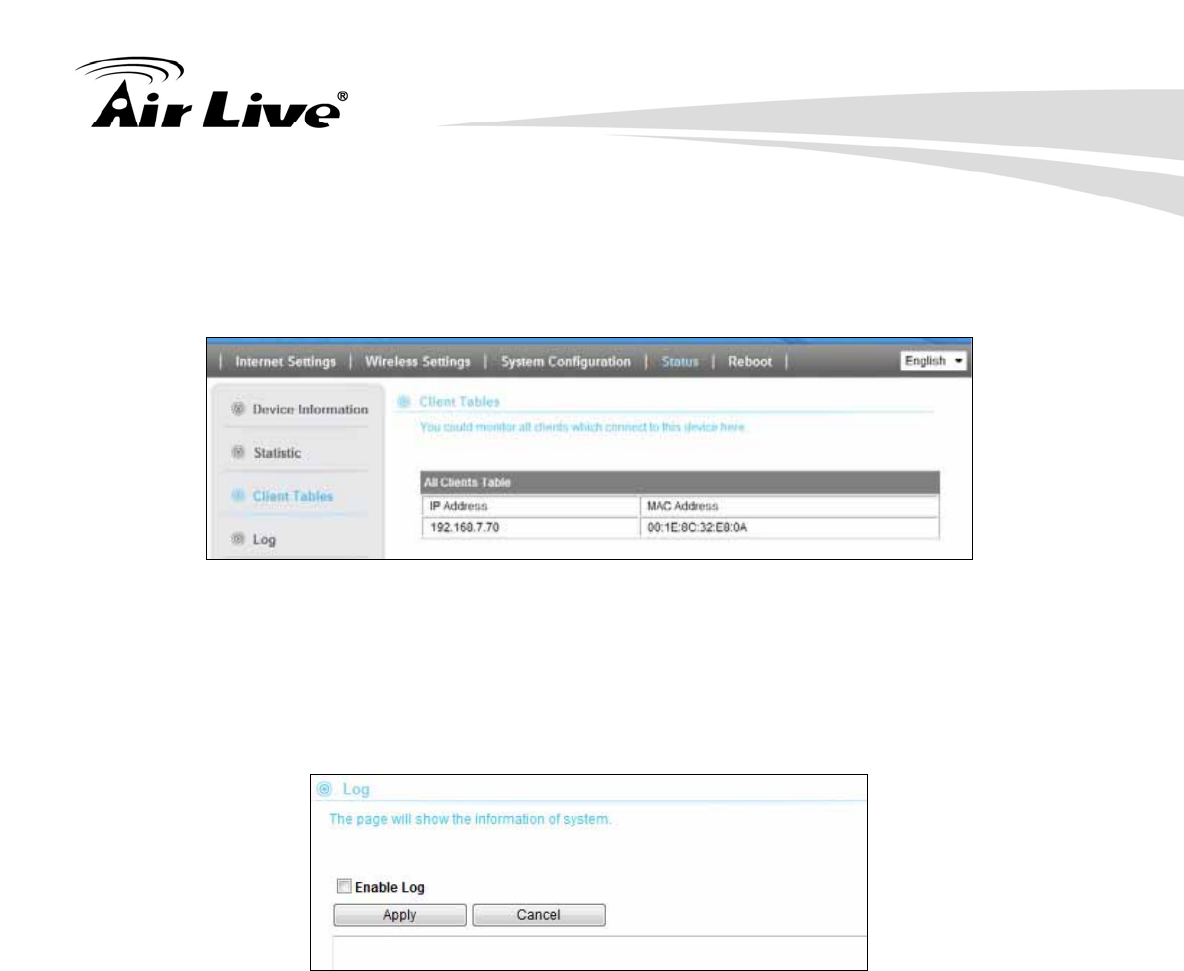
5. System Configuration and Status Menu
AirLive N.Power User’s Manual 52
5.9.3 Client Table
The Client Table is also known as ARP table. It will show all the IP and MAC addresses of
the devices that pass N.Power.
5.9.4 LOG
When you enable the log function, system will keep records of events and errors detected.
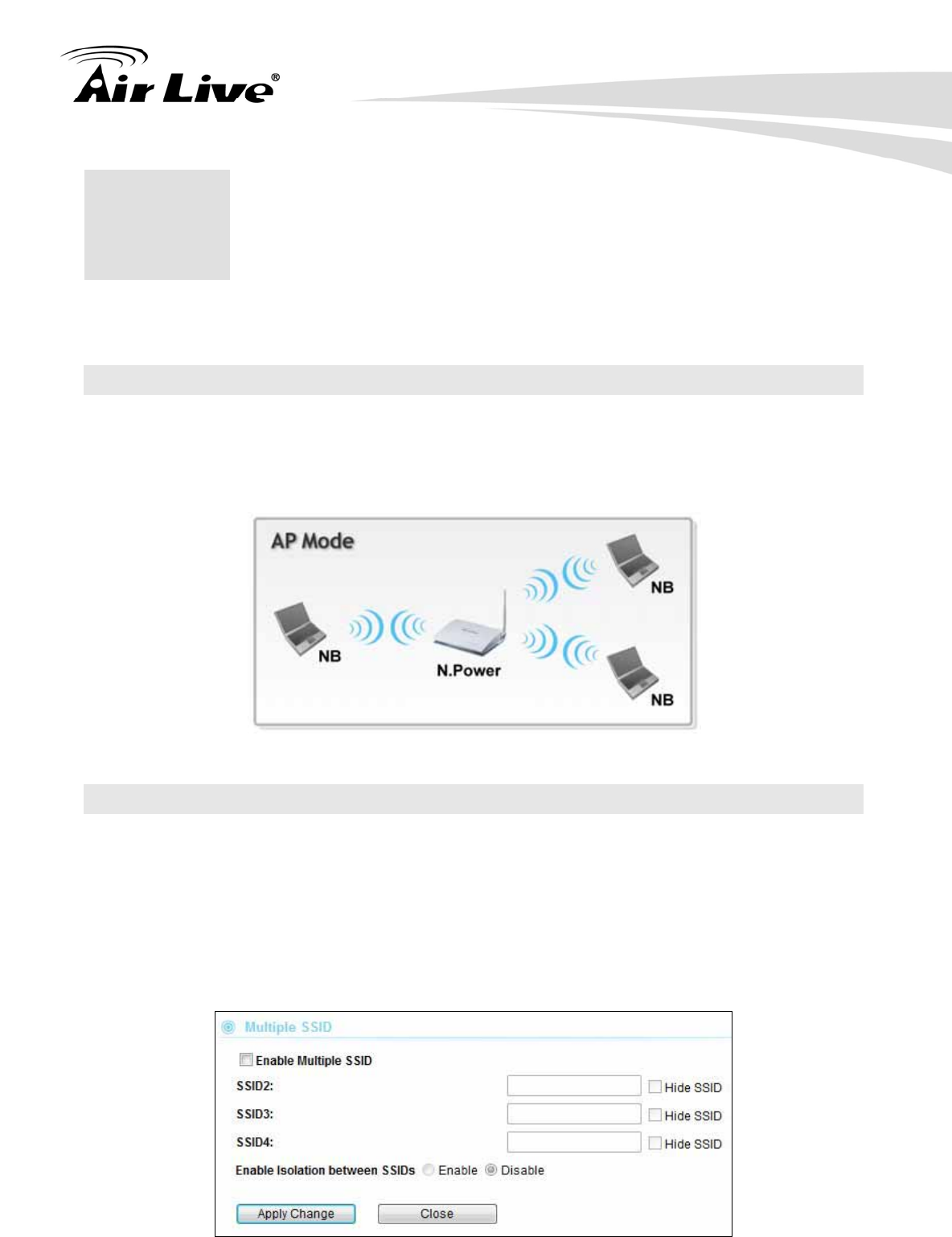
6. AP Mode
53 AirLive N.Power User’s Manual
In this chapter, we will explain about the wireless settings for AP Mode. Please be sure to
read through Chapter 1.4 and Chapter 3’s “Wireless Operation Mode” first.
6.1 Application for AP Mode
When operating in the Access Point mode, the N.Power becomes the center hub of the
wireless network. All wireless cards and clients connect and communicate through
N.Power. This type of network is known as “Infrastructure network”. Other N.Power or
802.11 b/g/n devices can connect to AP mode through “Client Mode.
6.2 Wireless Settings
6.2.1 Multiple SSID
Wireless Settings -> Multiple SSID
Multiple SSID allows N.Power to create up to 4 different wireless networks (SSID). It is
also known as “Virtual AP” function. Each SSID can have its Encryption policy. The
SSID1 is the main SSID under Wireless Setting page.
6 6. AP Mode
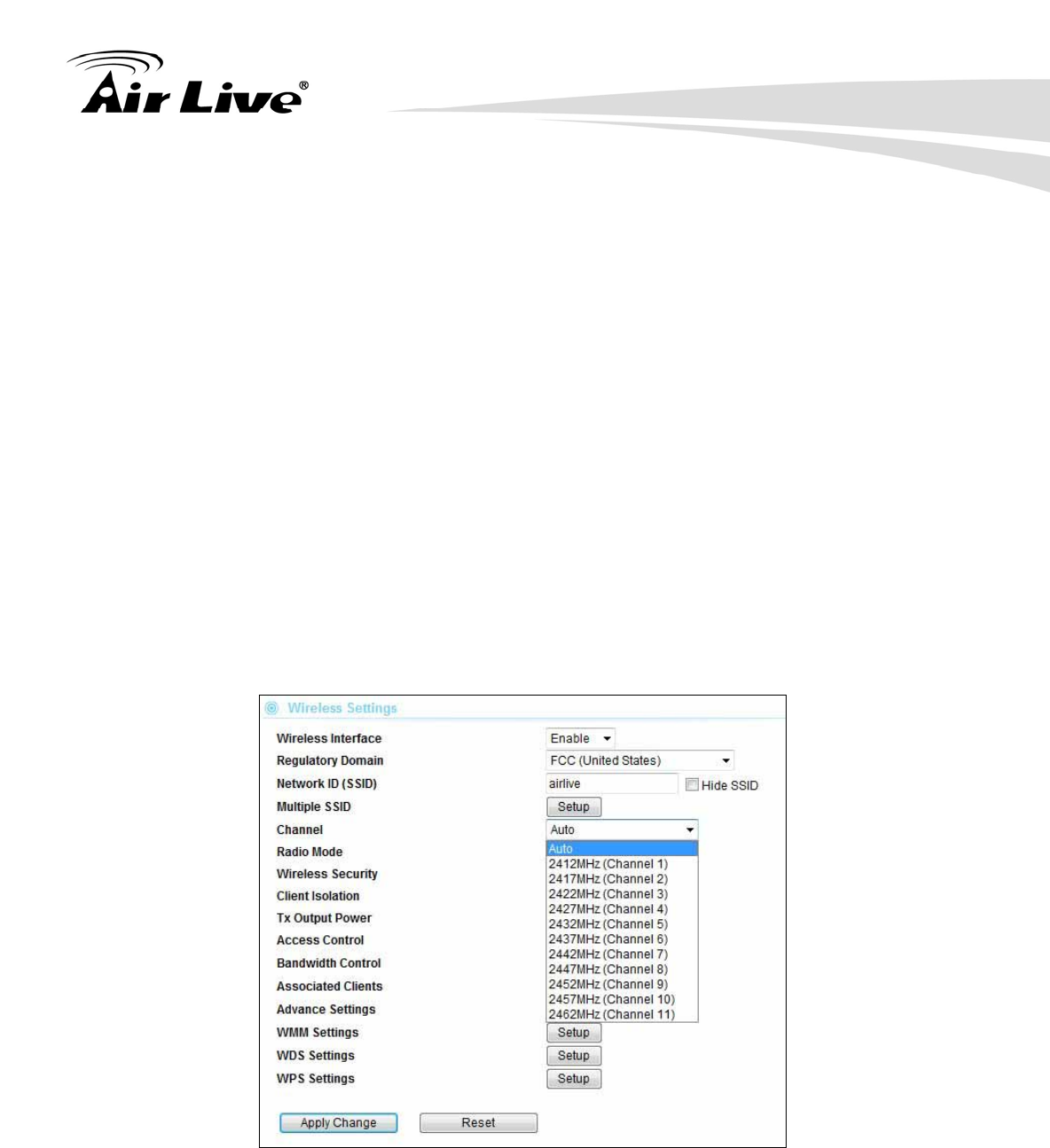
6. AP Mode
AirLive N.Power User’s Manual 54
Hide SSID: The wireless network will become invisible, only accessible to people who
knows the SSID name.
Enable Isolation between SSIDs: Enable this option will disable traffic between
different SSIDs.
6.2.2 Channel
Wireless Settings -> Channel
The channel is the frequency range used by radio. In 802.11g/b standard, there are
maximum of 14 Channels. However, the available channels in each country are
dependant on the local regulation. If you are living in Europe, you can use channel 1 to 13.
If you are living in the United States, you can use channel 1 to 11.
Each wireless channel takes between 22 to 25MHz of frequency width. But the channels
are only 5MHz apart. Therefore, only every 5 channels can be free of interference with
each other. It is recommended that you can do a site survey to find about what channels
are used by surrounding AP and choose a channel that is not used by other APs.
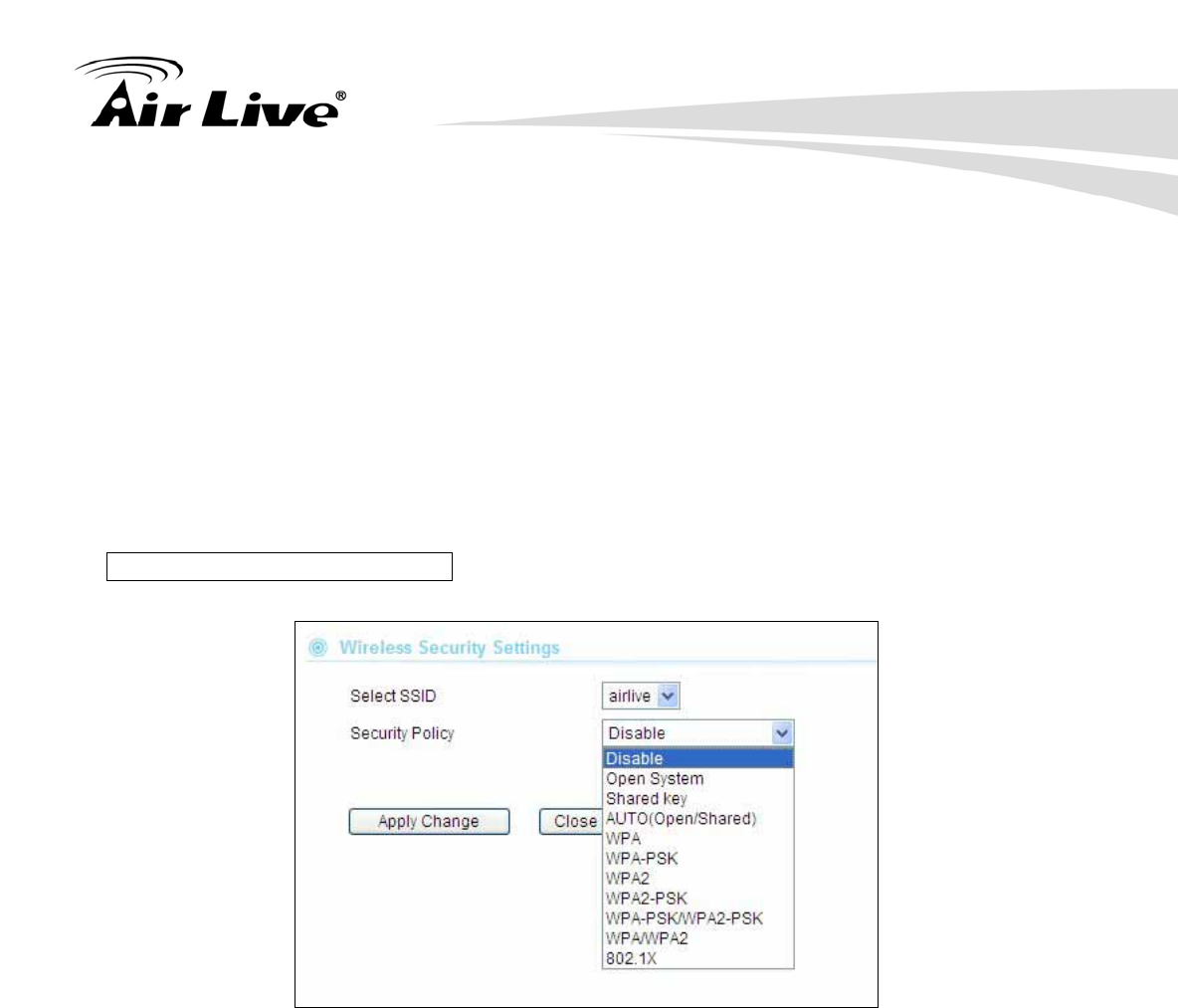
6. AP Mode
55 AirLive N.Power User’s Manual
6.2.3 Wireless Security
Wireless Settings -> Wireless Security
You should set up the wireless security immediately to ensure the security of your data
transmission and to prevent the unauthorized access. The easiest way to setup encryption
is to use the “Setup Wizard”. It automatically chooses the most secured and easiest
scheme for your wireless security settings. However, if you wish to choose your own
encryption scheme, the N.Power offers various type of encryption including WEP,
WPA-PSK, WPA, WPA2, WPA2-PSK encryptions method. In general, the WPA-PSK and
WPA2-PSK are the most popular and secured encryption scheme.
Procedure to make encryption
Step1: Select your SSID: If you have enabled the “Multiple SSID” function, there will
be more than one SSID to choose from. Each SSID (Virtual AP) can have its own
security policy.
Step2: Select Security Policy: N.Power offers a full suite of security policy including
WEP(Pre-Shared Key), WPA(certificate), WPA-PSK(AES), WPA2-PSK(AES), and
802.1x Radius Authentication. Recently WiFi regulation prevents the use of TKIP
encryption in 11n mode. Therefore, the TKIP is only available in 11b/g mode. We
highly recommend using WPA2-PSK AES Encryption as the easiest and very
secured scheme for encryption.
6.2.4 Access Control
Wireless Settings -> Access Control
The N.Power allows you to define a list of MAC addresses that are allowed or denied to
access the wireless network. This function is available only for Access Point and AP
Router modes. This function is available only for Access Point and Gateway modes.
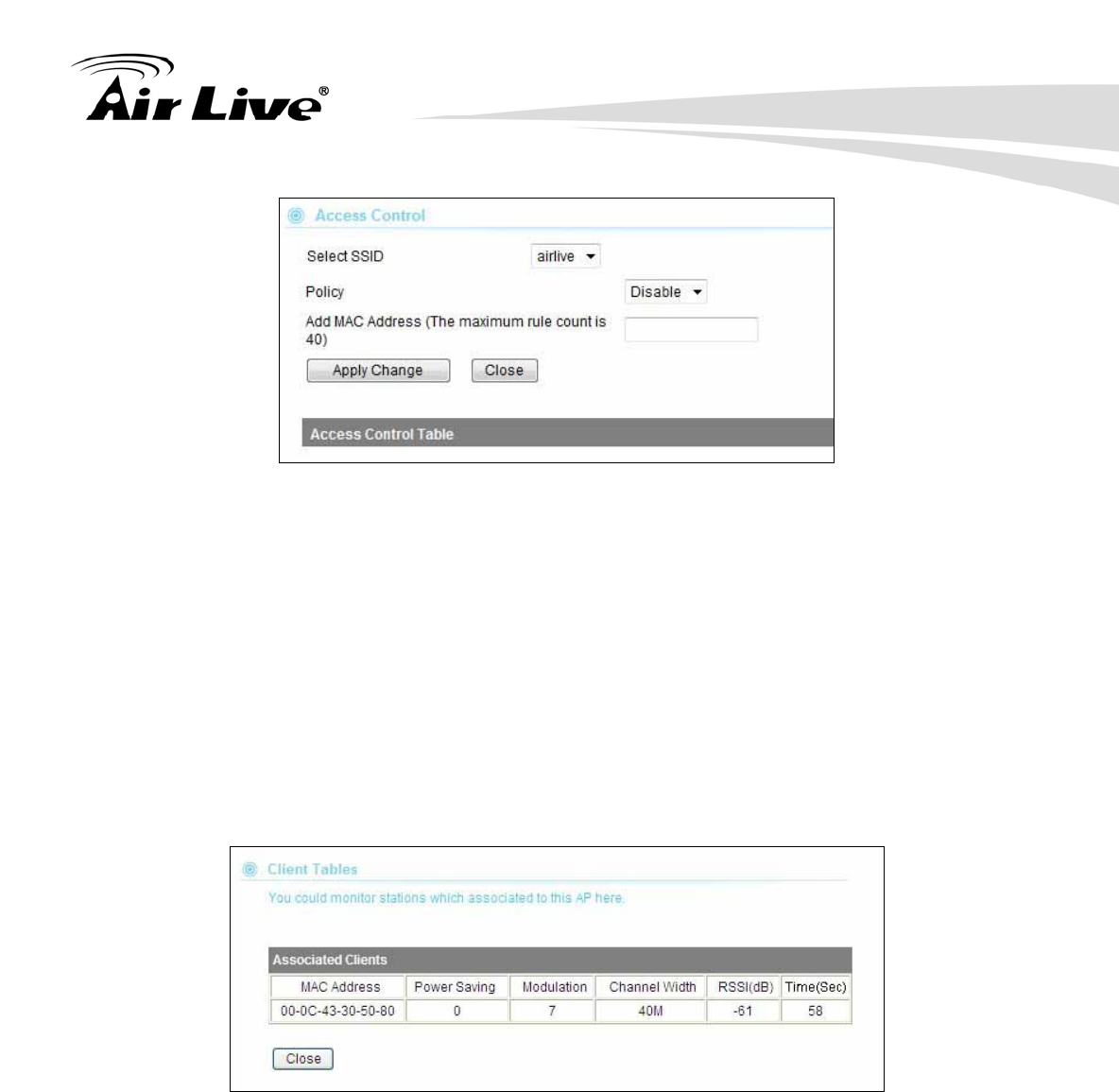
6. AP Mode
AirLive N.Power User’s Manual 56
Disable: When selected, no MAC address filtering will be performed.
Allow list: When selected, data traffic from only the specified devices in the
table will be allowed in the network.
Deny list: When selected, data traffic from the devices specified in the table
will be denied/discarded by the network.
6.2.5 Associated Client
Wireless Settings -> Associated Client
You can check the wireless clients’ status on this table
MAC Address: MAC address of the wireless clients. If you need to find the IP
address, please go to Status->Client Table menu.
Power Saving: 0: The power saving mode is off. 1: The power saving mode is on.
Modulation: Show the which MCS level is used in 11n mode
Channel Width: This indicates whether client is using 20MHz or 40MHz channel
width.
RSSI (dBm): The signal strength of the client device.
Time (Sec): The connected time of the wireless client.
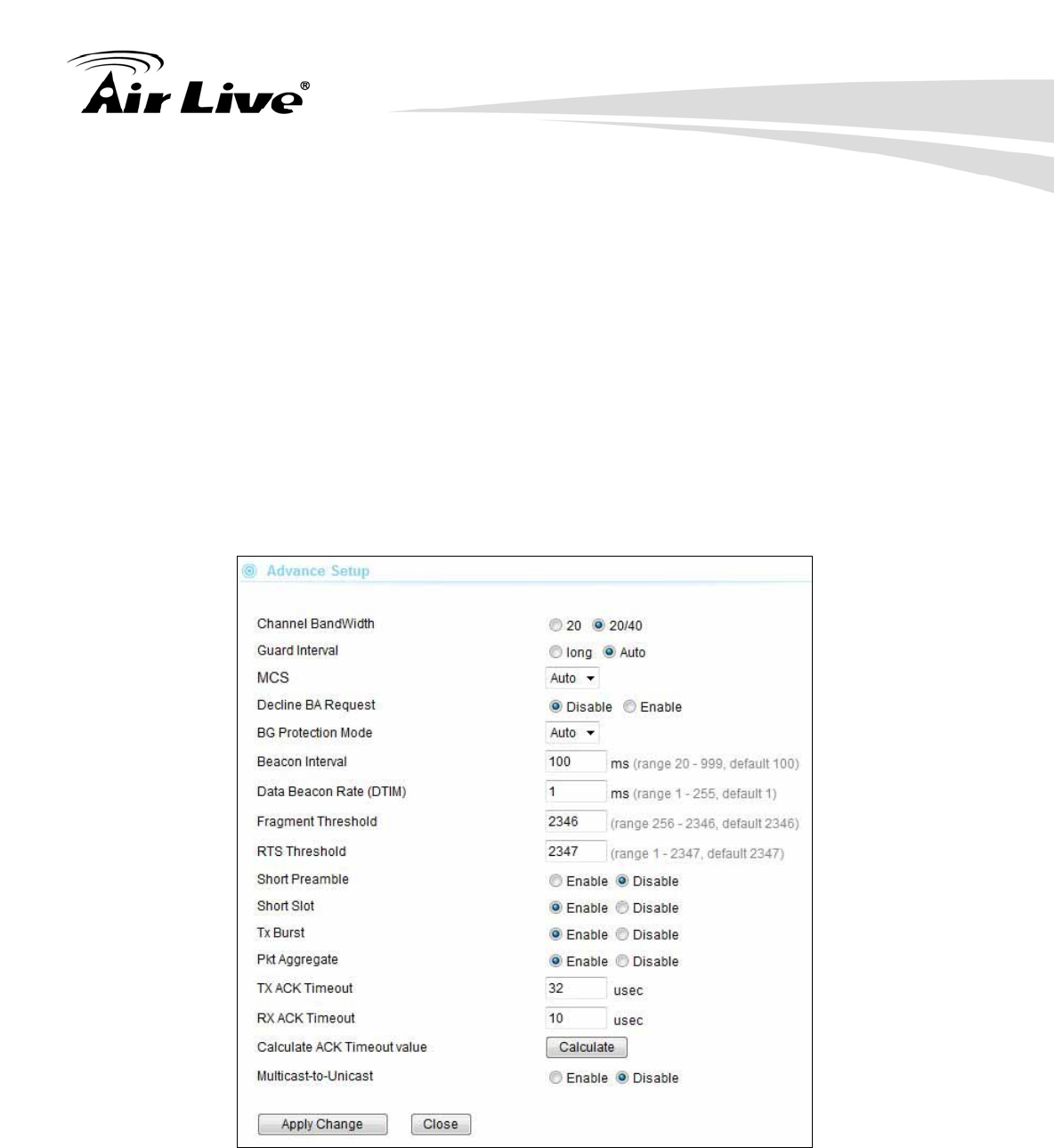
6. AP Mode
57 AirLive N.Power User’s Manual
6.2.6 Advanced Settings
Wireless Settings -> Advance Settings
Channel Width: You can choose 20MHz or 20/40MHz channel width. Choose
20MHz for compliance with laws in some countries. 40MHz offers faster performance
than 20MHz
Guard Interval: Guard interval is placed at the beginning of each transmission. It is
used to reduce the interference effect of multi-path transmissions. The use of long
Guard Interval may perform better in interference or multipath environment. However,
it can reduce the performance.
MCS (Modulation and Code Scheme): MCS level for the 11n mode. It is
recommended to leave it at Auto.
Decline BA Request: Enable this option to decline the Block ACK requests by other
devices.
BG Protection: The 802.11g standard includes a protection mechanism to ensure
mixed 802.11b and 802.11g operation. If there is no such kind of mechanism exists,
the two kinds of standards may mutually interfere and decrease network’s
performance.

6. AP Mode
AirLive N.Power User’s Manual 58
Beacon Interval: The device broadcasts beacon frames regularly to announce its
existence. The beacon Interval specifies how often beacon frames are transmitted in
time unit of milliseconds. The default value is 100, and a valid value should be between
1 and 65,535.
Fragmentation: When the size of a unicast frame exceeds the fragmentation
threshold, it will be fragmented before the transmission. It should have a value of
256-2346 bytes, with a default of 2346. If you experience a high packet error rate,
you should slightly decrease the Fragmentation Threshold.
RTS Threshold: RTS/CTS frames are used to gain control of the medium for
transmission. Any unicast (data or control) frames larger than specified RTS threshold
must be transmitted following the RTS/CTS handshake exchange mechanism. The
RTS threshold should have a value between 256-2347 bytes, with a default of 2347. It
is recommended that this value does not deviate from the default too much.
Short Preamble: A preamble is a signal used in wireless environment to synchronize
the transmitting timing including Synchronization and Start frame delimiter. In a "noisy"
network environment, the Preamble Type should be set to Long Preamble. The Short
Preamble is intended for applications where minimum overhead and maximum
performance is desired. If in a "noisy" network environment, the performance will be
decreased.
Tx Burst and Packet Aggregate: These are the scheme used for improving the
performance of the data transmission in 11n and Turbo modes. It is recommended to
keep the settings on.
AckTimeOut: When a packet is sent out from one wireless station to the other, it will
wait for an Acknowledgement frame from the remote station. The station will only
wait for a certain amount of time; this time is called the ACK timeout. In most
conditions, please do not change the Tx and Rx Acktimeout value. The
N.Power’s default value is correct in most cases.
6.2.7 WMM Settings
Wireless Settings -> WMM Settings
Wi-Fi Multimedia (WMM) is a standard to prioritize traffic for multimedia applications. The
WMM Settings is to specify parameters on multiple data queue for better performance of
differentiated wireless traffic like Voice-over-IP (VoIP), other types of audio, video, and
streaming media as well as traditional IP data over the AP.
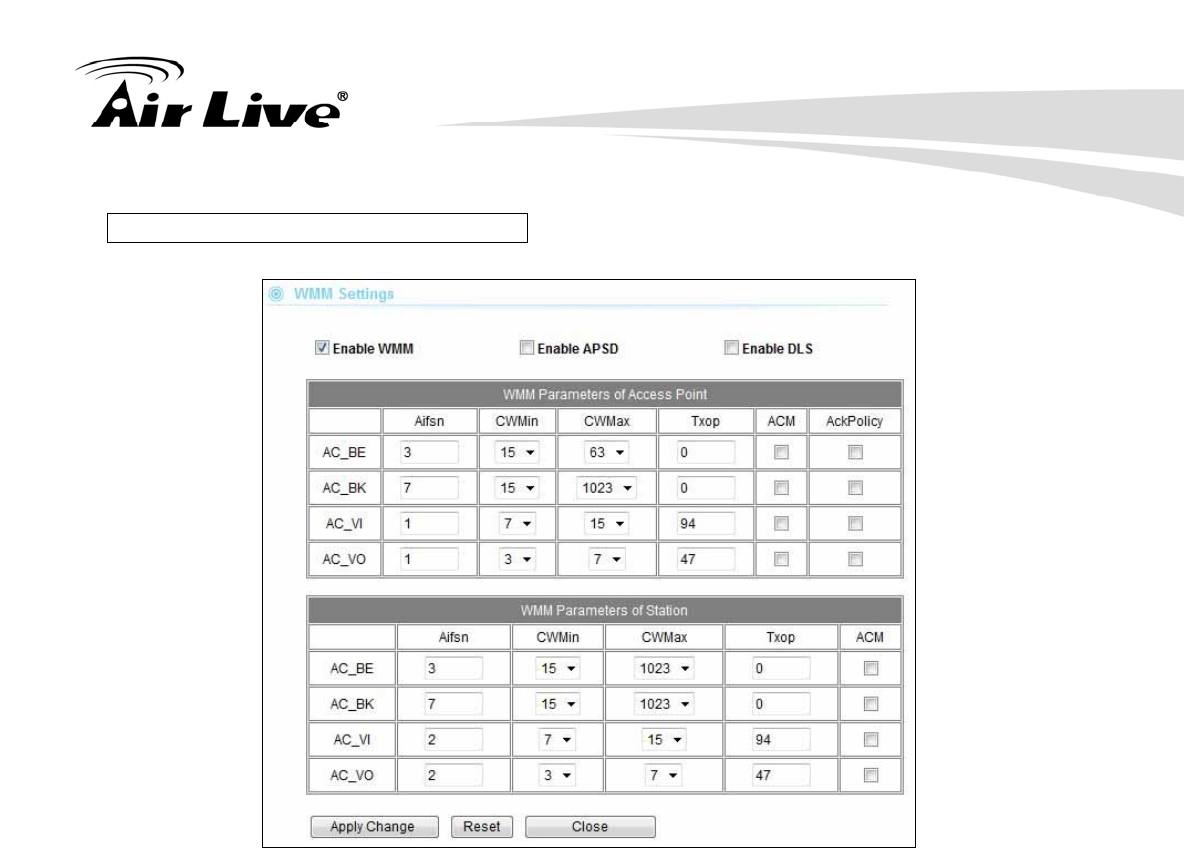
6. AP Mode
59 AirLive N.Power User’s Manual
Configure the WMM QoS Parameters
AC Type
The queue and associated priorities and parameters for transmission are as follows:
Data 0 (Best Effort, BE): Medium priority queue, medium throughput and delay.
Most traditional IP data is sent to this queue.
Data 1 (Background, BK): Lowest priority queue, high throughput. Bulk data
that requires maximum throughput and is not time-sensitive is sent to this queue
(FTP data, for example):
Data 2 (Video, VI): High priority queue, minimum delay. Time-sensitive data
such as Video and other streaming media are automatically sent to this queue.
Data 3 (Voice, VO): Highest priority queue, minimum delay. Time-sensitive
data such as Voice over IP (VoIP) is automatically sent to this queue.
Packets in a higher priority queue will be transmitted before packets in a lower
priority queue.

6. AP Mode
AirLive N.Power User’s Manual 60
ECWmin and ECWmax
If an access point detects that the medium is in use, it uses the DCF random backoff
timer to determine the amount of time to wait before attempting to access a given
channel again. Each access point waits some random period of time between retries.
The wait time (initially a random value within a range specified as the Minimum
Contention Window increases exponentially up to a specified limit Maximum
Contention Window.
The random delay avoids most of the collisions that would occur if multiple APs got
access to the medium at the same time and tried to transmit data simultaneously. The
more active users you have on a network, the more significant the performance gains
of the backoff timer will be in reducing the number of collisions and retransmissions.
The random backoff used by the access point is a configurable parameter. To describe
the random delay, a "Minimum Contention Window" (ECWMin) and a "Maximum
Contention Window" (ECWMax) is defined.
ECWmin: The value specified for the Minimum Contention Window is the
upper limit of a range for the initial random backoff wait time. The number used
in the random backoff is initially a random number between 0 and the number
defined for the Minimum Contention Window.
ECWmax: If the first random backoff time ends before successful
transmission of the data frame, the access point increments a retry counter, and
doubles the value of the random backoff window. The value specified in the
Maximum Contention Window is the upper limit for this doubling of the random
backoff. This doubling continues until either the data frame is sent or the
Maximum Contention Window size is reached.
AIFS
The Arbitration Inter-Frame Spacing (AIFs) specifies a wait time (in milliseconds) for
data frames. 802.11e uses interframe spaces to regulate which frames get access to
available channels and to coordinate wait times for transmission of different types of
data. The AIFs ensures that multiple access points do not try sending data at the same
time but instead wait until a channel is free. Valid values for AIFs are 1 through 255.
Transmission Opportunity
The Transmission Opportunity (TXOP) is an interval of time when a WMM client station
has the right to initiate transmissions onto the wireless medium. This value specifies
(in milliseconds) the Transmission Opportunity (TXOP) for client stations; that is, the
interval of time when a WMM client station has the right to initiate transmissions on the
wireless network.
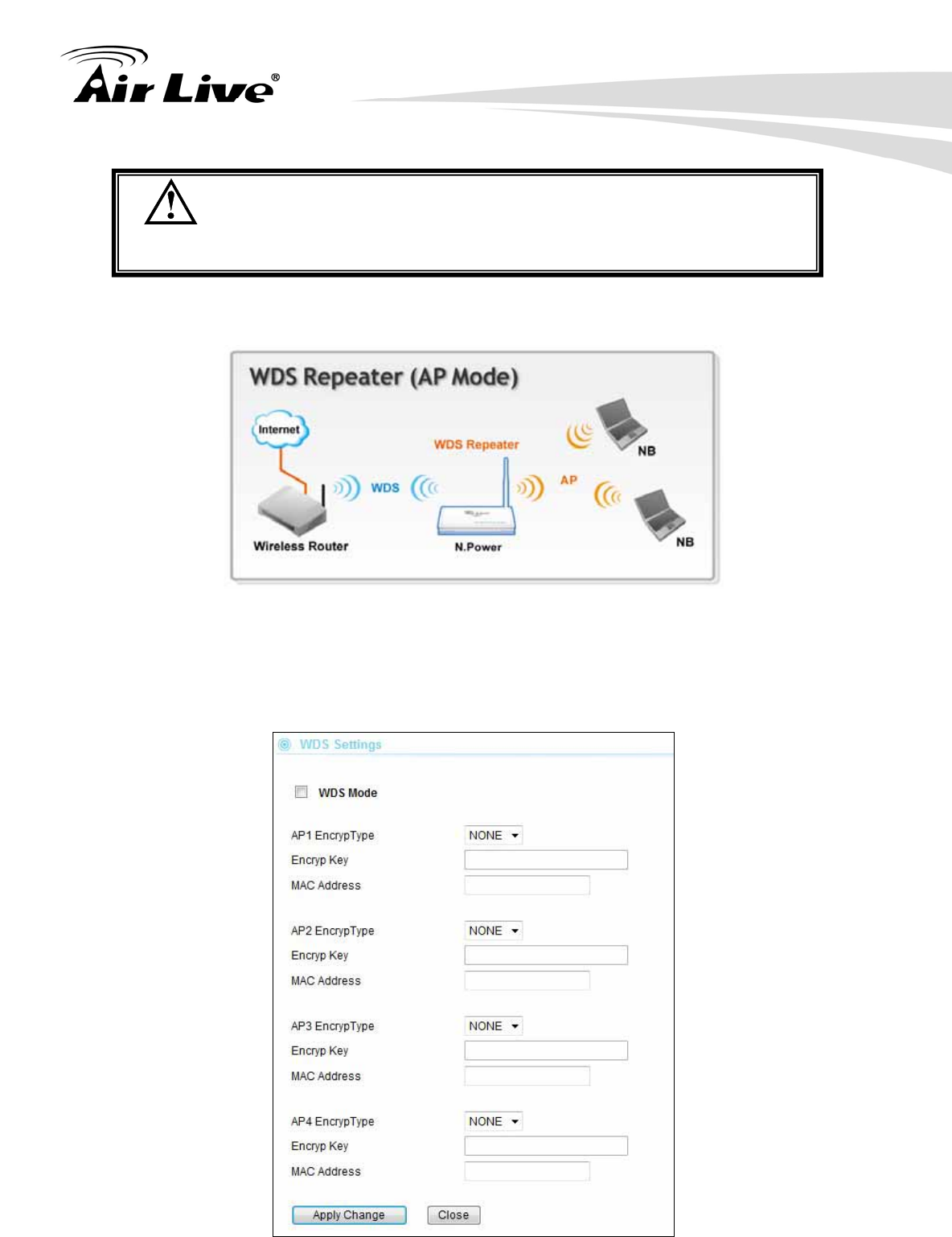
6. AP Mode
61 AirLive N.Power User’s Manual
We recommend that you use the default settings on the WMM QoS
page. Changing these values can lead to unexpected blockages of
traffic on your wireless LAN, and the blockages might be difficult to
diagnose.
6.2.8 WDS Settings (Repeater)
This is known as WDS Repeater function. In AP mode, the N.Power will repeat the
wireless signal of remote AP/Router. Up to 4 WDS repeaters can be connect with
N.Power. WDS works by entering the wireless MAC addresses (also known as BSSID) of
remote Access Points.
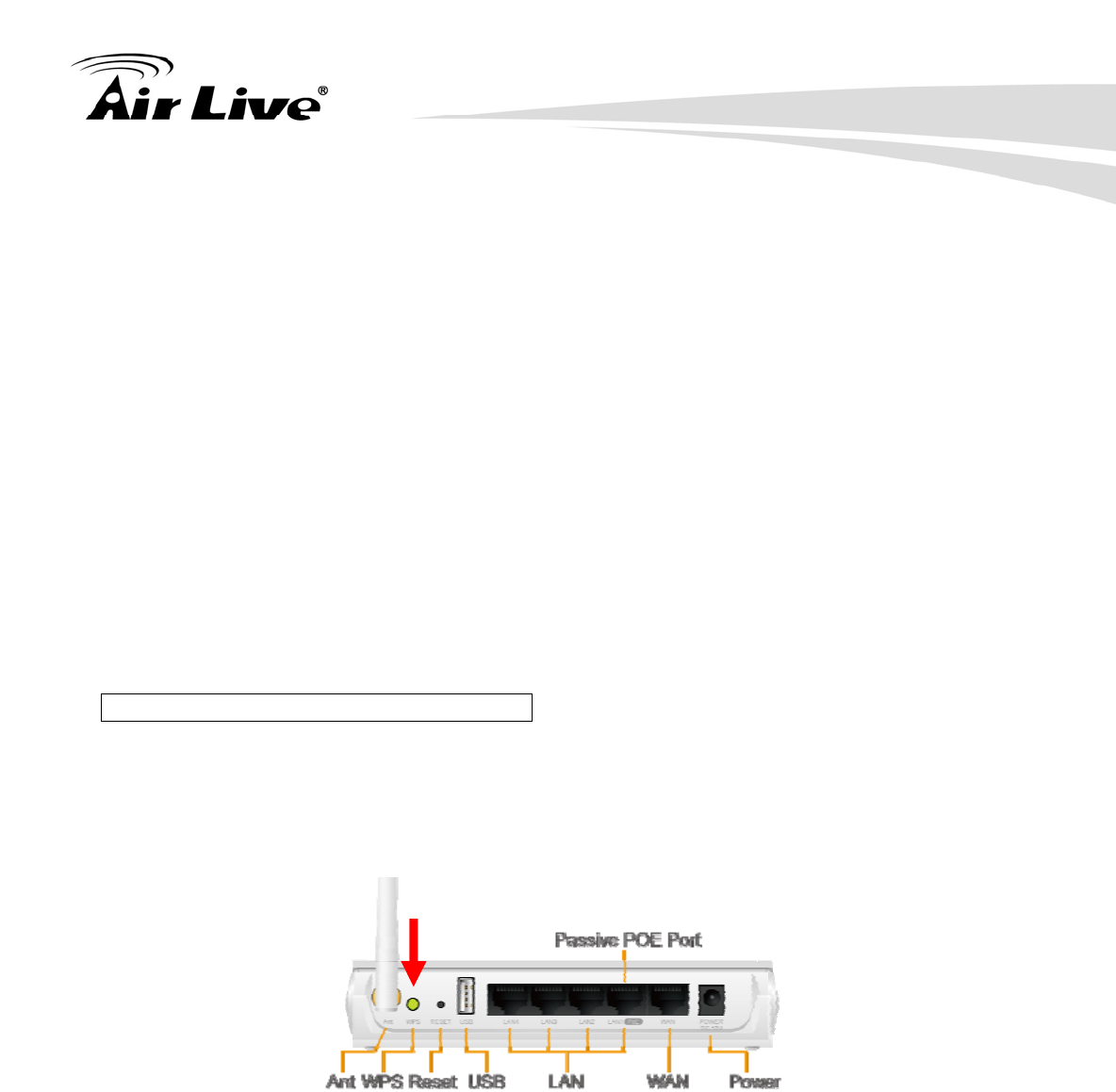
6. AP Mode
AirLive N.Power User’s Manual 62
EncrypType: You can use one of the following 4 encryption type.
None: No encryption is made. This is not recommended as it posts serious
security issue.
WEP: This is the most compatible type. However, it is also easier for
hackers to break. Use this only if AES or TKIP doesn’t work.
TKIP: Temporal Key Integrity Protocol, TKIP is more secured than WEP but
less secure than AES.
AES: The most secured encryption method. It is highly recommended to
use this method unless for compatibility issue.
Encryp Key: Please enter your encryption key here.
MAC Address: Please enter the Wireless MAC address or BSSID of the remote
Bridge. You can usually find it at remote Bridge’s device label.
6.2.9 WPS Settings
Example1: Using Hardware Push button
Please push WPS button directly on the back of the N.Power. The “WPS” LED flash will
light and the N.Power will start to survey the client’s WPS signal in the current environment.
Please be noticed that, within two minutes, you have to turn on the utility of your wireless
network card and click PBC to connect automatically.
If you also have a hardware WPS button on your wireless card, you can push the button
immediately now. If not, you can usually find the WPS PBC function in the wireless utility.
Below is an example using AirLive WN-360USB wireless network card to connect with
N.Power.
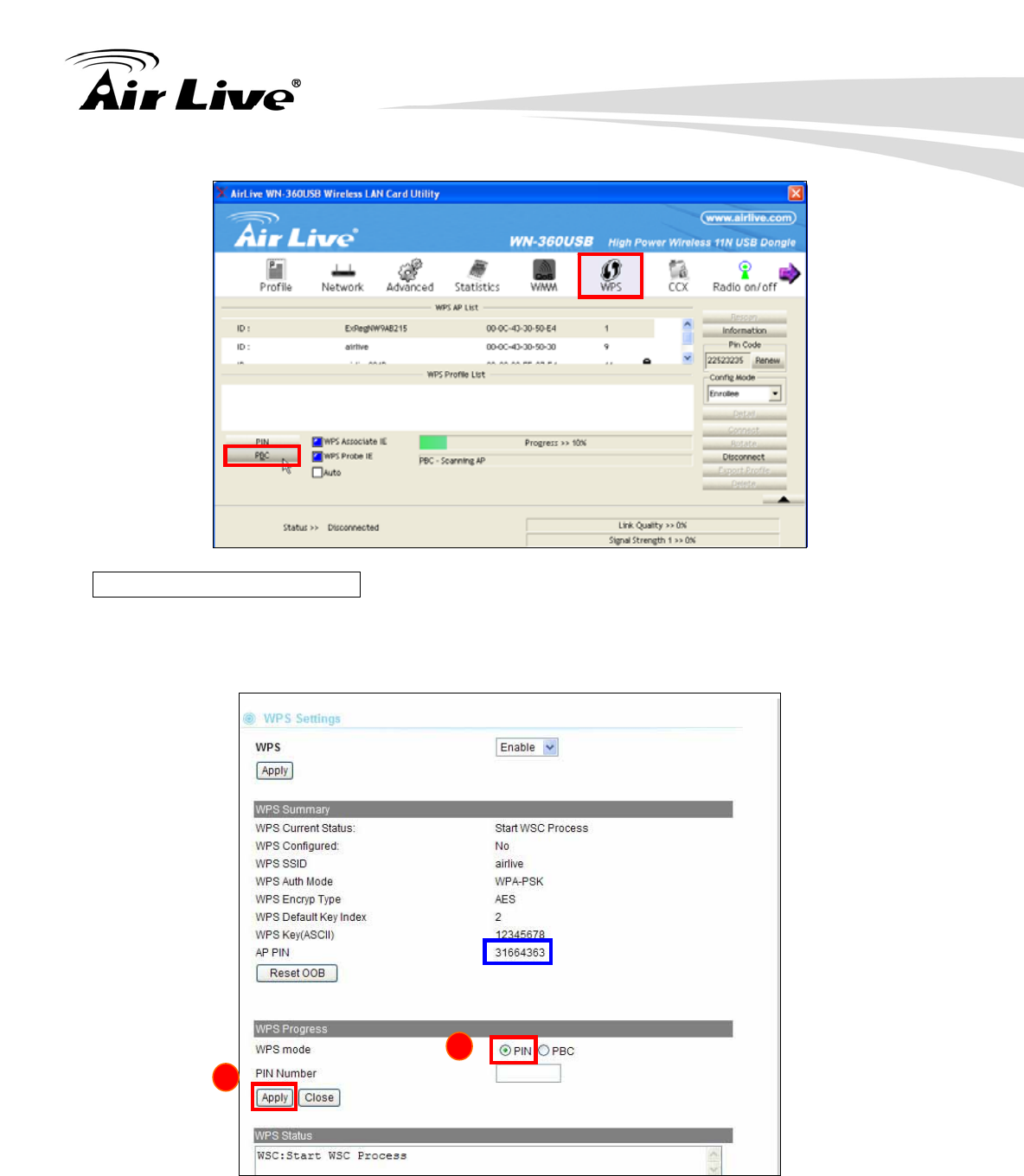
6. AP Mode
63 AirLive N.Power User’s Manual
Example 2: WPS Using PIN
Please login N.Power’s Web UI. Select Wireless Setting Æ WPS Setting. In the WPS
Progress, select “PIN” then “Apply.” You will get a PIN Code.
Then, please turn on the utility of your wireless network card. Choose WPS mode to
“Registrar” and enter the PIN Code. Press “PIN” and the connection will automatically
configure.
6
7
PIN Code
1
2
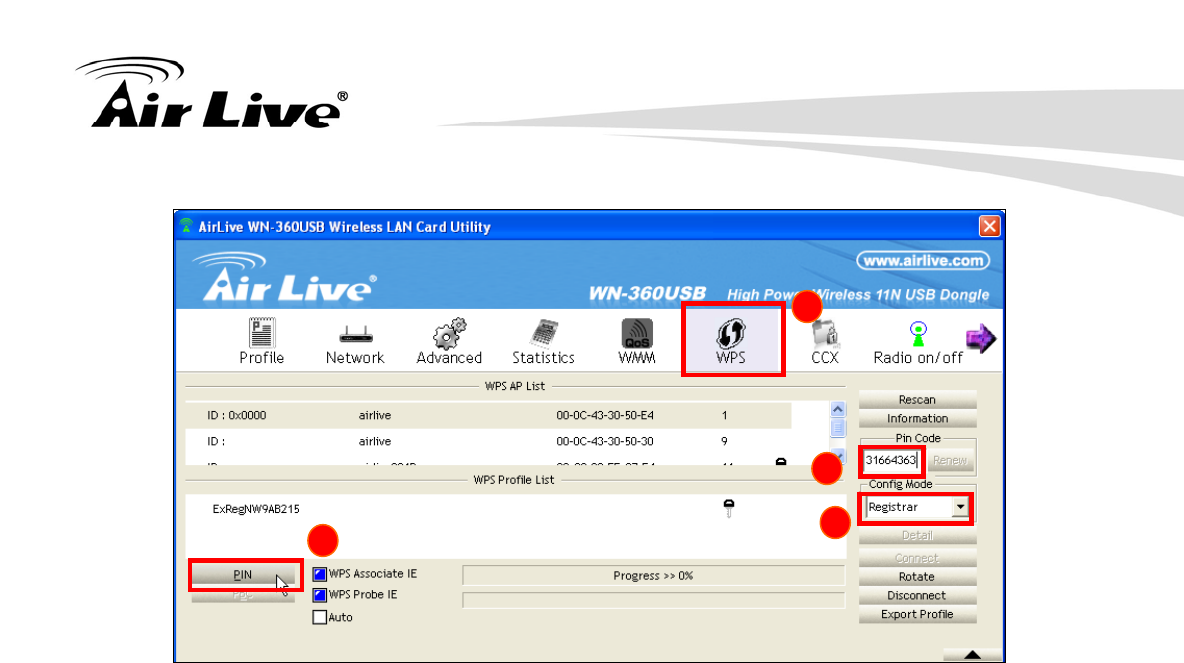
6. AP Mode
AirLive N.Power User’s Manual 64
3
4
5
6
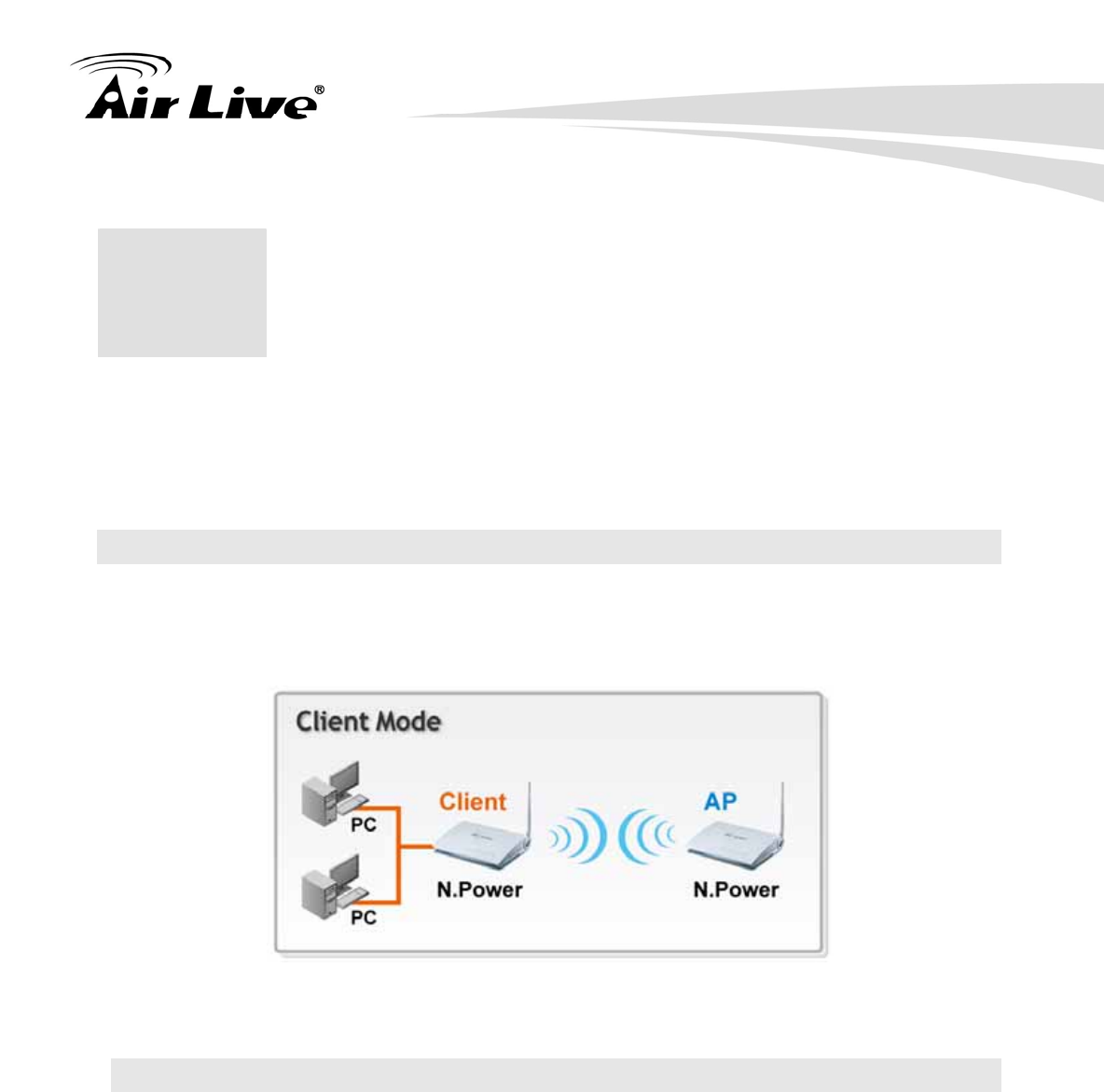
7. Client Mode
65 AirLive N.Power User’s Manual
In this chapter, we will explain about the wireless settings for Client Mode. Please be sure
to read through Chapter 1.4 and Chapter 3’s “Wireless Operation Mode” first.
7.1 Application for Client Mode
This mode is also known as “Client” mode. The N.Power acts as if it is a wireless adapter to
connect with a remote Access Point. Users can attach a computer or a router to the LAN
port of N.Power to get network access.
7.2 Wireless Settings
7.2.1 Profile Setting
Wireless Settings -> Profile Setting
.
A profile contains information about a remote AP’s network. In Client mode, you can
choose to connect with the remote AP using 2 methods.
1. Using Site Survey to find the AP you want to connect with, and then select the SSID
to connect. This is the easiest way.
2. Create a profile about the remote AP you want to connect with. We will talk about
Profile in this section.
7 7. Client Mode
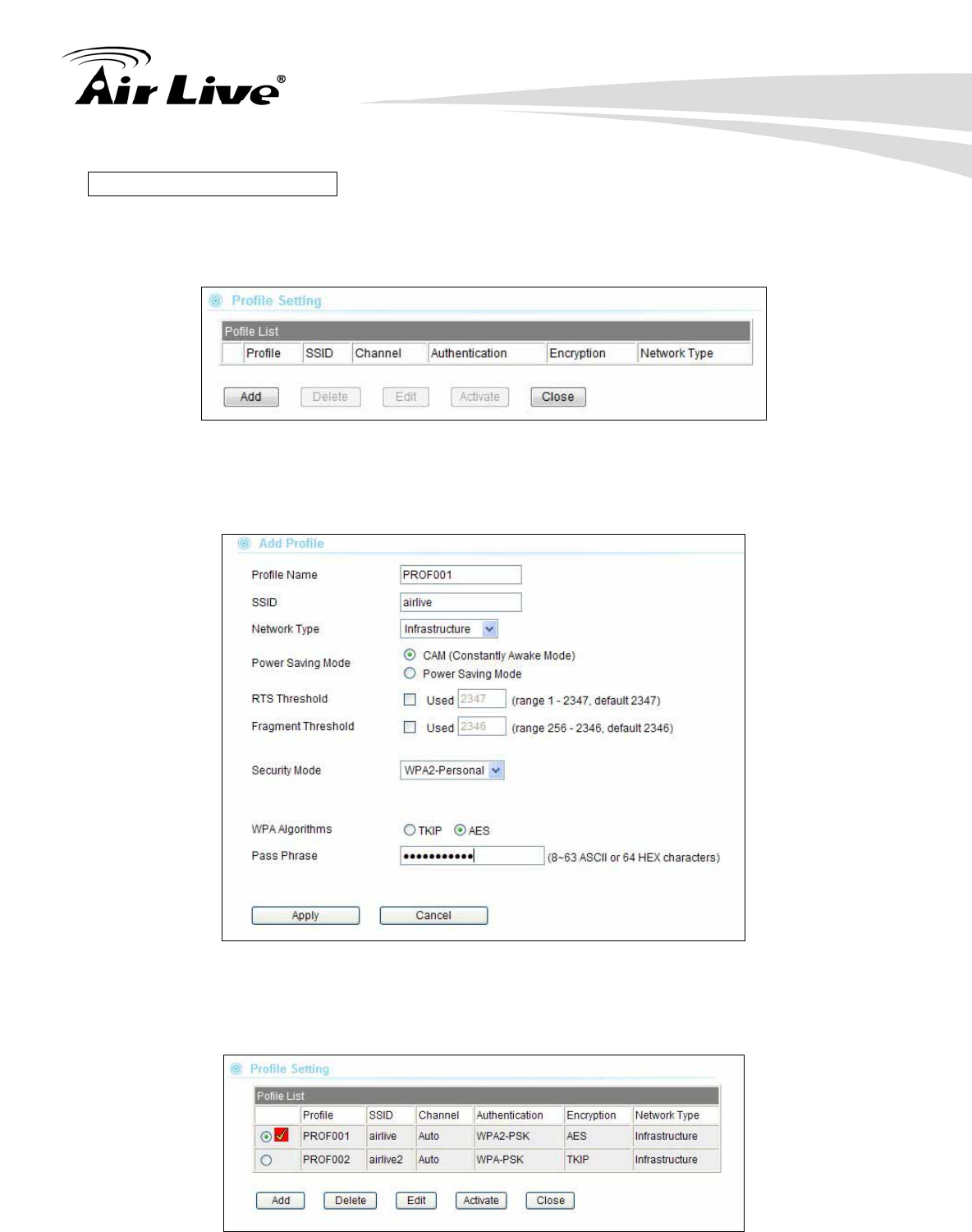
7. Client Mode
AirLive N.Power User’s Manual 66
Procedure to Add a Profile
1. Click on Profile Settings on the Wireless Settings Menu. Then click on “Add” to add a
new profile
2. On the Add profile page, please enter the information about the remote AP network
such as SSID, encryption. Click on “Apply” once finished
3. Once apply the new profile should appear on the list. Select the profile and click on
“Activate” button to take effect. Only one profile can be activated at a time.
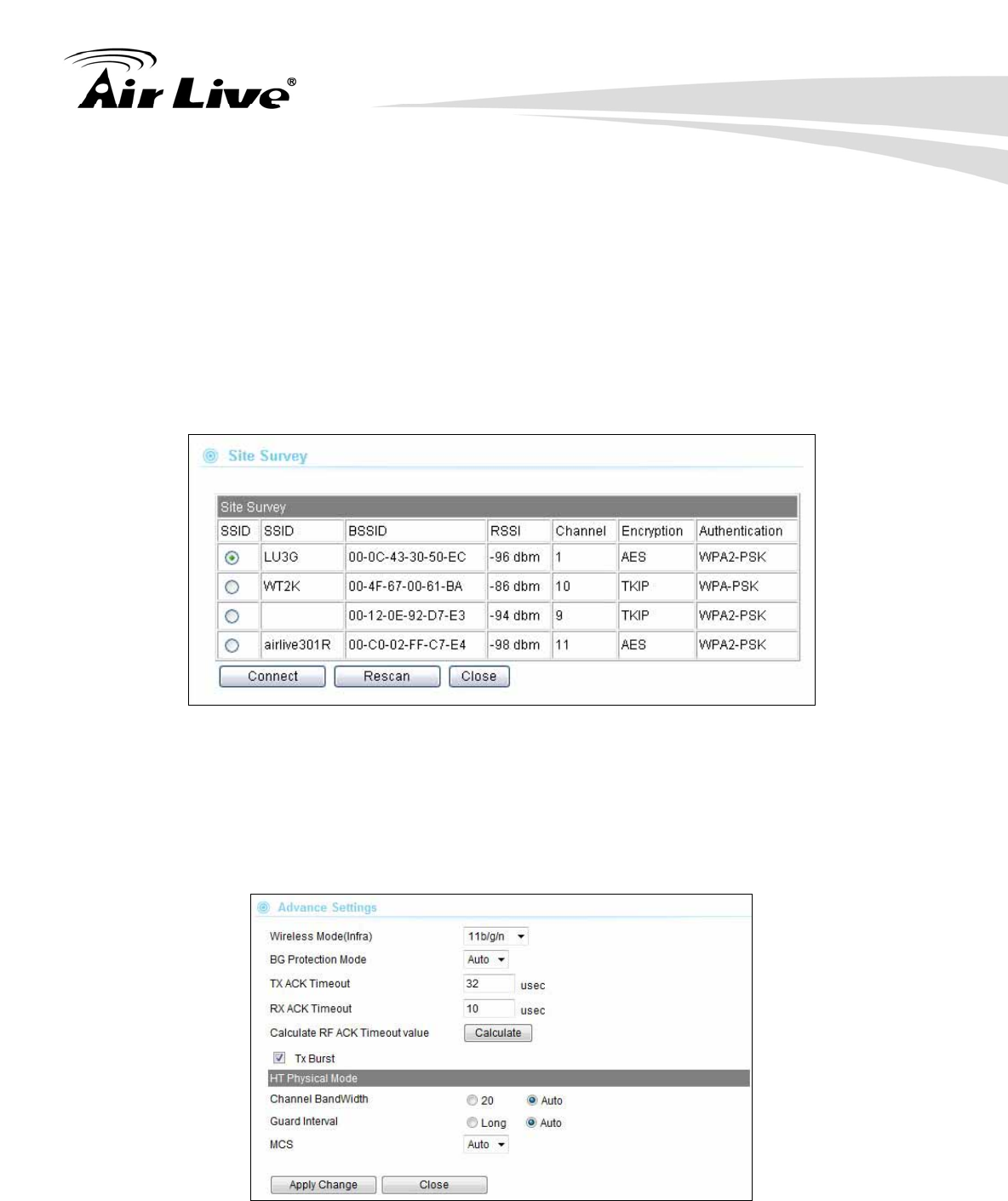
7. Client Mode
67 AirLive N.Power User’s Manual
7.2.2 Site Survey
Wireless Settings -> Site Survey
You can scan for wireless networks around your location using the Site Survey function.
From the site survey function, you can also perform antenna alignment and establish
wireless connection
When you click on Site Survey, the following screen will appear. It might take awhile
depending on number of available APs in the area
You can now select the SSID you want to connect with, and then press the “Connect”
button. If encryption key is required, the AP will prompt you to enter the encryption
information.
7.2.3 Advance Settings
BG Protection: The 802.11g standard includes a protection mechanism to ensure
mixed 802.11b and 802.11g operation. If there is no such kind of mechanism exists,
the two kinds of standards may mutually interfere and decrease network’s
performance.
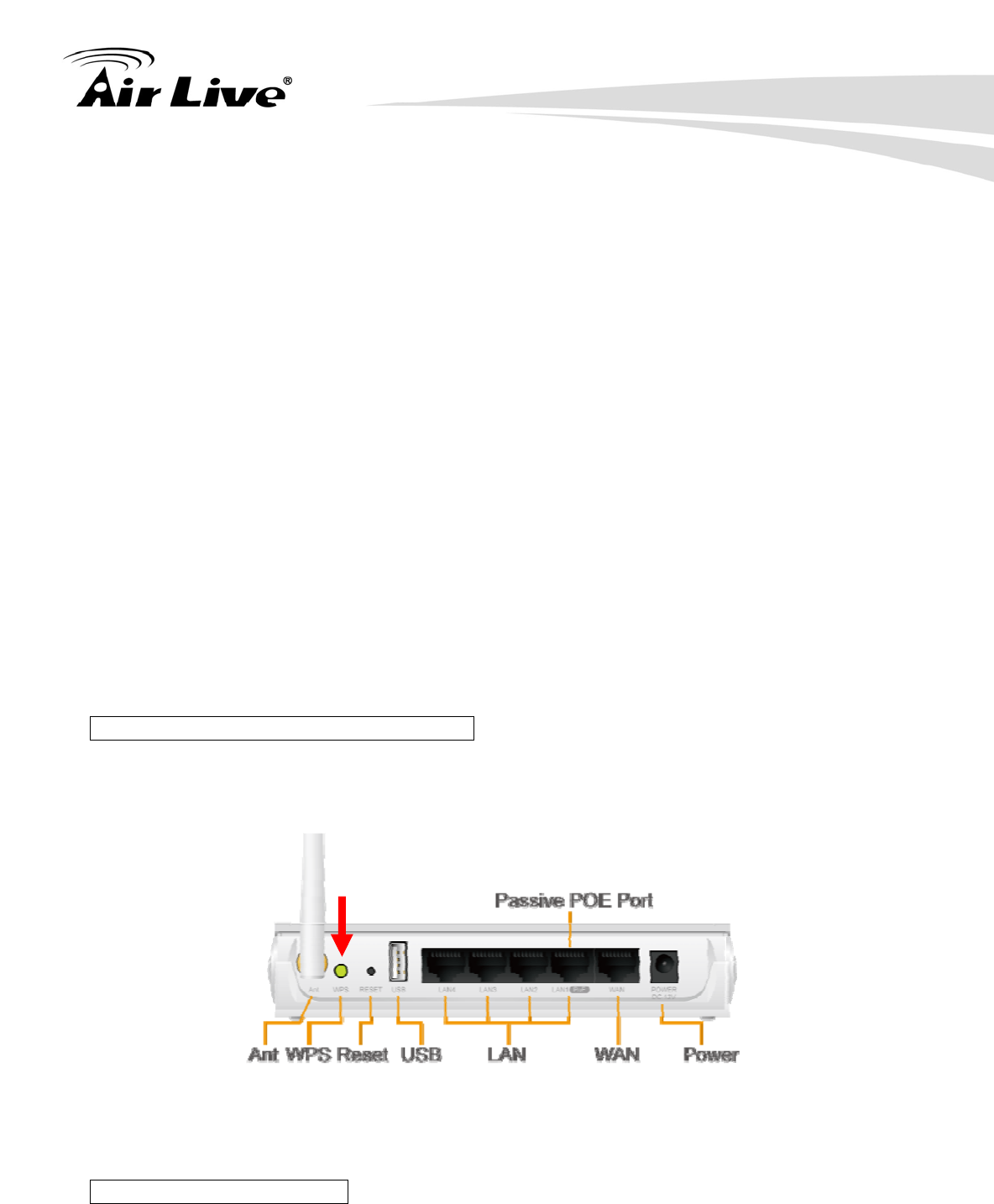
7. Client Mode
AirLive N.Power User’s Manual 68
AckTimeOut: When a packet is sent out from one wireless station to the other, it will
wait for an Acknowledgement frame from the remote station. The station will only
wait for a certain amount of time; this time is called the ACK timeout. In most
conditions, please do not change the Tx and Rx Acktimeout value. The N.Power’s
default value is correct in most cases.
Tx Burst: These are the scheme used for improving the performance of the data
transmission in 11n and Turbo modes. It is recommended to keep the settings on.
Channel Width: You can choose 20MHz or 20/40MHz channel width. Choose
20MHz for compliance with laws in some countries. 40MHz offers faster performance
than 20MHz
Guard Interval: Guard interval is placed at the beginning of each transmission. It is
used to reduce the interference effect of multi-path transmissions. The use of long
Guard Interval may perform better in interference or multipath environment. However,
it can reduce the performance.
MCS (Modulation and Code Scheme): MCS level for the 11n mode. It is
recommended to leave it at Auto.
7.2.4 WPS Settings
Example 1: Using WPS hardware button
Please push WPS button directly on the back of the device. The “WPS” LED flash will light
and the N.Power will start to survey the AP’s WPS signal in the current environment.
Within two minutes, please push WPS button on your AP device, the connection will
automatic successfully.
Example 2: WPS using PIN
Please login N.Power’s Web UI. Select Wireless Setting Æ change to Client mode Æ
Client WPS Setting.
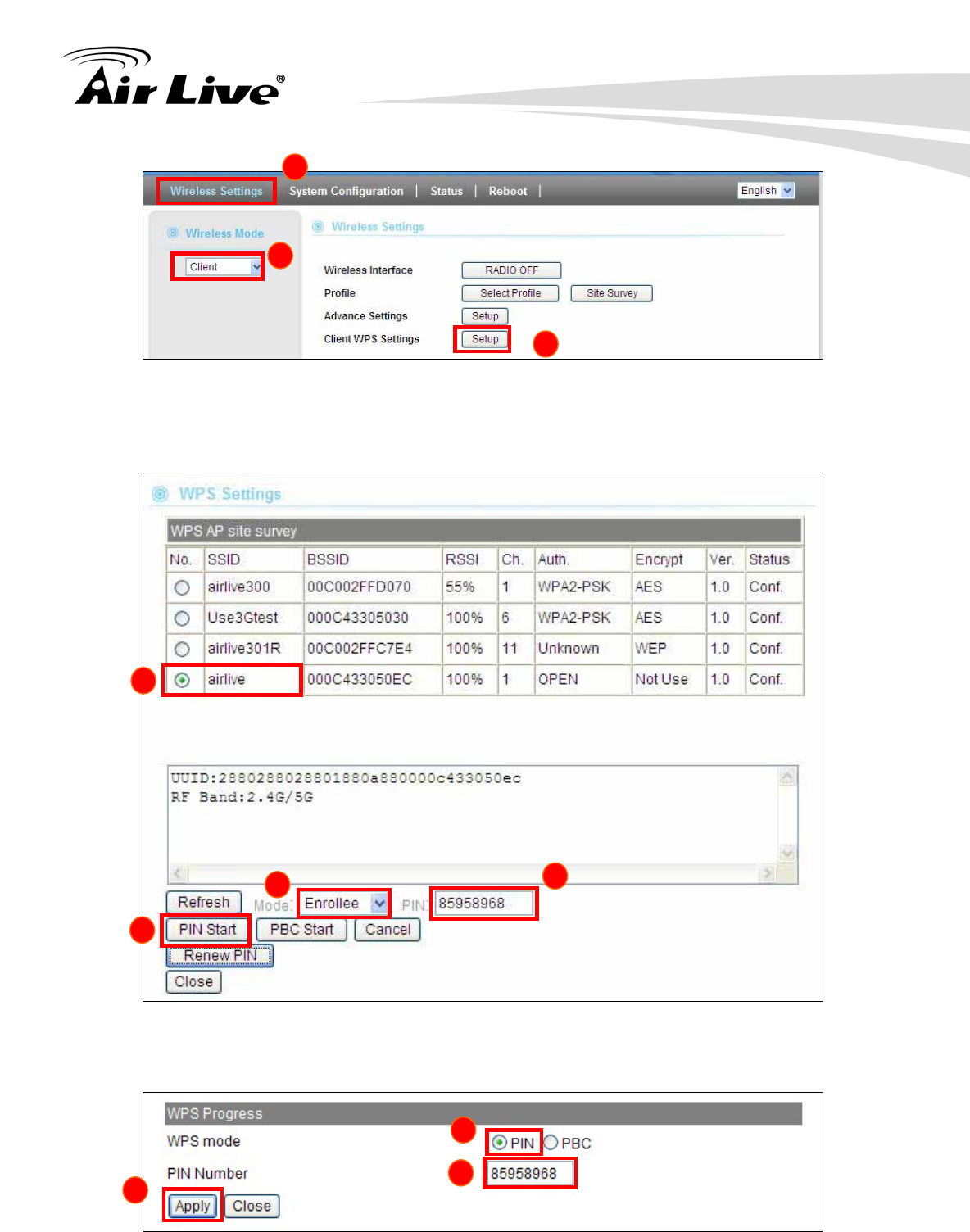
7. Client Mode
69 AirLive N.Power User’s Manual
Select the SSID that you want to connect. Choose WPS mode to “Enrollee” and get a PIN
Code in the field. Then press “PIN Start” and the “WPS” LED flash will light two minutes
on the device’s housing.
Under AP site, Select Wireless Setting Æ WPS Setting. Choose WPS mode to “PIN” then
enter the PIN Code Æ click “Apply” and the connection will automatically configure.
Copy PIN Code
4
5 6
7
1
2
3
10
Enter PIN Code
8
9
10
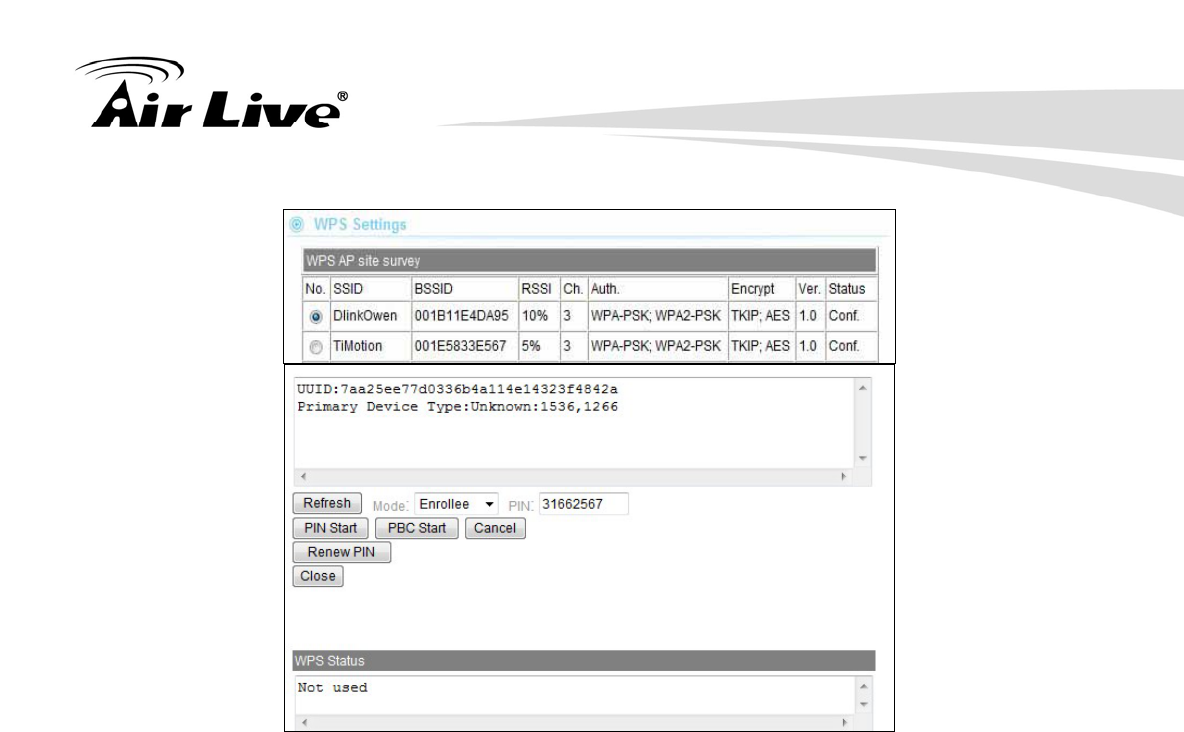
7. Client Mode
AirLive N.Power User’s Manual 70
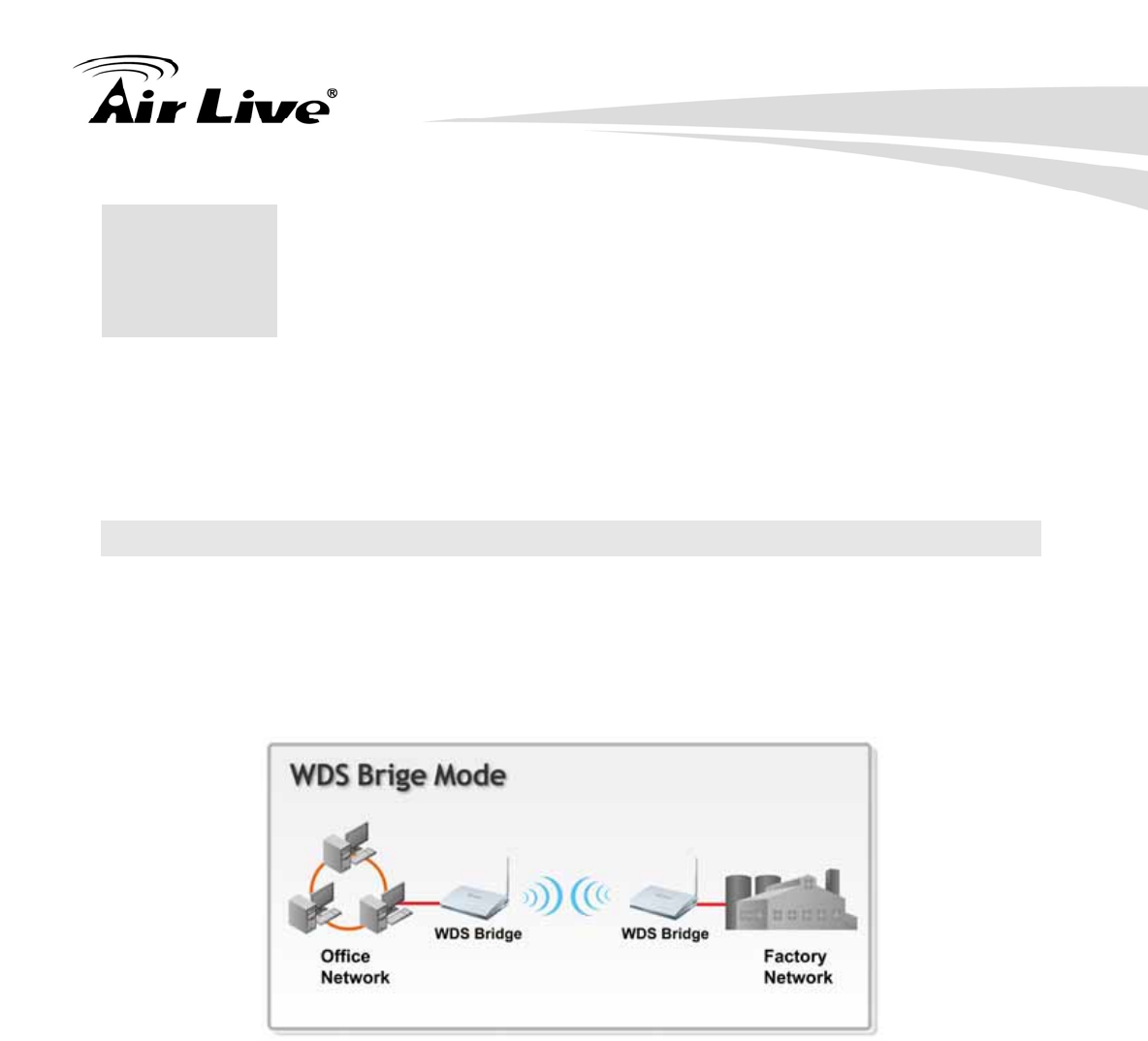
8. WDS Bridge Mode
71 AirLive N.Power User’s Manual
In this chapter, we will explain about the wireless settings for WDS Bridge Mode. Please
be sure to read through Chapter 1.4 and Chapter 3’s “Wireless Operation Mode” first.
8.1 Application for WDS Bridge Mode
This mode is also known as “WDS Pure MAC Bridge mode”. Each bridge can associate
with maximum of 4 other bridges in the WDS configuration. This mode is best used when
you want to connect LAN networks together wirelessly (for example, between office and
warehouse). This mode usually delivers faster performance than infrastructure mode.
8 8. WDS Bridge Mode
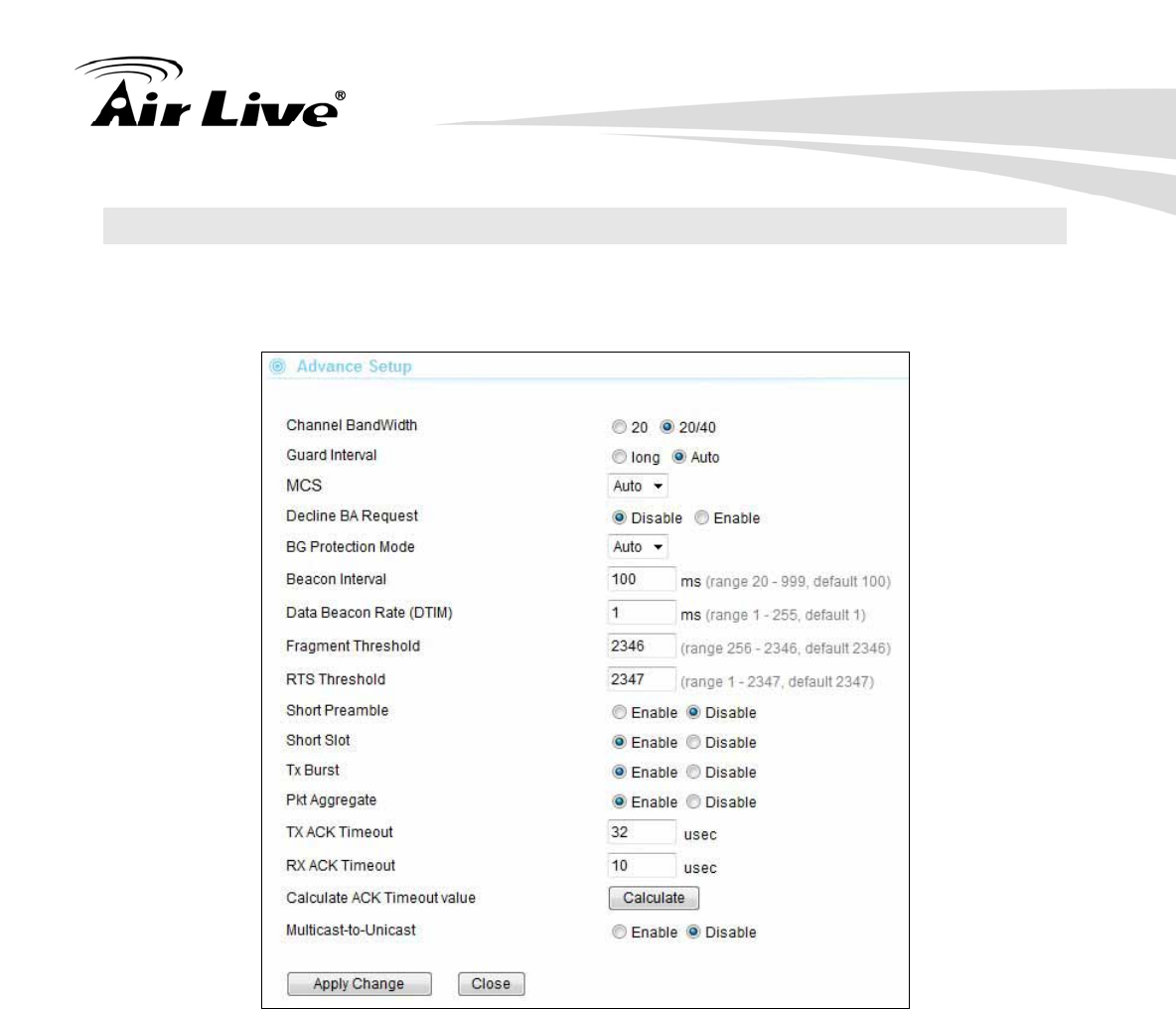
8 WDS Bridge Mode
AirLive N.Power User’s Manual 72
8.2 Wireless Settings
8.2.1 Advance Setup
Wireless Settings -> Advance Setup
Channel Width: You can choose 20MHz or 20/40MHz channel width. Choose
20MHz for compliance with laws in some countries. 40MHz offers faster performance
than 20MHz
Guard Interval: Guard interval is placed at the beginning of each transmission. It is
used to reduce the interference effect of multi-path transmissions. The use of long
Guard Interval may perform better in interference or multipath environment. However,
it can reduce the performance.
MCS (Modulation and Code Scheme): MCS level for the 11n mode. It is
recommended to leave it at Auto.
Decline BA Request: Enable this option to decline the Block ACK requests by other
devices.

8. WDS Bridge Mode
73 AirLive N.Power User’s Manual
BG Protection: The 802.11g standard includes a protection mechanism to ensure
mixed 802.11b and 802.11g operation. If there is no such kind of mechanism exists,
the two kinds of standards may mutually interfere and decrease network’s
performance..
Beacon Interval: The device broadcasts beacon frames regularly to announce its
existence. The beacon Interval specifies how often beacon frames are transmitted in
time unit of milliseconds. The default value is 100, and a valid value should be between
1 and 65,535.
Fragmentation: When the size of a unicast frame exceeds the fragmentation
threshold, it will be fragmented before the transmission. It should have a value of
256-2346 bytes, with a default of 2346. If you experience a high packet error rate,
you should slightly decrease the Fragmentation Threshold.
RTS Threshold: RTS/CTS frames are used to gain control of the medium for
transmission. Any unicast (data or control) frames larger than specified RTS threshold
must be transmitted following the RTS/CTS handshake exchange mechanism. The
RTS threshold should have a value between 256-2347 bytes, with a default of 2347. It
is recommended that this value does not deviate from the default too much.
Short Preamble: A preamble is a signal used in wireless environment to synchronize
the transmitting timing including Synchronization and Start frame delimiter. In a "noisy"
network environment, the Preamble Type should be set to Long Preamble. The Short
Preamble is intended for applications where minimum overhead and maximum
performance is desired. If in a "noisy" network environment, the performance will be
decreased.
Tx Burst and Packet Aggregate: These are the scheme used for improving the
performance of the data transmission in 11n and Turbo modes. It is recommended to
keep the settings on.
AckTimeOut: When a packet is sent out from one wireless station to the other, it will
wait for an Acknowledgement frame from the remote station. The station will only
wait for a certain amount of time; this time is called the ACK timeout. In most
conditions, please do not change the Tx and Rx Acktimeout value. The
N.Power’s default value is correct in most case.s.
8.2.2 WDS Settings
For Bridge network, it is required to enter the Wireless MAC address of all remote bridges
that is connected directly to your N.Power. The wireless MAC address is also known as
BSSID.
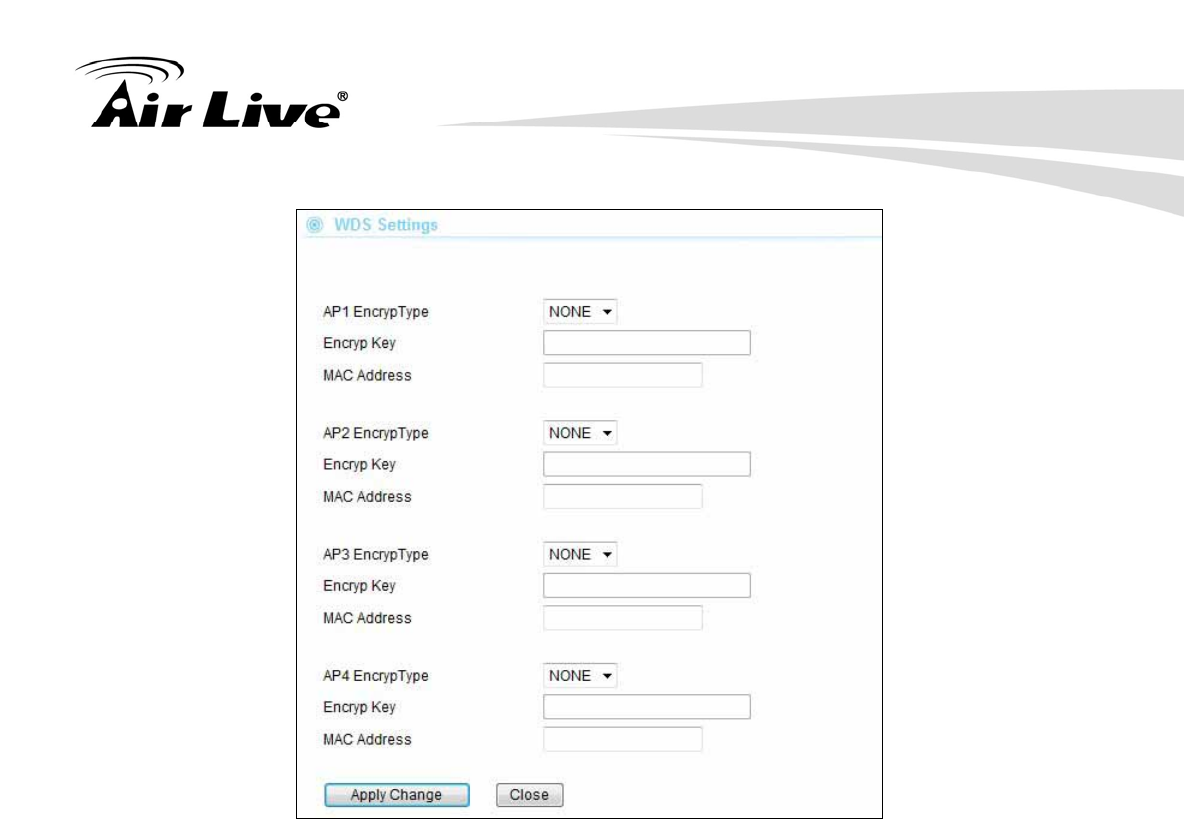
8 WDS Bridge Mode
AirLive N.Power User’s Manual 74
Encryp Type: You can use one of the following 4 encryption type.
None: No encryption is made. This is not recommended as it posts serious
security issue.
WEP: This is the most compatible type. However, it is also easier for
hackers to break. Use this only if AES or TKIP doesn’t work.
TKIP: Temporal Key Integrity Protocol, TKIP is more secured than WEP but
less secure than AES.
AES: The most secured encryption method. It is highly recommended to
use this method unless for compatibility issue.
Encryp Key: Please enter your encryption key here.
MAC Address: Please enter the Wireless MAC address or BSSID of the remote
Bridge. You can usually find it at remote Bridge’s device label.
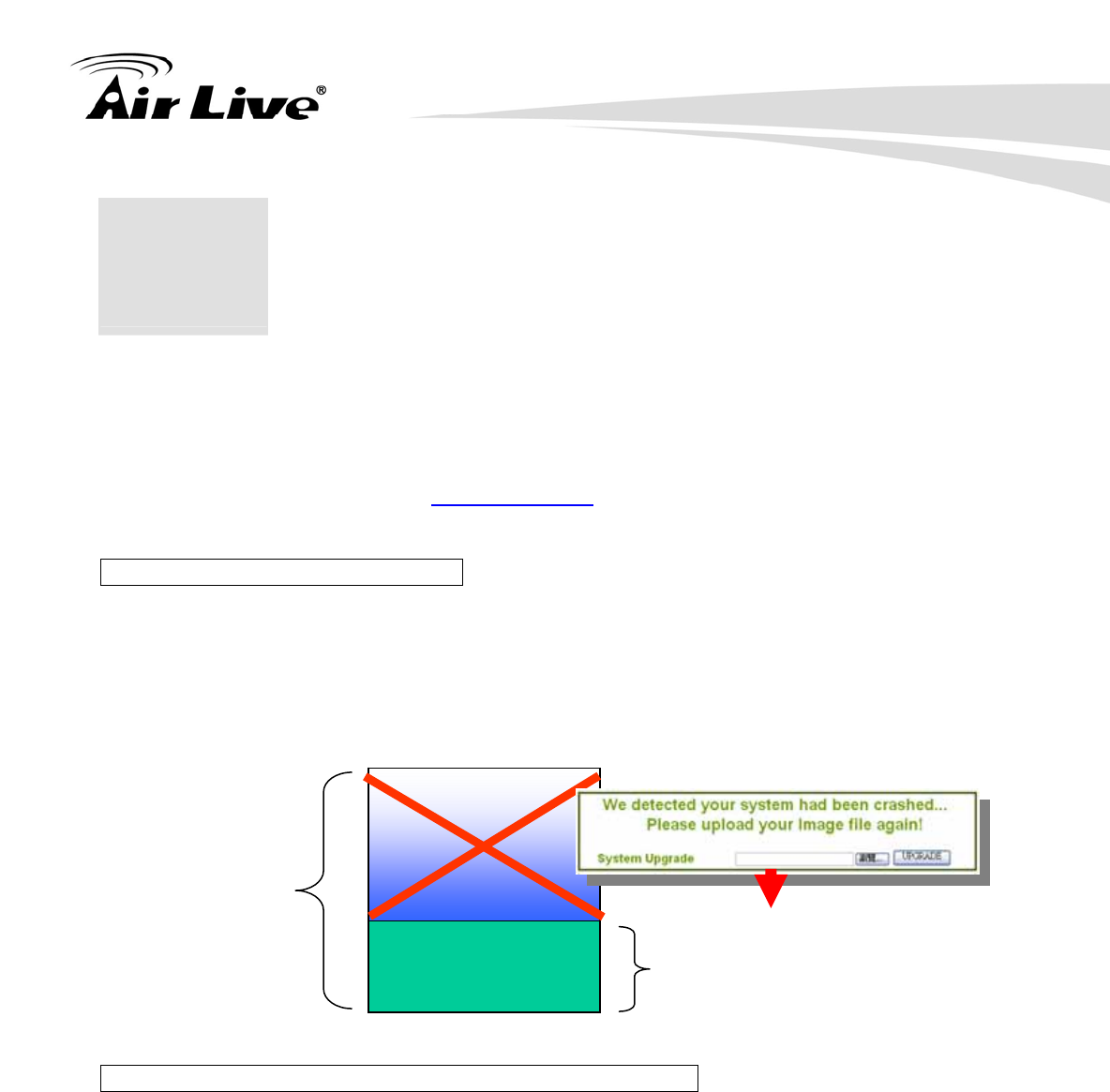
9. Emergency Firmware Recovery
75 AirLive N.Power User’s Manual
The N.Power features emergency firmware upgrade function that can restore your AP from
a firmware crashed. If you can’t access your AP anymore, please first try to restore the
setting to default by holding the RESET button (in the back) for more than 10 seconds. You
should be able to find the AP at 192.168.1.254. If you can’t find it, then please perform the
emergency upgrade. Please visit www.airlive.com->support->download and type “N.Power”
to the download page.
How Emergency Upgrade Works?
N.Power’s flash memory is divided into “firmware” and “bootloader” area. The bootloader
area is protected from writing and has a built-in emergency web server. Therefore, the AP
can be recovered from emergency web server after a firmware crash. The emergency
web server is enabled when AP is forced into emergency upgrade mode, it’s IP will be
changed to 192.168.1.254.
Procedure to Restore the AP using Emergency Upgrade
1. Please connect one of your LAN Ports (LAN1~LAN4) to your PC directly.
2. Set your PC’s IP address to 192.168.1.50
3. Before connecting the power, please press and holding the “Reset” button (in the back
of the AP). Then plug in the power. Keep press and hold the Reset button until the
LED of the selected port goes on(about 3 seconds)
9 9. Emergency Firmware
Recovery
Bootloader Area
Flash Memory
Emergency
Web Server
Firmware Area
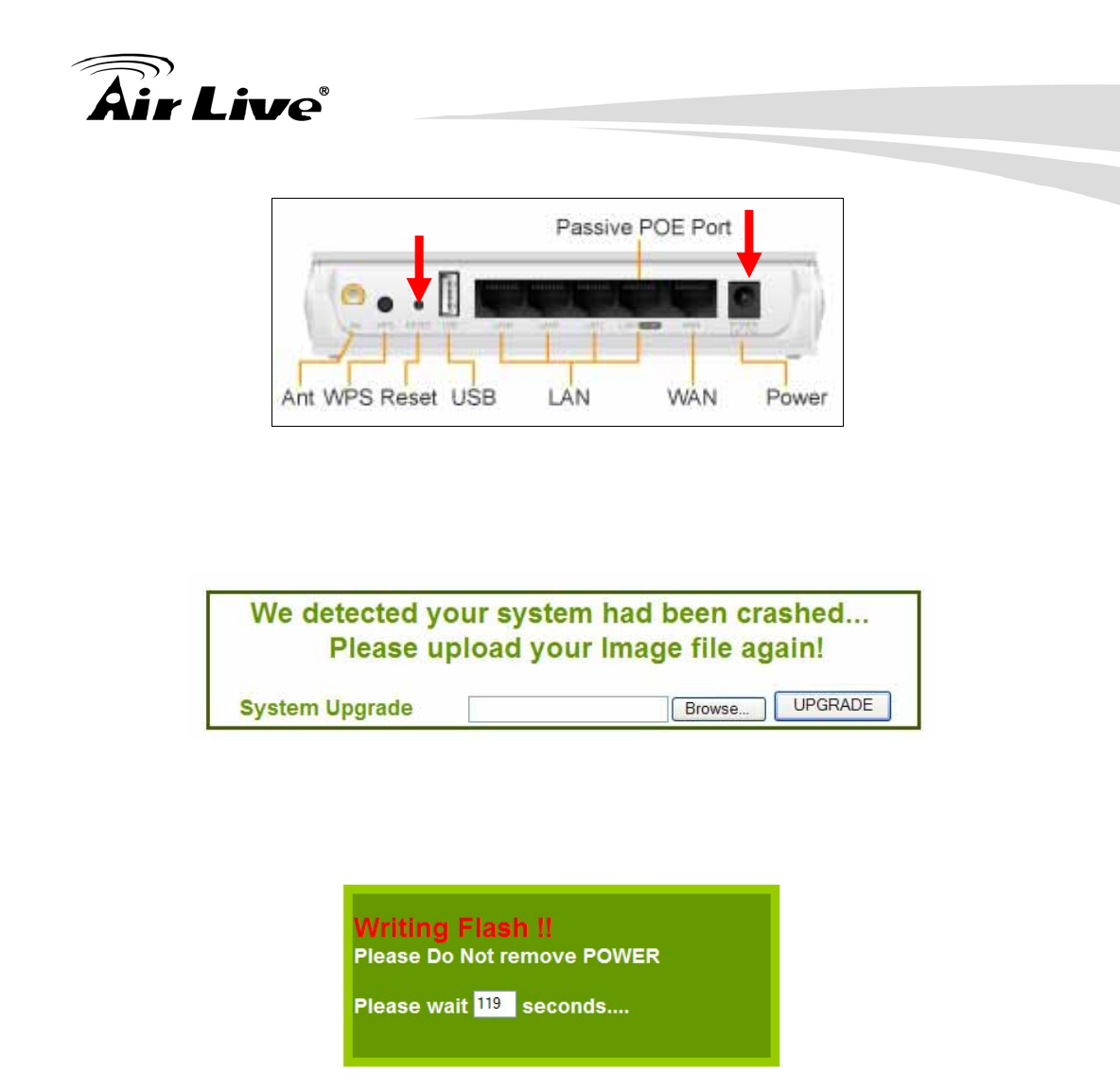
9. Emergency Firmware Recovery
AirLive N.Power User’s Manual 76
Fig 1-2: Press and hold the reset button while plugging in the power.
6. Open a browser; type “192.168.1.254” for the website address. The following screen
should show up
7. Click the “Browse” button, select and open the correct firmware file.
8. Click on “UPGRADE” button. Do not touch the AP or PC until the upgrade is
completed.
9. After upgrading, the configuration will recover from the previous settings. Please
access your device at previous IP address. If you forget what the previous IP
address is or if you can’t access the device, please push the reset button for 10
seconds to restore your AP to factory default settings. The system will reboot. Then,
you should be able to login into the normal Web UI at the default IP: 192.168.1.254.

10. Frequent Asked Questions
77 AirLive N.Power User’s Manual
In this chapter, we will address some frequent asked questions about N.Power
Question: I plug my 3G USB dongle into Air3G, but it cannot be recognized
Answer: Please go to Air3G webpage at www.airlive.com and check the USB
compatibility list. If your USB is on the compatibility list, please make sure
you plug in the USB dongle while the Air3G is powered off.
===================================================================
Question: After Emergency Upgrade, I can’t find my N.Power at 192.168.1.254
Answer: The N.Power will restore to the previous settings after successful Emergency
upgrade. Therefore, the IP address will change to the previous IP address.
If you still can’t find N.Power in previous address, please do a restore to
default and the N.Power should appear at 192.168.1.254
====================================================================
Question: When I wan to use “Site Survey” tool to connect with a AP that has no
encryption, why does the N.Power report “encryption type mismatch!” and ask
me to configure the wireless security settings?
Answer: When you press “Connect” from site survey, the N.Power will first check if the
current wireless encryption setting is correct. If not, it will ask you to modify
the setting. Therefore, if your current wireless settings has encryption and
the new AP you want to associate does not use encryption, and then the
N.Power will report the mismatch. In this case, simple select “Disable” in the
encryption field and press “Apply Change”.
====================================================================
Question: When I change my wireless operation mode, why can’t I find my AP anymore?
Answer: By Default, the DHCP server is turned on in Router mode. In other modes,
the DHCP server is turned off. If you get your IP address automatically, then
when you change from Router to AP/Client/WDS Bridge mode, your PC will
10 10. Frequent Asked
Questions

10. Frequent Asked Questions
AirLive N.Power User’s Manual 78
not be able to get IP address from DHCP server anymore. Therefore, you
should set the IP address manually.
====================================================================
Question: Where is the POE port for N.Power?
Answer: The PoE system used for N.Power is 12V Passive PoE. LAN1 is also used
as the passive PoE port.
====================================================================
Question: When I use PoE power with 3G USB dongle, why do I get unstable
performance sometimes?
Answer: Please use a 12VDC power adapter that supply more than 1.25A of current.
====================================================================
Question: When I connect my PoE switch with N.Power, why doesn’t it work?
Answer: The N.Power use a 12V Passive PoE system, it is not the same as the 48V
system used by PoE switch. As matter of fact, connect the 48V system to
the N.Power might damage the device!
====================================================================

11. Specifications
79 AirLive N.Power User’s Manual
The specification of N.Power is subject to change without notice. Please use the
information with caution.
11.1 Hardware Features
11.1.1 General Hardware Feature
Long Range Wireless-N AP Router
Up to 9 times more wireless coverage than normal powered AP/Routers
Work with 3G/3.5G/UMTS/EVDO/HSDPA USB Dongle
1 x USB 2.0 Port
Green AP power saving function
150Mbps 1T1R Wireless-b/g/n standard
12V Passive POE Port
WAN port for Broadband Internet
Router, AP, Client, Bridge, Repeater modes
Multiple SSID and Bandwidth Control
8MB Flash, 32MB SDRAM
11.1.2 Power Supply
Power Adapter Voltage : input 100~240Vac/50~60Hz , output 12V/1A
Passive PoE Port (Accept 12Vdc). Passive PoE DC Injector not included
11.1.3 Dimension and Weight
Dimension: 154 x 130 x 316 mm
AP Unit Weight(Approximate): 280g
Package Weight(Approximate): 686g
11 11. Specifications

11. Specifications
AirLive N.Power User’s Manual 80
11.2 Radio Specifications
11.2.1 Frequency Band
USA (FCC) 11 Channels: 2.412GHz~2.462GHz
Europe (ETSI) 13 Channels : 2.412GHz~2.472GHz
South America: 11 Channels: 2.412GHz~2.462GHz
South America: 14 Channels: 2.412GHz~2.477GHz
11.2.2 Rate and Modulation
Data Rate:
802.11n
20 MHz BW(LGI): 65, 58.5, 52, 39, 26, 19.5, 13, 6.5
40 MHz BW(LGI): 135, 121.5, 108, 81, 54, 40.5, 27, 13.5
20 MHz BW(SGI): 72.2, 65, 57.8, 43.3, 28.9, 21.7, 14.4, 7.2
40 MHz BW(SGI): 150, 135, 120, 90, 60, 45, 30, 15
802.11g: 54, 48, 36, 24, 18, 12, 9 and 6 Mbps
802.11b: 11, 5.5, 2 and 1 Mbps
Modulation
802.11n
20 MHz BW(LGI): 65, 58.5, 52, 39, 26, 19.5, 13, 6.5
40 MHz BW(LGI): 135, 121.5, 108, 81, 54, 40.5, 27, 13.5
20 MHz BW(SGI): 72.2, 65, 57.8, 43.3, 28.9, 21.7, 14.4, 7.2
40 MHz BW(SGI): 150, 135, 120, 90, 60, 45, 30, 15
802.11g: 54, 48, 36, 24, 18, 12, 9 and 6 Mbps
802.11b: 11, 5.5, 2 and 1 Mbps
11.2.3 TX Output Power
FCC (The United States)
802.11b : About 23dBm max
802.11g : About 23dBm max
802.11n : About 22dBm max

11. Specifications
81 AirLive N.Power User’s Manual
11.2.4 Receiver Sensitivity
802.11b 11Mbps ≦ -90dBm
802.11g 54Mbps ≦ -73dBm
802.11n HT20 MCS7 ≦ -70dBm
802.11n HT40 MCS7 ≦ -67dBm
11.2.5 Supported WLAN Mode
Router Mode
AP Mode
Client Mode
WDS Bridge Mode
WDS Repeater Mode
11.3 Software Features
Management Interface
Web HTTP
Advance Functions
Setup Wizard
Site Survey
3G service provider list
WAN/3G Connection Backup
Bandwidth Control / Traffic Shaping
Associated Client Table
Wi-Fi, WPA compatible interoperability
WPA with PSK/TKIP/AES support ,WPA2 support
Virtual Server Function
Privacy Separator support
Hide SSID Support
Support adjustable output power
ACK Timeout Adjustment
Bootloader Protection and Emergency Firmware Upload Code
Radius Supported
Static DHCP entries

11. Specifications
AirLive N.Power User’s Manual 82
Firmware upgrade and configuration backup via Web

12. Wireless Network Glossary
83 AirLive N.Power User’s Manual
The wireless network glossary contains explanation or information about common terms
used in wireless networking products. Some of information in this glossary might be
outdated, please use with caution.
802.3ad
802.3ad is an IEEE standard for bonding or aggregating multiple Ethernet ports into one
virtual port (also known as trunking) to increase the bandwidth.
802.3af
This is the PoE (Power over Ethernet) standard by IEEE committee. 803.af uses 48V
POE standard that can deliver up to 100 meter distance over Ethernet cable.
802.11b
International standard for wireless networking that operates in the 2.4 GHz frequency band
(2.4 GHz to 2.4835 GHz) and provides a throughput up to 11 Mbps.
802.1d STP
Spanning Tree Protocol. It is an algorithm to prevent network from forming. The STP
protocol allows net work to provide a redundant link in the event of a link failure. It is
advised to turn on this option for multi-link bridge network.
802.11d
Also known as “Global Roaming”. 802.11d is a standard for use in countries where
systems using other standards in the 802.11 family are not allowed to operate.
802.11e
The IEEE QoS standard for prioritizing traffic of the VoIP and multimedia applications.
The WMM is based on a subset of the 802.11e.
12 12. Wireless Network
Glossary

12. Wireless Network Glossary
AirLive N.Power User’s Manual 84
802.11g
A standard provides a throughput up to 54 Mbps using OFDM technology. It also
operates in the 2.4 GHz frequency band as 802.11b. 802.11g devices are backward
compatible with 802.11b devices.
802.11i
The IEEE standard for wireless security. 802.11i standard includes TKIP, CCMP, and
AES encryption to improve wireless security. It is also know as WPA2.
802.1x
802.1x is a security standard for wired and wireless LANs. In the 802.1x parlance, there are
usually supplicants (client), authenticator (switch or AP), and authentication server (radius
server) in the network. When a supplicants request a service, the authenticator will pass
the request and wait for the authentication server to grant access and register accounting.
The 802.1x is the most widely used method of authentication by WISP.
Adhoc
A Peer-to-Peer wireless network. An Adhoc wireless network do not use wireless AP or
router as the central hub of the network. Instead, wireless client are connected directly to
each other. The disadvantage of Adhoc network is the lack of wired interface to Internet
connections. It is not recommended for network more than 2 nodes.
Access Point (AP)
The central hub of a wireless LAN network. Access Points have one or more Ethernet
ports that can connect devices (such as Internet connection) for sharing. Multi-function
Access Point can also function as an Ethernet client, wireless bridge, or repeat signals from
other AP. Access Points typically have more wireless functions comparing to wireless
routers.
ACK Timeout
Acknowledgement Timeout Windows. When a packet is sent out from one wireless station
to the other, it will waits for an Acknowledgement frame from the remote station. The
station will only wait for a certain amount of time; this time is called the ACK timeout. If the
ACK is NOT received within that timeout period then the packet will be re-transmitted
resulting in reduced throughput. If the ACK setting is too high then throughput will be lost
due to waiting for the Ack Window to timeout on lost packets. If the ACK setting is too low

12. Wireless Network Glossary
85 AirLive N.Power User’s Manual
then the ACK window will have expired and the returning packet will be dropped, greatly
lowering throughput. By having the ability to adjust the ACK setting we can effectively
optimize the throughput over long distance links. This is especially true for 802.11a and
802.11g networks. Setting the correct ACK timeout value need to consider 3 factors:
distance, AP response time, and interference. The N.Power provides ACK adjustment
capability in form of either distance or direct input. When you enter the distance
parameter, the N.Power will automatically calculate the correct ACK timeout value.
Bandwidth Management (Traffic Control)
Bandwidth Management controls the transmission speed of a port, user, IP address, and
application. Router can use bandwidth control to limit the Internet connection speed of
individual IP or Application. It can also guarantee the speed of certain special application
or privileged IP address - a crucial feature of QoS (Quality of Service) function.
Bootloader
Bootloader is the under layering program that will start at the power-up before the device
loads firmware. It is similar to BIOS on a personal computer. When a firmware crashed,
you might be able to recover your device from bootloader.
Bridge
A product that connects 2 different networks that uses the same protocol. Wireless
bridges are commonly used to link network across remote buildings. For wireless
application, there are 2 types of Bridges. WDS Bridge can be used in Point-to-Point or
Point-to-Multipoint topology. Bridge Infrastructure works with AP mode to form a star
topology.
Cable and Connector Loss: During wireless design and deployment, it is important to
factor in the cable and connector loss. Cable and connector loss will reduce the output
power and receiver sensitivity of the radio at connector end. The longer the cable length is,
the more the cable loss. Cable loss should be subtracted from the total output power
during distance calculation. For example, if the cable and connector loss is 3dBm and the
output power is 20dBm; the output power at the cable end is only 17dBm.
Client
Client means a network device or utility that receives service from host or server. A client
device means end user device such as wireless cards or wireless CPE.

12. Wireless Network Glossary
AirLive N.Power User’s Manual 86
CPE Devices
CPE stands for Customer Premises Equipment. A CPE is a device installed on the end
user's side to receive network services. For example, on an ADSL network, the ADSL
modem/router on the subscriber's home is the CPE device. Wireless CPE means a
complete Wireless (usually an AP with built-in Antenna) that receives wireless broadband
access from the WISP. The opposite of CPE is CO.
CTS
Clear To Send. A signal sent by a device to indicate that it is ready to receive data.
DDNS
Dynamic Domain Name System. An algorithm that allows the use of dynamic IP address
for hosting Internet Server. A DDNS service provides each user account with a domain
name. A router with DDNS capability has a built-in DDNS client that updates the IP
address information to DDNS service provider whenever there is a change. Therefore,
users can build website or other Internet servers even if they don't have fixed IP
connection.
DHCP
Dynamic Hosting Configuration Protocol. A protocol that enables a server to dynamically
assign IP addresses. When DHCP is used, whenever a computer logs onto the network, it
automatically gets an IP address assigned to it by DHCP server. A DHCP server can
either be a designated PC on the network or another network device, such as a router.
DMZ
Demilitarized Zone. When a router opens a DMZ port to an internal network device, it opens
all the TCP/UDP service ports to this particular device. The feature is used commonly for
setting up H.323 VoIP or Multi-Media servers.
DNS
A program that translates URLs to IP addresses by accessing a database maintained on a
collection of Internet servers.
Domain Name
The unique name that identifies an Internet site. Domain Names always have 2 or more

12. Wireless Network Glossary
87 AirLive N.Power User’s Manual
parts, separated by dots. In www.airlive.com, the "airlive.com" is the doman name.
DoS Attack
Denial of Service. A type of network attack that floods the network with useless traffic.
Many DoS attacks, such as the Ping of Death and Teardrop attacks, exploit limitations in
the TCP/IP protocols.
Encryption
Encoding data to prevent it from being read by unauthorized people. The common
wireless encryption schemes are WEP, WPA, and WPA2.
ESSID (SSID)
The identification name of an 802.11 wireless network. Since wireless network has no
physical boundary liked wired Ethernet network, wireless LAN needs an identifier to
distinguish one network from the other. Wireless clients must know the SSID in order to
associate with a WLAN network. Hide SSID feature disable SSID broadcast,
so users must know the correct SSID in order to join a wireless network.
Firewall
A system that secures a network and prevents access by unauthorized users. Firewalls can
be software, router, or gateway. Firewalls can prevent unrestricted access into a network,
as well as restricting data from flowing out of a network.
Firmware
The program that runs inside embedded device such as router or AP. Many network
devices are firmware upgradeable through web interface or utility program.
FTP
File Transfer Protocol. A standard protocol for sending files between computers over a
TCP/IP network and the Internet.
Fragment Threshold
Frame Size larger than this will be divided into smaller fragment. If there are interferences
in your area, lower this value can improve the performance. If there are not, keep this

12. Wireless Network Glossary
AirLive N.Power User’s Manual 88
parameter at higher value. The default size is 2346. You can try 1500, 1000, or 500
when there are interference around your network.
Gateway
In the global Internet network, the gateways are core routers that connect networks in
different IP subnet together. In a LAN environment with an IP sharing router, the gateway
is the router. In an office environment, gateway typically is a multi-function device that
integrates NAT, firewall, bandwidth management, and other security functions.
Hotspot
A place where you can access Wi-Fi service. The term hotspot has two meanings in
wireless deployment. One is the wireless infrastructure deployment, the other is the
Internet access billing system. In a hotspot system, a service provider typically need an
authentication and account system for billing purposes, and a wireless AP network to
provide access for customers.
IGMP Snooping
Internet Group Management Protocol (IGMP) is a Layer 3 protocol to report IP multicast
memberships to neighboring multicast switches and routers. IGMP snooping is a feature
that allows an Ethernet switch to "listen in" on the IGMP conversation between hosts and
routers. A switch support IGMP snooping has the possibility to avoid multicast traffic being
treated as broadcast traffic; therefore, reducing the overall traffic on the network.
Infrastructure Mode
A wireless network that is built around one or more access points to provide wireless clients
access to wired LAN / Internet service. The opposite of Infrastructure mode is Adhoc
mode.
IP address
IP (Internet Protocol) is a layer-3 network protocol that is the basis of all Internet
communication. An IP address is 32-bit number that identifies each sender or receiver of
information that is sent across the Internet. An IP address has two parts: an identifier of a
particular network on the Internet and an identifier of the particular device (which can be a
server or a workstation) within that network. The new IPv6 specification supports 128-bit
IP address format.

12. Wireless Network Glossary
89 AirLive N.Power User’s Manual
IPsec
IP Security. A set of protocols developed by the IETF to support secure exchange of
packets at the IP layer. IPsec has been deployed widely to implement Virtual Private
Networks (VPNs). IPsec supports two encryption modes: Transport and Tunnel.
Transport mode encrypts only the data of each packet, but leaves the header untouched.
The more secure Tunnel mode encrypts both the header and the payload. On the receiving
side, an IPSec-compliant device decrypts each packet.
LACP (802.3ad) Trunking
The 802.3ad Link Aggregation standard defines how to combine the several Ethernet ports
into one high-bandwidth port to increase the transmission speed. It is also known as port
trunking. Both devices must set the trunking feature to work.
MAC
Media Access Control. MAC address provides layer-2 identification for Networking Devices.
Each Ethernet device has its own unique address. The first 6 digits are unique for each
manufacturer. When a network device have MAC access control feature, only the devices
with the approved MAC address can connect with the network.
Mbps
Megabits Per Second. One million bits per second; a unit of measurement for data
transmission
MESH
Mesh is an outdoor wireless technology that uses Spanning Tree Protocol (STP) and
Wireless Distribution system to achieve self-forming, self-healing, and self-configuring
outdoor network. MESH network are able to take the shortest path to a destination that
does not have to be in the line of site.
MIMO
Multi In Multi Out. A Smart Antenna technology designed to increase the coverage and
performance of a WLAN network. In a MIMO device, 2 or more antennas are used to
increase the receiver sensitivity and to focus available power at intended Rx.

12. Wireless Network Glossary
AirLive N.Power User’s Manual 90
NAT
Network Address Translation. A network algorithm used by Routers to enables several
PCs to share single IP address provided by the ISP. The IP that a router gets from the
ISP side is called Real IP, the IP assigned to PC under the NAT environment is called
Private IP.
Node
A network connection end point, typically a computer.
Packet
A unit of data sent over a network.
Passphrase
Used much like a password, a passphrase simplifies the WEP encryption process by
automatically generating the WEP encryption keys for the company products.
POE
Power over Ethernet. A standard to deliver both power and data through one single
Ethernet cable (UTP/STP). It allows network device to be installed far away from power
ource. A POE system typically compose of 2 main component: DC Injector (Base Unit)
and Splitter(Terminal Unit). The DC injector combines the power and data, and the splitter
separates the data and power back. A PoE Access Point or CPE has the splitter built-in to
the device. The IEEE 802.3af is a POE spec that uses 48 volt to deliver power up to 100
meter distance.
Port
This word has 2 different meaning for networking.
z The hardware connection point on a computer or networking device used for plugging
in a cable or an adapter.
z The virtual connection point through which a computer uses a specific application on a
server.
PPPoE
Point-to- Point Protocol over Ethernet. PPPoE relies on two widely accepted standards:
PPP and Ethernet. PPPoE is a specification for connecting the users on an Ethernet to the

12. Wireless Network Glossary
91 AirLive N.Power User’s Manual
Internet through a common broadband medium, such as a single DSL line, wireless device
or cable modem.
PPTP
Point-to-Point Tunneling Protocol: A VPN protocol developed by PPTP Forum. With
PPTP, users can dial in to their corporate network via the Internet. If users require data
encryption when using the Windows PPTP client, the remote VPN server must support
MPPE (Microsoft Point-To-Point Encryption Protocol) encryption. PPTP is also used by
some ISP for user authentication, particularly when pairing with legacy Alcatel / Thomson
ADSL modem.
Preamble Type
Preamble are sent with each wireless packet transmit for transmission status. Use the
long preamble type for better compatibility. Use the short preamble type for better
performance
Rate Control
Ethernet switches' function to control the upstream and downstream speed of an individual
port. Rate Control management uses "Flow Control" to limit the speed of a port.
Therefore, the Ethernet adapter must also have the flow control enabled. One way to
force the adapter's flow control on is to set a port to half-duplex mode.
RADIUS
Remote Authentication Dial-In User Service. An authentication and accounting system
used by many Internet Service Providers (ISPs). When you dial in to the ISP, you must
enter your username and password. This information is passed to a RADIUS server, which
checks that the information is correct, and then authorizes access to the ISP system.
Radius typically uses port 1812 and port 1813 for authentication and accounting port.
Though not an official standard, the RADIUS specification is maintained by a working group
of the IETF.
Receiver Sensitivity
Receiver sensitivity means how sensitive is the radio for receiving signal. In general; the
slower the transmission speed, the more sensitive the radio is. The unit for Receiver
Sensitivity is in dB; the lower the absolute value is, the higher the signal strength. For
example, -50dB is higher than -80dB.

12. Wireless Network Glossary
AirLive N.Power User’s Manual 92
RJ-45
Standard connectors for Twisted Pair copper cable used in Ethernet networks. Although
they look similar to standard RJ-11 telephone connectors, RJ-45 connectors can have up to
eight wires, whereas telephone connectors have only four.
Router
An IP sharing router is a device that allows multiple PCs to share one single broadband
connection using NAT technology. A wireless router is a device that combines the
functions of wireless Access Point and the IP sharing router.
SIGNAL STRENGTH
Receiver Sensitivity Index. SIGNAL STRENGTH is a value to show the Receiver
Sensitivity of the remote wireless device. In general, remote APs with stronger signal will
display higher SIGNAL STRENGTH values. For SIGNAL STRENGTH value, the smaller
the absolute value is, the stronger the signal. For example, “-50db” has stronger signal
than “-80dB”. For outdoor connection, signal stronger than -60dB is considered as a
good connection.
RTS
Request To Send. A packet sent when a computer has data to transmit. The computer will
wait for a CTS (Clear To Send) message before sending data.
RTS Threshold
RTS (Request to Send). The RTS/CTS(clear to send) packet will be send before a frame
if the packet frame is larger than this value. Lower this value can improve the
performance if there are many clients in your network. You can try 1500, 1000 or 500
when there are many clients in your AP’s network.
SNMP
Simple Network Management Protocol. A set of protocols for managing complex
networks. The SNMP network contains 3 key elements: managed devices, agents, and
network-management systems (NMSs). Managed devices are network devices that
content SNMP agents. SNMP agents are programs that reside SNMP capable device's
firmware to provide SNMP configuration service. The NMS typically is a PC based
software such as HP Openview that can view and manage SNMP network device remotely.

12. Wireless Network Glossary
93 AirLive N.Power User’s Manual
SSH
Developed by SSH Communications Security Ltd., Secure Shell is a program to log into
another computer over a network, to execute commands in a remote machine, and to move
files from one machine to another. It provides strong authentication and secure
communications over insecure channels. It is a replacement for rlogin, rsh, rcp, and rdist.
SSL
Secure Sockets Layer. It is a popular encryption scheme used by many online retail and
banking sites to protect the financial integrity of transactions. When an SSL session
begins, the server sends its public key to the browser. The browser then sends a randomly
generated secret key back to the server in order to have a secret key exchange for that
session. SSL VPN is also known as Web VPN. The HTTPS and SSH management
interface use SSL for data encryption.
Subnet Mask
An address code mask that determines the size of the network. An IP subnet are
determined by performing a BIT-wise AND operation between the IP address and the
subnet mask. By changing the subnet mask, you can change the scope and size of a
network.
Subnetwork or Subnet
Found in larger networks, these smaller networks are used to simplify addressing between
numerous computers. Subnets connect to the central network through a router, hub or
gateway. Each individual wireless LAN will probably use the same subnet for all the local
computers it talks to.
TCP
A layer-4 protocol used along with the IP to send data between computers over the Internet.
While IP takes care of handling the actual delivery of the data, TCP takes care of keeping
track of the packets that a message is divided into for efficient routing through
the Internet.
TX Output Power
Transmit Output Power. The TX output power means the transmission output power of
the radio. Normally, the TX output power level limit for 2.4GHz 11g/b is 23dBm at the
antenna end. The output power limit for 5GHz 802.11a is 22dBm at the antenna end.

12. Wireless Network Glossary
AirLive N.Power User’s Manual 94
UDP
User Datagram Protocol. A layer-4 network protocol for transmitting data that does not
require acknowledgement from the recipient of the data.
Upgrade
To replace existing software or firmware with a newer version.
Upload
To send a file to the Internet or network device.
URL
Uniform Resource Locator. The address of a file located on the Internet.
VPN
Virtual Private Network. A type of technology designed to increase the security of
information transferred over the Internet. VPN creates a private encrypted tunnel from the
end user's computer, through the local wireless network, through the Internet, all the way to
the corporate network.
WAN
Wide Area Network. A communication system of connecting PCs and other computing
devices across a large local, regional, national or international geographic area. A WAN
port on the network device means the port (or wireless connection) that is connected to the
Internet side of the network topology.
WEP
Wired Equivalent Privacy. A wireless encryption protocol. WEP is available in 40-bit (64-bit),
108-bit (128-bit) or 152-bit (Atheros proprietary) encryption modes.
Wi-Fi
Wireless Fidelity. An interoperability certification for wireless local area network (LAN)
products based on the IEEE 802.11 standards. The governing body for Wi-Fi is called
Wi-Fi Alliance (also known as WECA).

12. Wireless Network Glossary
95 AirLive N.Power User’s Manual
WiMAX
Worldwide Interoperability for Microwave Access. A Wireless Metropolitan Network
technology that complies with IEEE 802.16 and ETSI Hiperman standards. The orginal
802.16 standard call for operating frequency of 10 to 66Ghz spectrum. The 802.16a
amendment extends the original standard into spectrum between 2 and 11 Ghz. 802.16d
increase data rates to between 40 and 70 Mbps/s and add support for MIMO antennas,
QoS, and multiple polling technologies. 802.16e adds mobility features, narrower
bandwidth (a max of 5 mhz), slower speed and smaller antennas. Mobility is allowed up to
40 mph.
WDS
Wireless Distribution System. WDS defines how multiple wireless Access Point or
Wireless Router can connect together to form one single wireless network without using
wired uplinks. WDS associate each other by MAC address, each device
WLAN
Wireless Local Area Network. A type of local-area network that uses high-frequency radio
waves rather than wires to communicate between nodes. The most popular standard for
WLAN is the 802.11 standards.
WMM
Wi-Fi Multimedia (WMM) is a standard to prioritize traffic for multimedia applications. The
WMM prioritize traffic\ on Voice-over-IP (VoIP), audio, video, and streaming media as well
as traditional IP data over the AP.
WMS
Wireless Management System. An utility program to manage multiple wireless
AP/Bridges.
WPA
Wi-Fi Protected Access. It is an encryption standard proposed by WiFi for advance
protection by utilizing a password key (TKIP) or certificate. It is more secure than WEP
encryption. The WPA-PSK utilizes pre-share key for encryption/authentication.

12. Wireless Network Glossary
AirLive N.Power User’s Manual 96
WPA2
Wi-Fi Protected Access 2. WPA2 is also known as 802.11i. It improves on the WPA
security with CCMP and AES encryption. The WPA2 is backward compatible with WPA.
WPA2-PSK utilizes pre-share key for encryption/authentication.